Exodus: Post-Apocalyptic Roleplaying by Fossilized Rappy
Original Intellectual Property, Do Not Steal
Original SA postWell, I'm fairly sure that I won't be able to compete with libertarian space furry cyborgs, but I decided on what I was going to cover next and I'm sticking to it.
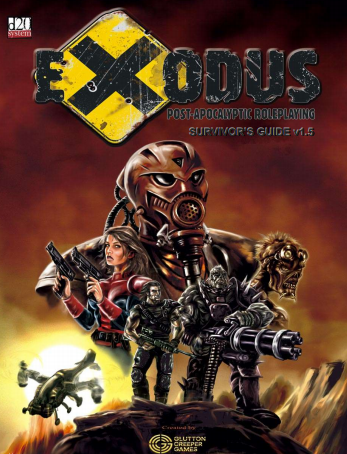
Introduction to the Overview
Licensing...Licensing Never Changes
In the early to mid 2000s, d20 systems like Dungeons & Dragons 3E and d20 Modern were very much the new hotness. Unsurprisingly, the new hotness attracted those with dollar signs in their eyes to engage in various license opportunities, whose quality varied from good to very much the opposite. D20 versions of everything from Conan the Barbarian to Star Wars and Star Trek cropped up across the board. This practice isn't unique to the d20 system, of course: Unisystem had an Army of Darkness game, Cortex has had varying products under its system from Supernatural to Firefly, and GURPS has had everything from Discworld to webcomics licensed under its name. Still, the point has to be made to establish the atmosphere that our comedic drama takes place in.
The first player in this tale is Interplay Entertainment. The company behind games such as Wasteland and Clay Fighter, Interplay was facing the threat of bankruptcy for the second time in its life during 2006. In an attempt to keep afloat, the license to one of the company's popular post-apocalyptic series, Fallout, was licensed out to the other two players in this story: Bethesda Softworks and Glutton Creeper Games. Bethesda was given the rights to create two Fallout games two years earlier, and Glutton Creeper Games was granted the license in order to create a d20 Modern Fallout RPG.
Roll forward to 2007, and the Fallout brand has been completely turned over to Bethesda as Interplay tries to escape its second time facing bankruptcy. Bethesda decides that the best course of action surrounding the hanging thread of the d20 Fallout RPG is to order a cease and desist to Glutton Creeper Games, threatening legal action due to purported damages to the Fallout brand were the d20 Fallout RPG and Fallout 3 to both come out. I'm not a lawyer, so I won't pretend to know whether or not any of the legal actions that transpired between the two were logical or simply two groups hashing it out. What I do know is the end results of this whole kerfuffle.
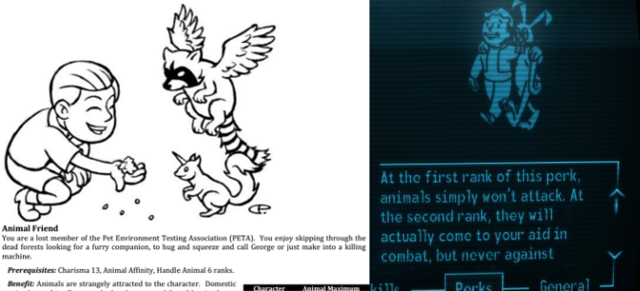
Lying, Game Professional Style
Later in 2007, Glutton Creeper Games produced a d20 Modern book entitled
Exodus: Post-Apocalyptic Roleplaying
. The setting is the post-apocalyptic American Southwest 32 years after the
Great
Last War between the United States and communist China left everything in radiation-baked ruins. It's a harsh land where only the strongest survive in the face of dangers such as the brutish
Super
Trans-Genetic Mutants, technology obsessed
Brotherhood of
Steel Disciples, and the terrifyingly strong genetically engineered war lizards known as
death
meatclaws.
If you couldn't guess, Exodus: Post-Apocalyptic Roleplaying is an exercise in just how much you can get away with treading the line, and somehow it manages to succeed. Rather than undergoing a metamorphosis from a caterpillar into a butterfly during Glutton Creeper's loss of the Fallout license, what instead happened was that the caterpillar glued on some cardboard wings and donned a mask with "NOT A CATERPILLAR" crudely scrawled on it in crayon. I almost dissuaded myself from reviewing Exodus about a year back because I wasn't sure there was enough material to have any words beyond that it was a mediocre d20 Modern setting book with some odd rules choices, but then I reread it and it hit me that there is such a low effort to mask what the product once was that there is even a prestige class to replicate a single unique Fallout NPC! Hell, there are even some things that are straight up still using Fallout names.
Hopefully, this look at Exodus will help share the wonderment of flipping through it and seeing just how brazen Glutton Creeper Games was when it made this product. As the "core" material is split up into a player's guide, GM guide, and bestiary just like a certain popular roleplaying game, we'll be looking at the player's guide (entitled the "Survivor's Guide") first. For the sake of brevity and avoiding redundancy, I'll be skipping over anything that is a reprint of material that is standard to the System Reference Document (d20 in general or d20 Modern in particular), beyond maybe posting some dumb or amusing image of "Rad Boy" associated with said rules, and focus mainly on two things: trying to fairly cover new rules the game provides and being boggled by how much crap somehow got past Bethesda's radar.
Backstory and Character Creation
Original SA postGlazius posted:
It's been a while since I've played it, but that's actually an available perk for Ghoul troopers in Fallout Tactics: Brotherhood of Steel. The idea was that you'd get fruit regularly from the tree but the implementation was bugged.

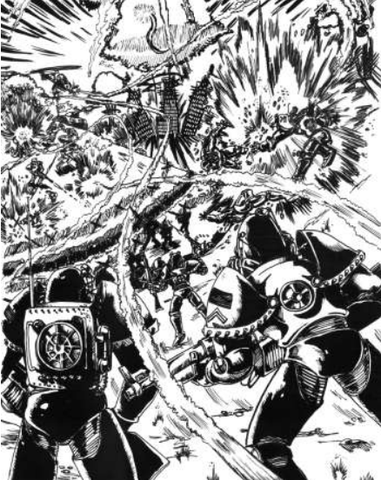
Survivor's Guide Introduction
The introductory chapter of the Exodus Survivor's Guide is split into two segments: an overview of the setting's backstory, and “the Basics of d20” that tells you what the six ubiquitous ability scores and sizes of dice are. Since the latter needs no real explanation, the former is the obvious avenue to start with.
The background of Exodus is perhaps the point where it divorces itself from Fallout the most. While it retains the divergence of history around World War II and the ultimate war being between China and the United States, Exodus adds a few extra players into the nuclear game that would not have really been part of the whole Cold War theme of Fallout 1 and 2. The biggest is that Exodus is a world where 9/11 and the Iraqi occupation occurred, and the countries of the Middle East end up being thrown into the mix. While China and North Korea attack Russia, Japan, and Alaska, Iran nukes Tel Aviv and most of Europe. This is followed by sudden Islamic armies “from Algeria to Pakistan” all rising up in unison to create some convoluted war hivemind that is in turn nuked by the United States. The world ends on December 12, 2012, thanks to the escalating war.
Humanity survives thanks to the vaults (or shelters, or Freeholds: the name varies across the books) of Project Freehold. Created in the 60s by the Army with the supervision of a group known as Rad-Tek, the vaults also happen to be where the origin of the setting name comes into play.
“Never heard that line before” posted:
The sky darkened and sirens sounded as the children of god fled into underground shelters, built by man as an escape, an Exodus, from his own destruction decades ago. Twenty years later, when the shelters opened, the survivors resurfaced to find a new world: one of desolation, one or survival, one with the same goals as the old world for...war never changes...
Long story short: in the time between the vaults closing and their doors unlocking, those who managed to survive in the world above became the post-apocalyptic menagerie of raiders, slavers, cults, old world-coveting technophiles, and idealistic philanthropists looking toward a better future. Beyond the vaults being opened in 2032, it's not really considered important what happened between the vaults closing and the setting's present of 2044. Not important enough to note in the intro, at least.
Chapter 1: Character Creation
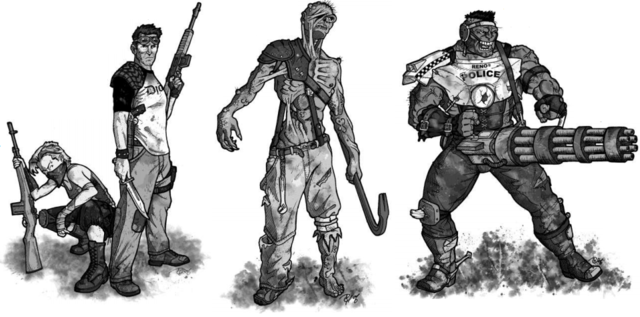
Playable Races
There are three playable races in the Exodus Survivor's Guide. One is the omnipresent thing that is reading this very sentence, and the other two are other familiar faces.
-
Human:
What is there to even say about humans in a setting ostensibly based on an alteration of the real world? They're here, they're varied, and they have the same benefits of extra skill points and a second starting feat as in most d20 system games.
-
Ghul:
Corpse-like mutant humans that were exposed to an ungodly amount of radiation, resulting in their rather startling forms. Due to having been around for a long time thanks to being radiation-fueled mutants, they tend to be well-versed in old world technology, coldly neutral, and wary of "smoothskins" (yes, Exodus kept that particular fantasy epithet) who might be up to something stupid yet again. Mechanically, ghuls are not going to be winning any marathons or fistfights: ability score modifiers of +2 to Wisdom but -2 to Strength and Dexterity combined with 20 foot move speed is a pretty notable handicap on that front, and they instead focus on durability and versatility as their benefits. On the durability side, ghuls are completely immune to the effects of radiation, a +2 to Fortitude and Will saves, and an average lifespan of 300 years. Versatility comes in a secondary free bonus feat like a human and the ability to make either Computer Use, Craft (Electronic, Mechanical, or Structural), Knowledge (Engineering, History, or Technology), or Repair a permanent class skill. Your skilled nature is offset by the fact that you gain an extra bonus feat every four levels, rather than every three levels like humans or Trans-Genetic Mutants. The race's name also happens to be listed as product identity for the setting, by the way, in spite of simply being the traditional Arabic spelling of ghoul.
- Trans-Genetic Mutant: 7 or 8 foot tall muscular brutes with green, gray, or yellow skin, the trans-genetic mutants were the results of military experimentation in California, New Mexico, and Utah before the Great War, and now terrorize the wasteland as part of the Mutant Army. Being the Super Mutant analogues, it should be no surprise that Trans-Genetic Mutants have a +4 to Strength and +2 to Constitution that is contrasted by a -2 across all three mental ability scores. These ability scores are backed up with the powerful build special quality (count as size Large for things like grappling or wielding particularly sizable weapons), damage reduction 3 against all physical damage types, a +4 to saves against disease and radiation, an immunity to Low or lower ranks of radiation, and a bonus feat that must be selected from various physical combat and endurance-related feats such as Brawl and Run. Really, other than being mentally deficient, the only downside to being a TGM is that you suffer a -4 to attack rolls with Small or smaller weapons, and I doubt many mutants are weeping about their shitty pistol skills when they can haul around Gatling guns.
Backgrounds
Sort of a weird hybrid of race and occupation, potentially taking traits from both such as ability score modifiers or class skills (of which you just gain a full list rather than having to select one to three like with an occupation), backgrounds are selected alongside both of those character features at level 1. These backgrounds are meant to be reflect a character's cultural origin, but a fair number of them feel like they should just be an available occupation instead of their own thing. Either way, let's go through the list.
-
Chi Descendant (Human-only Background):
The first background is one of those that actually does seem like it should be a cultural marker rather than rolled into the occupation system. Characters with this background are part of an enclave of Chinese-Americans who survived the Great War and came to rule San Francisco in the new world. The Chi are a strange combination of eastern Asian cultures that have samurai, Mongol-style horse archers, and kung fu masters all in a feudal city-state, and this nature spreads to a somewhat eclectic mix of bonus class skills: Balance, Barter, Climb, Escape Artist, Hide, Jump, Move Silently, and Tumble. Chi characters also gain Armor Proficiency (Light) and either Acrobatic, Blind-Fight, Brawl, Defensive Martial Arts, or Dodge for free.
-
City Slicker:
The character comes from a relatively well-to-do city where education and some modicum of technology remain. Barter, all Craft skills, Gather Information, Knowledge (Civics, Streetwise, and one of the character's choice), all Perform skills, and any Profession skill are all bonus class skills for the City Slicker, and they get Personal Firearms Proficiency as a bonus starting proficiency.
-
Cultist:
You are in some manner of cult, surprise of surprises. Cultist characters get Gather Information, Knowledge (Occult, Streetwise, and Theology & Philosophy), all Perform skills, any Profession skill, and either Read/Write Language, Speak Language, or all Craft skills, as well as Archaic Weapons Proficiency as a bonus starting proficiency. It also doesn't really matter at all, because in the very next book (the game master's guide) for Exodus they turn around and go "the Cultist background doesn't actually matter at all, have these separate backgrounds for specific cults".
-
Feral Child:
A Mowgli style character, raised by the beasts of the wilderness. This is the first time the pseudo-race half of the backgrounds equation comes in, as in addition to gaining Balance, Climb, Handle Animal, Knowledge (Nature), and Survival as bonus class skills, a Feral Child character gains a +1 to Strength and Dexterity but -1 to Intelligence and Charisma, +4 to Survival checks, and is both illiterate and unable to speak at character level 1.
-
Freed Slave:
Exactly what it says. Freed Slave characters get a +1 bonus to Constitution and have Craft (Structural), Handle Animal, and Profession (Butler, Cook, Farmer, Laborer, Guard, Maid, and Prostitute) as added bonus class skills. They also have two downsides, in that they are illiterate at character level 1 and have a slaver's brand that imposes a -1 penalty to Charisma-based skill checks if it is visible. There's no exemption for dealing with other slaves when it comes to this penalty, which is something I would have thought would make sense, but whatever.
-
Gangster:
While the background flavor text is worded to indicate it's tied to an organized crime syndicate like the mobs that are big in Las Vegas, the lack of a distinctive raider background seems to indicate that this is meant for those types of character as well. Gangster characters get Archaic Weapons Proficiency, Personal Firearms Proficiency, and Armor Proficiency (Light) as free bonus feats, as well as Barter, Bluff, Disguise, Intimidate, Forgery, Gamble, Gather Information, Knowledge (Street and Underworld), Sense Motive, Sleight of Hand, and Spot as extra class skills.
-
Mutant Defector (Trans-Genetic Mutant only background):
Like Fallout's Marcus, this character defected from the Mutant Army and struck out into human territory. Mutant Defector characters gain Archaic Weapons Proficiency, Heavy Weapons Proficiency, and Mutant Armor Proficiency as bonus proficiencies and Climb, Craft (Structural), Hide, Intimidate, Jump, Knowledge (Geography and Tactics), Listen, Navigate, Search, Sense Motive, Spot, and Survival. Mutant Defectors also get mutant-sized combat fatigues, which makes them the only background that gets free gear out of the deal.
-
Radiant One (Ghul-only background):
These guys are so irradiated that they illuminate the area around them. They're so bright that they might even be considered
glowing ones
, you could say.
 The obvious thing that Radiant One characters gain is their glowing aura, which creates a 20 foot radius that acts both as strong illumination and a Low rank radiation source. They also gain Archaic Weapons Proficiency as a bonus proficiency and Computer Use, Craft (Mechanical), Repair, and Survival as bonus class skills.
The obvious thing that Radiant One characters gain is their glowing aura, which creates a 20 foot radius that acts both as strong illumination and a Low rank radiation source. They also gain Archaic Weapons Proficiency as a bonus proficiency and Computer Use, Craft (Mechanical), Repair, and Survival as bonus class skills.
-
Shelter Dweller:
A character who comes fresh out of one the vaults that actually worked as they should have, instead of either failing or undergoing freaky government-approved experiments. The Shelter Dwellers are extremely clever due to their vault members having "spent entire generations in isolation" (in spite of the 20 year time period that Exodus has compared to the timeline of the Fallout universe, whoopsie!), and gain a +1 bonus to all Intelligence-based skill checks rather than a straight up Intelligence bonus. They also get Archaic Weapons Proficiency and Personal Firearms Proficiency as bonus proficiency feats, and the expected techie-themed bonus class skills of Computer Use, all Craft skills, Diplomacy, Knowledge (Engineering, History, Medicine, Science, and Technology), all Perform skills, Repair, and Research.
-
Survivalist:
Both small wasteland communities and weird lone wolf prepper types are under the umbrella of this background. Survivalist is probably as good as Gangster on the free treats front, gaining Archaic Weapons Proficiency, Personal Firearms Proficiency, and Armor Proficiency (Light) as bonus proficiencies, either Guide or Track as a bonus starting feat, and Climb, Craft (Structural), Handle Animal, Hide, Knowledge (Geography), Navigate, any Profession, Ride, and Survival as bonus class skills.
-
Techno-Reaper:
The only cult that managed to get its own background before the errata that the GM's guide provided, the Techno-Reapers are obsessed with technology. While they are ostensibly based on a Fallout Tactics enemy group called the Reavers, the book emphasizes that they care more about technology than religion, so they are clearly different from other cults and thus deserve to get their own background type sooner rather than later. They get Archaic Weapons Proficiency, Personal Firearms Proficiency, Armor Proficiency (Light), and Armor Proficiency (Medium) as bonus proficiencies, and have Computer, Craft (Electronic and Mechanical), Decipher Script, Disable Device, Knowledge (Science and Technology), Repair, and Search as their extra class skills.
-
Tribal:
Wilderness tribes with little to no technological skills. For whatever reason, while so many other backgrounds get free Archaic Weapons Proficiency, the Tribals of all people don't, meaning that a Techno-Reaper is better with a spear off the bat than a Tribal is. Tribals also start out illiterate and with a broken form of English due to their isolation from the rest of the world, again betraying the fact that the timeline for the setting was once longer than it is now. In any case, what Tribals do get benefits-wise is Track as a bonus feat and Climb, Craft (Structural), Handle Animal, Knowledge (Nature), Perform (Dance), Profession (Cook, Farmer, Hunter, Laborer, and Guard), and Survival as bonus class skills.
-
Urban Survivor:
The beggars, scavengers, and general ignored underclass of cities as opposed to the City-Slicker's post-apocalyptic middle class. Urban Survivors get a +4 bonus to Survival checks in urban areas, Personal Firearms Proficiency as a bonus starting proficiency, and Barter, Bluff, Gamble, Gather Information, Knowledge (Civics and Street), Profession (Drug Dealer, Mechanic, Merchant, Messenger, and Prostitute), and Sleight of hand as bonus class skills.
- Wanderer: I won't even joke about this being "last, but not the least". Wanderer is straight up one of the best backgrounds for a combatant or survivalist character. You get all the proficiencies the Techno-Reapers get, a bonus feat selectable from Endurance, Great Fortitude, Guide, Iron Will, Low Profile, Lightning Reflexes, Renown, Toughness, or Track, and the bonus class skills of Bluff, Gamble, Gather Information, Knowledge (Geography and Street), Navigate, Profession (Guard)
I think the major problem with backgrounds as presented here is twofold. One is that more than a few of them honestly feel like there is no reason for them to be differentiated from the occupations system. Two is that they honestly feel a bit too strong for their own good. Occupations let you select a few bonus class skills and maybe a bonus feat, while backgrounds just dump them on you en masse. There's no reason for a wilderness character to be Tribal over Wanderer unless you are really set on having Profession (Farmer) as a class skill or something, as there's no limited selection involved. To play the comparison game, another post-apocalyptic d20 Modern book, Darwin's World, has a background system as well. Most of these get one bonus skill from a list and two bonus feats from a list, as well as some other perk: for instance, a Tribal background character in that game gets to start play with a free mastercraft archaic weapon, while a Hedonist (Judge Dredd-style society) background character gets three bonus class skills rather than one.
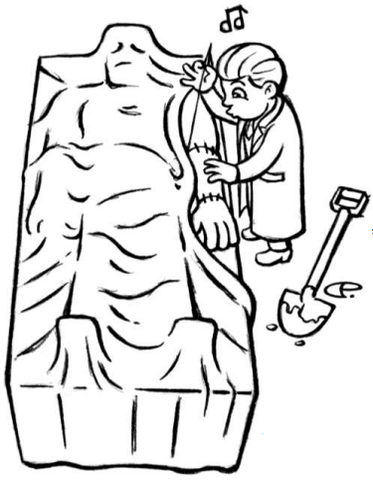
Character Classes
If you are familiar with d20 Modern base classes, ignore everything about them other than that they are 10 levels long and have a system of "bonus feat at odd levels, talent at even levels". In a tradition that is admittedly closer to Fallout, you get to customize your class. Rather than take levels in Fast Hero or Tough Hero, you choose what progressions you gain, which then determines how many skill points you get. For instance, you could make a character that has full Base Attack Bonus progression, good Defense bonus progression, d10 hit dice, and one of two "Great" category saving throw options (either one poor saving throw progression, one average one, and one good one, or three average ones)...but then you are incapable of gaining any skill points other than those you'd get from having a positive Intelligence modifier. You could also go the opposite way and be a complete noodly loser with poor BAB, Defense, and saving throw progressions all around, d4 hit dice, and 10 skill points (plus Intelligence modifier of course) per level.
There are also two preset classes given. The Aggressive character gets d10 hit dice, 2 + Int modifier skill points, a full Base Attack Bonus progression, one good saving throw and two poor ones of the character's choice, and an average Defense bonus progression. The Defensive class, on the other hand, gains d8 hit dice, 5 + Int modifier skill points, average BAB progression, two poor saving throws and one average one of the character's choice, and a good Defense bonus progression. Also, rather than getting a number of Action Points (renamed Karma Points) per level equal to 5 plus half their character level like d20 Modern base classes, it's 3 plus half their character level. Custom classes do the same, it's not a variable option.
Oh, and you may noticed that I didn't mention and class skills, feats, or talents. That's because there aren't any. Any custom class gets access to all the talents and feats in the game, and has three class skills referred to as Tag Skills. Because that's what they were referred to as in Fallout, of course. This does explain why backgrounds let you have so many bonus class feats, but I think it's a weird way of handling it. Why not just add more Tag Skills, or just ignore the idea of Tag Skills entirely and say you get X amount of class skills to choose from? You lost the Fallout license, Glutton Creeper, there's no reason to still hem that close!
Traits
Traits are an optional ability you can take at character level 1, and you can have up to two of them or as little as none at all. Traits are simultaneously a benefit and a drawback, and there are enough of them that I'm going to have to bring out the list text option again.
-
Afraid:
You're paranoid about something and constantly alert, which gives you a +2 to Spot checks but -1 to Initiative due to your hesitation.
-
Beautiful:
Too sexy for this world, you have a +1 bonus to your Charisma score and a +3% boost to Reputation with a specific group but are likely to be targeted by jealous NPCs and slavers. Hopefully you don't have a too vindictive GM. You may note that a percentile boost to Reputation sounds odd, and you'd be right, as Exodus replaces d20 Modern's Reputation score with its own system. We'll get to that later in the chapter.
-
Big and Dumb:
You get a -1 penalty to all mental ability scores and a -5 penalty to your base speed, but get a +3 boost to Strength.
-
Bloody Mess:
Literally pointless. As this was before Fallout 3 and New Vegas were things that existed, Bloody Mess was purely a cosmetic trait. And you know what? Here it is too! It simply tells your GM to describe any kills you make in a particularly gruesome manner.
-
Book Smart:
You are a nerd. +1 to Intelligence and all Knowledge skills are class skills for you, but a -1 penalty to all attack rolls.
-
Bruiser:
Your slow but brutal strikes mean you have a -2 penalty to Initiative but a +3 bonus to melee attack rolls.
-
Chemical Reliance:
Thanks to being a druggy, you are 10% more likely to get addicted to a chemical substance. If you do get addicted, though, you gain a +10 bonus to Fortitude saves to resist the side-effects of withdrawal.
-
Chemical Resistance:
The above, but opposite.
-
Clumsy:
You suffer a -1 penalty to your Dexterity score, but get an extra Karma Point.
-
Extreme Personality:
Thanks to your nature as a caricature of humanity, you have a +1 bonus to Charisma. The downside is that earning infamy with any group increases at double the normal rate.
-
Fast Metabolism:
You heal hit points at twice the normal rate, but suffer a -2 penalty to Fortitude saves against poison and radiation. Not a bad tradeoff, really.
-
Fear the Reaper (Ghul Only):
You get bonus feats at the same progression as a human, but you die at 0 HP rather than -10. Not so good a tradeoff as the last one.
-
Flexibility:
A straight up -1 to Strength but +1 to Dexterity. Why not just put your ability score that way in the first place rather than take a trait that does the same thing?
-
Gifted:
You get +1 to every ability score, but only gain half the usual skill points per level.
-
Good Natured:
Like Book Smart, but the bonus is to Charisma-based skill checks rather than Intelligence.
-
Ham-Fisted (Trans-Genetic Mutant Only):
Your big, meaty fists deal 1d6 lethal damage with an unarmed strike, but you suffer a -2 penalty to Dexterity-based skills that involve your hands and a -4 penalty to attack rolls with non-heavy weapon firearms.
-
Idiot Savant:
Your Intelligence score is limited to 6, but you gain a +5 competence bonus to either a Craft skill, Demolitions, Disable Device, a Knowledge skill, or Repair.
-
Jinxed:
For some reason, you apparently want the GM and the game itself to shit on you. Your Karma Points only get refreshed every other level, and when you or anyone else gets a 1 on an attack roll you/they have to spend a Karma Point to negate a random bullshit effect (ranging from the weapon being dropped to it damaging the wielder) from happening.
-
Kamikaze:
Improved Initiative is a bonus feat for you, but you never get Dexterity or dodge bonuses to your Defense. Because apparently just taking Improved Initiative as your first level feat is too easy in your opinion.
-
Large Body:
You are tall and heavy, gaining a +1 to Strength, but suffer a -2 penalty to Dexterity. Given that I can't think of any feat or talent that relates to your height or weight, I can't imagine this ever being a good idea over just favoring Strength over Dexterity when you pick your ability scores in the first place.
-
Lucky:
This is an odd one. You get an extra Karma Point, but if you ever expend all of your KP you gain the Jinxed trait until you regain at least one KP.
-
Night Person:
You get the low-light vision and light sensitivity species traits. In addition, you have a +1 to Spot checks at night or in dimly lit areas contrasted by a -1 during the day or in bright light.
-
One Hander:
You get a +1 to attack rolls with one-handed weapons at the cost of -4 to attack rolls with two-handed weapons.
-
Physically Fit:
Yet another straight-up ability score exchange trait, this time +1 to Strength and Constitution at the cost of -1 to Intelligence and Wisdom.
-
Sex Appeal:
You have a +2 to Charisma-based skill checks with the opposite sex, but -2 of the same with the same sex. What's that? "Ho-mo-sexuals?" What are those?
-
Sickly:
You have a +2 to Wisdom saves, but -1 to Constitution.
-
Skilled:
While you have a +1 to all skill checks, you gain your level-based bonus feats every fourth level (or every fifth if you're a ghoul).
-
Small Frame:
Oddly enough, rather than being a pure reversal of Large Body, this one has a +1 to Dexterity but only a -1 to Strength. Instead of that extra penalty to Strength, you have a -5 to your base speed.
-
Super Genius:
+3 to Intelligence, but -1 to Charisma and Wisdom.
- Tech Wizard: You are more at home with machines than men, which means you suffer a -1 to Wisdom-based skill checks at the benefit of a +1 bonus to Computer Use, Craft (Electronic), Knowledge (Technology), and Repair skills.
Or, to TL;DR that, not all traits transfer well from Fallout to d20. I have the feeling I'm going to be saying this a lot, but when doing an adaptation from one game to an entirely different form of game, you usually have to take a look at things and realize that a 1 for 1 transfer won't work. That's why it's called an adapt ation.
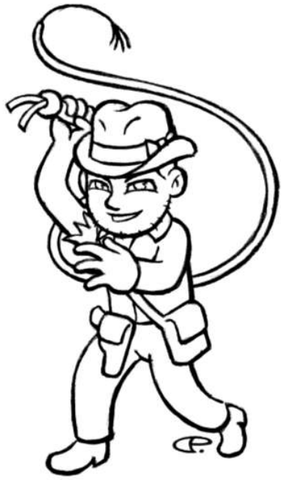
Occupations
There aren't that many new occupations present here, so thankfully we've got a reprieve from long lists. All of the occupations from the d20 Modern Core Rulebook except for Celebrity, Emergency Services, Entrepeneur, Rural, and White Collar are present, as are as the Drifter, Outcast, and Scavenger occupations from d20 Future. Blue Collar has been renamed City Worker and Creative has been renamed Creative Artist for whatever reason, though. For completely new occupations, there are a total of seven. Bison Herders are any rancher-type character and get two bonus class skills chosen from Barter, Craft (Structural), Drive, Handle Animal, Navigate, and Ride. The rather confusing No Occupation occupation lets you have any two skills as bonus class skills, making it one of the best "occupations" in spite of being meant for a layabout or indecisive character.
Raiders are wasteland gangsters that get two class skills chosen from Climb, Gamble, Hide, Intimidate, Jump, Move Silently, Search, Spot, and Survival, which is contrasted by the city-dwelling Wise Guy who gets two class skills chosen from Bluff, Demolitions, Disable Device, Escape Artist, Forgery, Gamble, Gather Information, Intimidate, Knowledge (Civics, Occult, Street, Tactics, or Underworld), Listen, Move Silently, Sense Motive, Sleight of Hand, and Spot. They're also both kind of strange given that the Criminal occupation from d20 Modern core hasn't been removed in favor of these specialized variants. You could also argue that Slaver , with its two bonus class skills chosen from Barter, Bluff, Forgery, Gamble, Gather Information, Intimidate, Knowledge (Street or Underworld), and Sense Motive, might also qualify as a variation of Criminal.
Similarly questionable are a pair of military specialists that are added without the removal of the Military occupation. Ranger is a wilderness survival type, gaining Track as a bonus feat and two class skills chosen from Balance, Climb, Handle Animal, Hide, Jump, Listen, Knowledge (Geography or Nature), Move Silently, Navigate, Ride, Search, Spot, Survival, and Swim. Soldier , on the other hand, is almost entirely the same as the still present Military occupation, save that it loses Climb and Swim as potential class skills but gains Intimidate.

Next Time
Geeze, chapter 1 isn't over yet? We'll finish it off with talent trees and the new Reputation system, then get into chapters 2 and 3. Find out why some of those Knowledge skills don't sound familiar even if you know d20 Modern, learn who really runs Barter town, and question a feat that gives you access to an unwritten GMPC.
Character Creation Part 2, Skills, and Feats
Original SA post
Character 1 Continued

Talents
The thing that makes the d20 Modern class system go 'round is the second to last thing to cover in the first chapter of Exodus. In addition of a reprinting of all of the standard d20 Modern talent trees such as Fast-Talk and Melee Smash, there are also nine new talent trees and four new talents for old trees. Before getting to a list of the new trees, it would probably be best to briefly note the four new talents added to existing trees.
Radiation Resistance is added to the Tough Hero's (well, once Tough Hero's, now anyone's) Energy Resistance tree, and allows a character to ignore 100 x their Constitution modifier in Rad units of radiation damage. This isn't how radiation works in standard d20 Modern, but it also isn't fully discussed until chapter 5, so we'll just ignore going too deep into that for now. Of more immediate understanding is Alluring Gaze , an addition to the Charismatic Hero's Charm talent tree. Charm is already a dumb talent in d20 Modern as-written-for-the-System-Reference-Document, and Alluring Gaze is somehow even dumber. With this talent you effectively get a gaze attack to make people think you are interesting. Members of the opposite sex think you are hot and have their mood towards you increased to Friendly, while members of the same sex find you intriguing and have their mood improved to Indifferent. Both are flat-footed for a number of rounds equal to your character level because they are so fascinated by you.
The other two are both additions to the Charismatic Hero's Fast-Talk tree. Smooth Talker makes you king of bullshitting, allowing you to spend 5 minutes talking to a character 4 or more levels lower than you to automatically succeed on a Bluff or Diplomacy check against them. Unlike most talents and feats that relate to Diplomacy, there's no minimum mood requirement for Smooth Talker, meaning you can say a bunch of meaningless platitudes to an arch-villain and win them over to being Friendly toward you without any further effort as long as you are at least 4 levels higher than them. The other talent, Silver Tongue , is a far more unremarkable "you get to reroll a failed Diplomacy save at a -4 penalty, but you can only do it once per Diplomacy attempt on the same target".
And those new talent trees? Well, I guess we should get to those. I'm going to try just normal formatting rather than using the list function for these from now on, as I've been bothered by how cluttered bullet lists must make my jumbles of words look to others.
Gunslinger: Do you like guns? Do you want to be really good with guns? Then this is the talent tree for you, or at least it is intended to be. In reality, none of its three levels of talent are particularly great. Gunslinger itself gives you a flat +1 bonus to attack rolls with personal firearms, Pistoleer lets you ignore the first two points of damage reduction granted by armor (did I note that this is a system that uses damage reduction rather than Defense/AC bonus for armor? Oh well, I have now), and Machine Gun Johnny grants you Advanced Firearms Proficiency as a bonus feat.
Hand to Hand: Do you like to punch things? Do you want to be really good at punching things? Then this is actually the talent tree for you. Its first three talents allow you to deal lethal damage with unarmed attacks and increases the damage dealt to 1d6, 1d8, and finally 1d10, and you can do it at far lower levels than the Martial Artist advanced class would do the same thing for you. And no, they didn't even remove the Martial Artist advanced class either, so there's basically no reason to ever take that advanced class when you could just take three Hand to Hand talents and get the same damage by character level 6 that you wouldn't get with Martial Artist until you had 11 character levels under your belt. Oh, and there are two talents for the tree that give you the effects of Weapon Focus and Improved Critical respectively, but who cares about those?
Martial Arts: Oh hey, more redundancy. The first three talents of this tree, referred to as Karate I to III, happen to do the same thing as the first three of Hand to Hand! What a surprise. There is also Judo , which grants a +4 to Escape Artist and grapple checks, and Kendo , which effectively grants Weapon Focus and Improved Critical with any spear, staff, or sword weapon.
Mr. Handy: The first pair of talents that actually feels like a pair of talents rather than weird feat-miming or replicating an existing class that wasn't even kept out of this game. The talent Mechanic grants a bonus to Repair checks equal to your character level, while Mr. Goodwrench lets you take 10 on Repair checks even when distracted or threatened. Not particularly amazing to read about, but at least they aren't another Hand to Hand.
Quicker Than the Eye: A three talent long talent tree for disguise and disorientation-minded folks. The Matchstick Man talent allows you to substitute a Perform check for a Bluff check for the purposes of making a distraction, Magician grants a bonus to Sleight of Hand checks equal to your character level, and Quick Disguise allows you to take 10 on a Disguise or Hide check even when distracted or threatened.
Scientist: Or, more accurately, Chemist. This talent tree has two talents, one that grants a +2 bonus to Craft (Chemical) checks and a second that ups that to +5.
Spontaneous Fighting: This is a bit of an odd one. One of its two talents, Improvised Weapon , lets you circumvent the normal -4 penalty to using an improvised weapon. That's definitely spontaneous fighting. But the other? Blades , which lets you deal +1d4 damage with any melee weapon that deals slashing damage. I don't usually consider swords and axes to be that spontaneous, but I guess you can make the case for switchblades and knives being the exception that prove the rule here.
Stealth: Go ahead and take a guess what this talent tree's good at. Locksmith grants a flat +2 to Disable Device checks made to pick non-electronic locks, The Shadow
Survival: You may be shocked and amazed to know that this talent tree mostly deals with uses of the Survival skill. If you need supplies, you can take Skilled Hunter to be allowed to make a DC 12 Survival check to find a day's worth of food or Dowsing Rod to be allowed to make a DC 15 Survival check to find a source of water. These are both things that a normal DC 10 Survival check can do in standard d20 Modern, but for whatever reason Exodus decided to move these to exclusive talents. The other talents the Survival tree grants are Camouflage (use Survival instead of Hide checks to hide in wilderness areas), Beast Soother (DC 20 Handle Animal check immediately calms a hostile creature to Neutral mood), Ambush Bug (force a -4 penalty to Spot checks to notice an ambush you set up), and Pathfinder (character level's worth of bonus to Survival checks).

Reputation
In standard d20 Modern, Reputation is a single modifier that that allows a character to throw their notoriety around with a Reputation check and provides either a bonus or a penalty to Bluff, Diplomacy, Gather Information, Intimidate, and Perform checks depending on whether or not the person in question finds the character famous or infamous. In Exodus, it is literally the faction reputation system from Fallout. You have a Fame and Infamy rating with each faction, such as the Steel Disciples or the Chi of San Francisco, that is on a percentile scale of 100. There is a percentile gain to each based on specific actions. For instance, negotiating a peace treaty between two factions is listed as a +1% bonus toward both of them, while betraying a faction grants +5% Infamy.
What does this new Reputation system actually do, beyond give an arbitrary measure for the GM to decide how factions treat you? Just two things. One is that you get a +2 bonus to Gather Information checks in areas controlled by a faction that you have 50% or higher Fame with, and the other is that it affects a specific feat we'll discuss in a little bit.

Chapter 2: Skills
There's not actually a lot to go over when it comes to skills. Most skills work the same as the do in d20 Modern with little to no alterations, and there's only one new skill, so a lot of this chapter can be ignored as reprinted material.
One noteworthy change is the Knowledge skill. There are twelve Knowledge skills in standard d20 Modern, and twelve Knowledge skills in Exodus. So why are there some odd new Knowledge skills you might have noticed in the backgrounds and occupations? A few have indeed been replaced, but others have simply been renamed. To note the specifics, Arcane Lore has been renamed Occult, Current Events has been renamed Street, Earth and Life Sciences has been renamed Geography, Physical Sciences has been renamed to just Science, and Streetwise has been renamed Underworld. The Knowledge skills Art, Behavioral Sciences, and Business have been removed as well, and in their absent slots are now the Knowledge skills Engineering, Medicine, and Nature. Engineering covers knowledge of buildings, craft materials, and the ability to read blueprints, Medicine covers both behavioral sciences and knowledge of genetic engineering and medical treatment, and Nature identifies animals and plants.
Perhaps more directly affecting play, however, is the addition of a new use to the Search skill: scavenging. Scavenging lets you turn a Search check into a specific sweep of a 100 x 100 ft. area of ruins, with a higher result meaning better finds. DC 15 is the lowest result and scavenges up a single bottle of
And what of the entirely new skill? Enter Barter. For clearly no reason at all and certainly not because of its Fallout origins, Exodus rules that if you as a player are selling an item, it is half price compared to how many
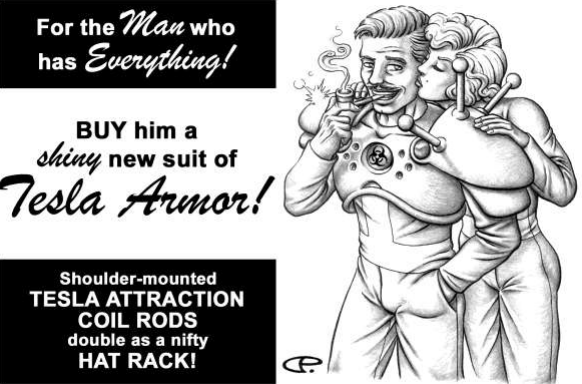
Chapter 3: Feats
In addition to being a thing that already exists in the d20 system, feats in Exodus are explicitly meant to line up with perks. Hell, they even left a rather “whoops” sentence in where they just replaced “Perks” with “Feats” and didn't even remove the part referencing the book's Fallout origins:
“Feats Introduction” posted:
Most of the Feats from the computer series are presented in one form or another (Advanced Class, Talent, or Trait) in this guide.

It's the same story with feats as it was with occupations and talents. The d20 Modern examples are still there, a few have been retooled in minor ways or renamed arbitrarily (like Improved Critical has been renamed "Better Critical" and Improved Natural Healing into "Faster Healing" for whatever reason), and there are also new feats that are often directly related to Fallout perks.
Action Boy: Do you really like the extra move or attack action you can get with the Heroic Surge feat, but don't have enough uses per day for your liking? Fear no more, then, as Action Boy lets you pop a Karma Point to get an extra use per day after you've expended the one to five times per day you normally have based on your character level.
Adrenaline Rush: If you've dropped below half your normal HP, you get a +2 bonus to attack rolls and physical ability score-based skill checks for a number of minutes equal to your Constitution bonus.
Animal Friend: Domestic animals are automatically Friendly toward you and wild animals are Indifferent. On top of that, you also get to have one animal companion in the same style of the D&D Druid.
Awareness: If you spend a full round studying an enemy, you get a +1 bonus to attack rolls against them for the rest of the encounter.
Bonus Ranged Damage: You get a +1 bonus to all damage rolls with ranged weapons. Hooray?
Bracing: Your Strength score is treated as being 2 higher for the purposes of wielding large firearms. Weapons in Exodus have a set Strength requirement to wield them, by the way, as you have just learned.
Comprehension: You gain three extra skill points. Not per level, just three skill points to spend then and there.
Demolition Expert: Explosives deal an extra 1d6 damage.
Dodger: The bonus to Defense from the Dodge feat is increased by a further +1. Dodger is also unlimited in how many times you are allowed to take it, so I'm not sure why they didn't just rule that Dodge itself could be taken multiple times.
Earlier Sequence: On top of gaining a +2 bonus to Initiative checks on top of the +4 the character would already have (as you need Improved Initiative to take this feat), you are always able to act in a surprise round.
Empathy: Congratulations, you have turned the Sense Motive skill into the discern lies spell.This kind of feat seems like something you'd use as a great justification for taking Knowledge (Behavioral Sciences), but since that Knowledge skill was removed in Exodus it instead requires ranks in Sense Motive and Diplomacy.
Exotic Weapons Proficiencies While not technically a new feat, the subsets of Exotic Firearms Proficiency have been almost entirely changed so it might as well be a new feat. In standard d20 Modern, Exotic Firearms Proficiency can be taken for the categories Cannons, Heavy Machine Guns, Grenade Launchers, and Rocket Launchers. In Exodus, Exotic Firearms Proficiency is split up into Energy Firearm Proficiency (laser and plasma firearms), Flamethrowers , Heavy Weapons (heavy machine guns with a different name), and Propelled Launchers (grenade launchers and rocket launchers). I can understand why they decided to change the existing rules that stated flamethrowers had no proficiency and energy weapons where just under Personal Firearms Proficiency, though renaming Heavy Machine Guns into something more vague while keeping its definition the same seems a bit silly.
Finesse (or "Feneese" according to the feat list): You get a +4 bonus to confirm critical hits, but deal -1 damage on all attacks. This feat has no relation to Weapon Finesse, and also seems almost more in line with the traits from earlier than it does with feats.
Flower Child: You are so
 that you gain a +2 bonus to Fortitude saves made to resist getting addicted to the numerous drugs you take.
that you gain a +2 bonus to Fortitude saves made to resist getting addicted to the numerous drugs you take.
Fortune Finder: One of those classic "+2 to two skills" feats, this one applying to Craft (Salvage) and Search checks made specifically to scavenge.
Gain Ability: You, uh, gain an ability. Specifically, 1 point in one ability score. You're only allowed to take this feat once per ability score, presumably to prevent shenanigans like stacking up to 30 Strength or whatever.
Ghost: On top of a +2 bonus to Hide and Move Silently checks, you gain 3/4 cover at night or in dimly lit areas. Cover, not concealment. That means you are getting a +7 bonus to Defense just because the sun goes down.
Gunner: You gain a +1 bonus to attack rolls made with firearms while you are on a moving vehicle. Considering a moving vehicle conveys a -4 penalty to attack rolls, this feat isn't exactly useful. At all.
Harmless: For the entry fee of having a Charisma score of 17 or higher, you gain a +1 bonus to Barter, Bluff, Diplomacy, Gather Information, Sense Motive, and Sleight of Hand checks.
Healer: When you use the Treat Injury skill to heal someone's hit points, it heals double the normal amount.
Heave Ho!: All thrown weapons have a +10 increase to their range increment.
Hit the Deck: This feat gives the tradeoff of taking half the normal damage from explosives at the penalty of being knocked prone after every explosion due to a tendency to dive for cover.
Hand to Hand Evade: You gain a +2 to Defense in melee combat, but only if you are fighting unarmed.
Hand to Hand Fighter: The bonus to attack and damage rolls granted by the Improved Brawl feat increases from +2 to +4.
Karma Beacon: Take a feat, get a single extra Karma Point for your pool.
Lead Foot: Any land vehicle that runs on fuel cells (which is any land vehicle that isn't pulled by pack animals) have their top speed increased by 20 feet.
Life Giver: You gain 2 extra hit points every class level you take.
Light Step: You gain a +2 to Defense and Reflex saves against any ground-based hazard, such as pit traps or land mines.
Living Anatomy: Oh hey, a feat that has both combat and non-combat benefits, you don't see those that often. With this feat, you get a +4 to Knowledge (Medicine) and Treat Injury checks, a +1 to attack rolls against humans or human-based mutants such as ghuls and Trans-Genetic Mutants, and the healing effects of the long-term care use of the Treat Injury skill are doubled.
Magnetic Personality: Literally the Leadership feat from Dungeons and Dragons. It's been given a rename because there is already a completely unrelated talent tree called Leadership in d20 Modern, rather than for arbitrary reasons as has often been the case in this book. The one major difference between this and traditional Leadership is that your Reputation comes into play. The tens number in your percentage of Infamy or Fame dictates your effectiveness in trying to gain a companion or followers. For instance, if you have 50% Fame with the Steel Disciples, you'd get a +5 bonus to your
More Critical: Is the +1 increase to critical threat range from
Mr. Fixit: On top of a +2 bonus to Disable Device and Repair checks, the DC of any Repair check is decreased by your Intelligence bonus.
Mutate!: You can change out one trait you took at level 1 for another. Whoopee.
Mysterious Stranger: How much do you enjoy extremely arbitrary GMPCs? Hopefully a lot, because everything about the Mysterious Stranger is pretty damn arbitrary. By expending a Karma Point when you are in "dire need" in combat, the Mysterious Stranger appears to aid you! What kind of statistics does the Mysterious Stranger have? It's up to the Game Master to stat him up, of course! His level, skills, and class layout are all entirely up to the GM. Is he lower level than your character, equal level, higher level? Who knows, it varies depending on whatever your GM decides. A feat where the GM has to make shit up on the fly and the player has to put their entire trust in a GMPC is assuredly a great idea!
Pack Rat: Your Strength score is treated as 2 higher specifically for determining carrying capacity.
Pathfinder: Overland travel between any two destinations is decreased by 10%.
Presence: Another +2 to two skills feat, this time for Diplomacy and Intimidate.
Pickpocket: You gain a...+3 to Sleight of Hand checks? I'm not sure you fully understand how the bland skill bonus feats game is supposed to be played, Exodus.
Pyromaniac: You gain a +2 to attack and damage rolls with any weapon that deals fire damage.
Quick Pockets: Quick Draw, but for non-weapon equipment.
Quick Recovery: You can take a free action but provoke an attack of opportunity to rapidly get up from being prone.
Rad Child: You are immune to any radiation that is 600 Rads or lower. Surprisingly, it only takes having a +3 bonus to Fortitude saves to have this rather formidable feat.
Rad Resistance: You get a +4 bonus to Fortitude saves against the effects of radiation. Given that this feat requires both a Constitution score of 13 and the Toughness feat, it seems like it would be far more useful to take Rad Child if you are that worried about radiation.
Ranger: You gain a +1 bonus to Hide, Listen, Move Silently, Navigate, Search, Spot, and Survival checks in any wilderness environment.
Strong Back: Like Pack Rat, but at a +4 bonus rather than +2. Pack Rat is nonetheless arguably more useful for Dexterity- or mental ability score-based characters, as it has no prerequisite while Strong Back requires a Strength score of 13 or higher.
Stunt Man: Falls are treated as being 20 feet shorter for the purposes of taking damage, and on top of that fall damage is 1d4 per 10 feet rather than the normal 1d6 per 10 feet.
Stonewall: You're pretty unmovable, with a +4 bonus to oppose bull rush, overrun, and trip attacks, as well as any effect meant to move you or knock you prone.
Surface Vehicle Operation: As with Exotic Firearms Proficiency, this is an existing feat that had its subcategories altered enough that it might as well be a new feat. In standard d20 Modern, the Surface Vehicle Operation categories are Heavy Wheeled, Powerboat, Sailboat, Ship, or Tracked, with general purpose cars, trucks, motorcycles, and the like not needing a feat to operate without penalty. Exodus replaces the three watercraft proficiency feats with Boats ("small" boats such as jet skis, rowboats, and sailboats) and Watercrafts (boats that require multiple crew members such as yachts and cruise liners), Heavy Wheeled and Tracked are replaced by Constructions (construction vehicles like bulldozers and dump trucks), Heavy Duty (large non-construction civilian vehicles like 18 wheelers and RVs), and Military (military APCs, tanks, and such), and the new categories Bikes (motorcycles) and Four-Wheelers (cars, trucks, dune buggies, etc.) are added.
Thief: You gain a +1 to Disable Device, Hide, Move Silently, and Sleight of Hand checks.
And to avoid ending off on a big wall o' feats, have a gander at some of the descriptions for classic feats, to get a feel for Exodus's attempts at miming Fallout writing. The typos here aren't mine (for once
 ), as I felt it would be best to actually keep these intact rather than fix them, just to add that extra flavor.
), as I felt it would be best to actually keep these intact rather than fix them, just to add that extra flavor.
Feat Descriptions posted:
Agile Riposte: Father Nelson instructed you as a young child about strange people touching you. So now when your opponents attempt to feel you up, you know how to retaliate.
Far Shot: By calculating the wind speed of a European swallow against the glare of the sun, divided by the pitch of the horizon, you can shoot farther than others.
Gearhead: Most people dream of a beautiful woman, but you, you dream of components and gears! The closest you are going to get to a girl is dressing up your wrench like a wench.
Improved Knockout Punch: "Mama, said knock you out!" You have learned the wind up punch to deliver a devastating blow to an unwary opponent.
Quick Draw: When Wasteland Bart Black calls you out for a wasteland showdown, you re quick to draw your smoke wagon and plug him full of holes.
Next Time...
Equipment and combat, from power armor and punches to drugs and drag-outs.
Equipment
Original SA post
Chapter 4: Equipment
Bolding was in the actual book! posted:
War never changes... Violence in the Wasteland is a part of life, and if you do not have the proper equipment you may be taking a dirt nap. As a character travels through the Wasteland he will need the right equipment. The Rad-Tek Survival Guide lists the optimal weapons, survival equipment, medical supplies, and other items considered essential to survive the aftermath of an atomic war; but, in the Wasteland a survivor has to learn to scrounge and make the best use of what can be found hidden in a ruined building or bunker; taken off the body of a hostile traveler: or, stolen from the inattentive and unwary. This chapter details the weapons, armor, and miscellaneous equipment that can be found in the Wasteland.
Post-Apocalyptic Economics
Rather than bottle caps, the currency of Exodus is coinage. While these are scavenged Old World coins, their value is determined by their material composition. Steel coins are the "baseline" coin, with the other coins being tied to that worth: a copper coin is worth 1/100 of a steel coin, silver coins are worth ten steel coins, and gold coins are worth a hundred steel coins. Coin prices aren't the only thing characters have to be concerned about, however, as there is also an item scarcity rating. Common items include brass knuckles or rope and are found easily and sold by almost anyone, Uncommon items such as 20 gauge shotguns and bolt cutters have a 50% chance of being sold by merchants and are most often found in trading posts, ruins, or communities with manufacturing technology, Infrequent items like Desert Eagle pistols and handcuffs have a 25% chance of being sold by merchants, Rare items such as miniguns and Geiger counters have a 10% chance of being sold by merchants, Very Rare items including .50 caliber sniper rifles and the
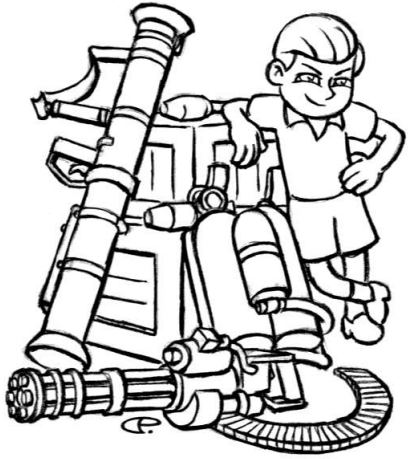
Strength Scores and Weaponry
As I noted briefly in the last post, Exodus introduces a Strength requirement for wielding weapons properly. Or, more accurately, to wielding firearms properly: archaic and simple ranged weapons, explosives, and melee weapons are exempt for some reason. If you don't have the proper Strength score for a firearm, you're going to be suffering a penalty to attack rolls equal to how much lower your Strength score is than the target number. For example, a character with a Strength score of 11 can wield an AK-47 (Strength prerequisite 10) just fine, but will be suffering a -3 penalty to attack rolls with a Desert Eagle because it has a Strength prerequisite of 14. Other than heavy weapons (which are almost exclusively 16 or 18) and 2d4 damage firearms (Which are between 6 and 8), most firearms have a Strength prerequisite between 10 and 14.

Firearms: Handguns, Shotguns, and Rifles
Firearms start off the actual lists of equipment. As before and in the future, I'll be excising any material that is already in the d20 Modern SRD such as Ak-47s and Desert Eagles, and purely noting what new material that Exodus brings to the table.
Pistols: Pistols have eleven newcomers. Most of these are rather unremarkable and generic: the . 22 Custom, Derringer, and Ruger MK II are 2d4 damage Tiny pistols with concealment, the MAB P15 and Mauser M96 are dime a dozen 9 millimeter 2d6 damage pistols, and the single-action and double-action revolvers are both 6 cylinder cowboy revolvers that can deal between 2d4 and 2d8 damage based on variable ammunition loads. One that is at least somewhat novel in the type of ammo it takes is the .223 Custom , a 2d8 damage rifle that has been converted into a pistol that fires five bullets and does basically nothing to justify its Very Rare scarcity and exceedingly high price of 3,500 coins beyond having a range increment that is more in line with rifles than pistols. Also at least somewhat noteworthy are the single shot 2d6 damage flintlock known as the trade pistol , the terrifying Sig-Sauer that deals 3d8 damage (that's the same damage as a minigun), and the Colt 6520 . That last one? It's a simple 2d6 damage 10 millimeter pistol, which wouldn't be interesting...were it not for the fact that it isn't a real pistol. The Colt 6520 comes straight from Fallout and is the starting weapon of Fallout 2's player character. Guess the settlement lawyers missed that one.
Submachine Guns and Machine Pistols: Five SMGs, only one of them noteworthy. The Heckler and Koch P90 deals 2d8 damage, but otherwise you have the Colt 635, M3A1, Mac Ingram 11, and the Thompson M1928 “Tommy Gun” are all rather generic 2d6 automatic weapons differentiated by ammunition used and minor differences in range increment and clip size. This is fine for a game where scavenging ammo is meant to be part of the challenge or you want minute pick and choose elements over widely varying damage, but it doesn't make for good FATAL and Friends posts, so let's hurry onward.
Rifles: Twenty-one new rifles, most of them again following general conventions beyond some minor increment, clip size, and ammo type differentiations: the AK-112, bushwhacker sniper rifle, CAR-15, Colt Rangemaster, DKS 501 sniper rifle, M1 carbine, M16A1, and Mauser Bolt Action are 2d8 damage rifles or sniper rifles, the DKS 101 sniper rifle, FN FAL, Heckler and Koch 53, M1 Garand, M14, M1903 Bolt Action, and SKS carbine are 2d10 damage rifles/sniper rifles, and the Bushwhacker heavy sniper rifle is a 2d12 sniper rifle. This does, of course, leave five rifles that don't follow typical conventions. On one extreme of the spectrum, the bolt action target rifle , Henry survival rifle , lever action carbine , and Ruger 1022 are all 2d4 damage rifles of some stripe that use .22 ammunition, which definitely stands out when no standard 2d0 Modern rifle deals less than 2d8 damage. You also have the Heckler and Koch G11 on the opposite end, a Large automatic rifle thundering out 3d8 damage.
Shotguns: Oh hey, new game mechanics, that's a breather from listing inconsequential shit. In standard d20 Modern, shotguns suffer a -1 penalty to damage rolls for each range increment past their first (which is usually quite short) due to pellet scatter. This move has always been one that even d20 Modern fans have often questioned and designer Rich “I fought wars, you know” Redman defended. For its part, Exodus decides to actually double down on the damage penalty, increasing it to -2 per increment, but also gave all shotguns a 19-20 critical hit threat range when standard d20 Modern firearms always have a straight 20. For new shotguns, the 12 gauge double barrel shotgun, Heckler and Koch CAWS, Pancor Jackhammer, 12 gauge pump action shotgun , and Winchester City Killer (oh hey, another Fallout product identity weapon that sneaked under the radar) are all standard 2d8 damage shotguns, while the 20 gauge double barrel shotgun, 20 gauge pump shotgun, and 20 gauge sawed-off shotgun are the first introduced 2d6 damage shotguns.
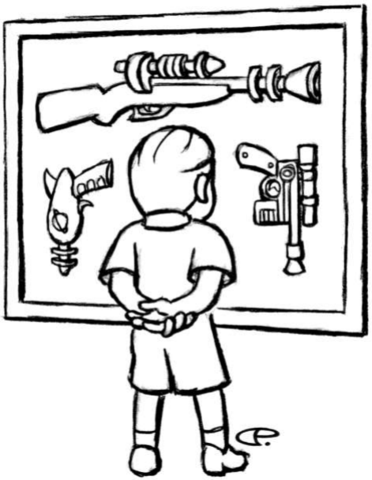
Exotic Weapons
Heavy Weapons: There are five new heavy weapons, a surprisingly small amount when they only had three from d20 Modern core to reprint. The M60 light machine gun of the Vietnam War is the weakest, dealing a measly 2d8 damage that is only offset by its hefty belt-fed ammo count and a range increment that nears that of some sniper rifles. If you're looking for something with more direct punch, there's always the Trans-Genetic Mutant favorite weapon that is the minigun. A standard minigun deals 3d8 damage, and on top of that there are the even more powerful 4d8 damage Punisher and 5d8 damage Vulcan advanced military miniguns. Finally, you've got the Rockwell Launcher , which can fire either 10d6 damage explosive rockets or 8d6 damage armor-piercing rockets that ignore 10 points of damage reduction.
Energy Weapons: While energy in d20 systems typically refers to the quintuplet damage types of acid, cold, fire, electricity, and concussion/sonic, energy weapons in Exodus deal either what is referred to as laser damage if they dish out heat or “energy damage” that covers everything from electricity to plasma. In the former category are the 2d8 damage ElectroMac 500 laser pistol , 2d10 damage MegaWatz 1000 laser pistol , 3d8 damage ElectroMac 950 laser carbine , and both the semiautomatic MegaWatz 2020 laser rifle and automatic Heckler and Koch gatling laser for 3d10 damage. For weapons that deal energy damage, you've got the 2d10 damage B52 plasma pistol , 3d12 damage Winchester P94 plasma rifle , 4d8 damage electro scorcher pistol , KYJ-X2 pulse pistol , and KYJ-Z4 pulse rifle , and 4d10 damage alien blaster . The electro scorcher (a prototype pre-War military device) and alien blaster (an extraterrestrial pistol) both have the distinguished status of being the only Unique scarcity items in the entire book.
Explosives: While technically not exotic weapons, explosives happen to be listed under their header. While explosives in d20 Modern tend to deal either slashing, concussion, or fire damage, in Exodus all standard d20 Modern explosives other than the Molotov cocktail (which has been changed to deal energy damage, while the thermite and white phosphorous grenades that also typically deal fire damage are no-shows entirely) have been given an unexplained “explosive damage” type. The newly-added 3d6 damage pipe bomb , 4d12 damage landmine , and 5d8 damage plastic explosive also deal explosive damage, while the 5d10 damage plasma grenade deals half explosive and half energy damage. There's also the EMP pulse grenade , which states it destroys all electronics and robots that fail a DC 15 Reflex save in a 10 foot radius of where it falls. Not disables, straight up destroys. The description even states that all circuitry and wiring is so melted it can't even be scavenged.
Energy Melee Weapons: These are technically melee weapons that run on energy as opposed to weapons that deal energy damage, as only one of the four here (the 1d10 damage cattle prod ) actually deals said damage type. The 3d4 damage cutter plasma knife and 2d6 damage power fist both deal piercing damage, and the stun club is a paralytic weapon that is used to...uh...
“Exodus: Post-Apocalyptic Roleplaying” posted:
The infamous stun club by Bushwhack, was designed for police to incapacitate criminals, and was widely used in prison. However, this weapon was sold on the black market, and became known as the new-date rape drug, as perverts used it on unsuspecting woman.

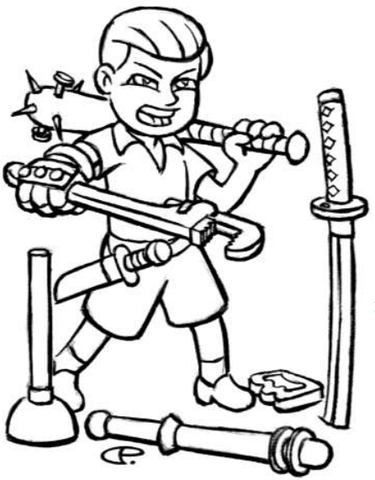
Melee Weapons
There are no new archaic melee weapons, only simple meele weapons. Said new simple melee weapons are the 1d2 damage sharpened stick , 1d3 damage shiv , 1d4 damage police baton , 1d6 damage baseball bat , lead pipe , sharpened pole , and wrench , 1d8 damage sledgehammer , and 2d8 damage super sledge . Some of them, like the lead pipe and wrench, honestly sound like they should be counted under the rules for improvised weapons. But what do I know? It's not like Exodus itself still lists wrenches when it copy-pastes the SRD rules on improvised wea-

Oh wait , it does.
Thrown and Projectile Weapons
For whatever reason, these are listed after melee weapons rather than back with all the other ranged weapons. The 1d4 damage throwing knife and wrist crossbow , 1d6 damage shortbow , and 3d6 damage arbalest are the new additions.
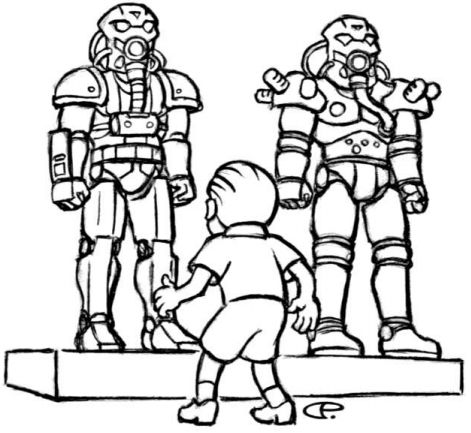
Armor
Armor in Exodus basically has no relation to how armor is treated in standard d20 systems. Rather than just providing an armor bonus to Defense (though it does still do that), armor in Exodus has four different types of damage reduction that only provides DR against a specific type of damage. PDR is damage reduction against physical damage types, EDR is against energy damage, LDR is against laser damage, and XDR is against explosive damage. To use an example of two types of armor that were already in d20 Modern and kept in Exodus, leather armor has a +2 bonus to Defense that is augmented only be 1 PDR, while a tactical vest has DR 3 across all four categories on top of a +6 bonus to Defense.
Light Armor: Seven new armors here, though I'd hesitate to call the cloth armor new as it is literally the exact same stats-wise as a leather jacket beyond being one pound heavier. The weakest of the new light armors other than cloth is improvised armor . Being just some junk metal strapped onto someone's chest with belts or rope, improvised armor has the same +1 bonus to Defense and lack of any DR that leather and cloth armor has, but has a maximum Dexterity bonus of +3 compared to their +8. Its only upside is that it costs nothing to buy. If a +2 bonus to Defense is more your style, the field suit has 1 in all forms of damage reduction, while the riot shield grants 2 PDR, EDR, and XDR but no LDR. For +3 there's the MK II leather armor with its 1 PDR and XDR, while for a +4 Defense bonus you have the choice of either the relatively cheap combat leather jacket with its 1 XDR or the concealed mesh vest with 2 PDR, 1 EDR and LDR, and a price tag that is higher than some medium armors.
Medium Armor: Eleven new types of medium armor are present, starting down at +4 bonuses with environmental armor that has 4 PDR, LDR, and XDR and 5 EDR that is contrasted with armor penalty and maximum Dexterity bonus that are cripplingly poor, metal armor with 2 PDR, EDR, and XDR but 4 LDR, Trans-Genetic Mutant Armor with 2 in all forms of damage reduction, and Tesla Armor with 1 PDR, 3 XDR, 6 EDR, and 8 LDR. For a +5 bonus to Defense there's the MK II metal armor that has the same damage reduction spread as regular metal armor, concealed mesh suit with 3 PDR and 1 for all other forms of damage reduction, MK II environmental armor with 6 XDR but otherwise similar damage reduction spread to standard environmental armor, and MK II Trans-Genetic Mutant armor which has the same damage reduction spread as its normal. Finally, for +6 Defense bonus medium armors, there is the combat armor with 3 EDR and XDR but 4 PDR and LDR, and its MK II version which has a +7 bonus to Defense and 4 XDR but is otherwise similar.
Heavy Armor: For whatever reason, none of the three types of heavy armor from the d20 Modern Core Rulebook were kept in Exodus, meaning all five types of heavy armor are new. The weakest heavy armors are space armor with a +6 bonus to Defense and MK II space armor with a +7 bonus. As they are meant to be space suits and thus deal with cosmic particles more than physical force, they have 3 PDR and XDR but 5 EDR and LDR. The other four are all variants of everyone's favorite Fallout standby, power armor . Bog standard power armor has a +10 bonus to Defense, 6 XDR, 7 PDR and EDR, and 8 LDR. Hardened power armor ups the PDR to 8 and the XDR to 7, advanced power armor boosts the Defense to +11 and improves on the hardened power armor with 8 EDR and 9 LDR, and MK II advanced power armor further improves things with a +12 armor bonus to Defense, 9 LDR, and 10 PDR. Power armor is also special in that while it has crippling armor penalties to armor penalty-tied skills (-7 for MK II advanced power armor, -8 for the rest), it doesn't reduce your base move speed.

Medical Supplies: The name of the game here is “make the Treat Injury skill pointless”. Poisoned? Bypass a Treat Injury check and immediately fix that up with a poison antidote . Wounded? There's healing salve to instantly patch up 1d3+2 HP,
Drugs: Don't get too excited about the idea of going chem-crazy, most of them really aren't worth it. Almost all drugs have an after-effect once they've worn off, and for a lot of them it's ability score damage. Rather than being a temporary debuff like all non-ability score effects (which wear off after between two to eight hours of time, depending on the drug), you have to heal 1 ability point of damage per day like normal ability damage, meaning that you are taking days to even weeks to heal up the benefits of a drug that lasts for a few hours. There's also the chance of addiction, which is low (10 or 20% for most drugs, save for two particularly potent ones) but nonetheless possible. The actual rules for addiction are found in the next chapter. There are only two drugs that avoid having any after-effects or addiction. These are Rad Blocker 2 , which decreases the amounts of RAD taken by half for 24 hours, and Radium X , which removes 1000 RADs already taken. There's also the odd drug out of Black Sunshine , which provides darkvision for four hours and has the after-effects of a -10 to Spot checks rather than any type of ability score boost followed by after-effects of ability score damage.
The rest of the drugs tend to provide a benefit to an ability score and possibly some other benefit. You've got Afterburner to grant +10 movement speed, +2 Wisdom, and +4 temporary HP for ten minutes with the after-effects of taking 2 points of Wisdom damage, Burnout that grants +6 to Listen and Spot checks and a +4 to Reflex saves but -4 to Wisdom for four hours with the after-effects of 4 points of Wisdom damage and a -4 to Reflex saves, Inferno which provides +4 Dexterity, -2 Intelligence, and PDR 4 for four hours with after-effects of 6 points of Dexterity damage and +2 extra damage taken from any attack, Mindmeld that grants +2 to all mental ability scores for a whole day with the after-effects of taking two points of damage to those same ability scores, [/b]Mutagen[/b] that grants +4 Strength and +2 Constitution for two hours but has the whopping after-effects of taking six points of ability damage for the same abilities, Vigoroids which is literally Mindmeld but for the three physical ability scores rather than three mental ability scores, and Voodoo which provides +2 Dexterity and an extra Karma Point with the after-effects of four points of Dexterity damage.
Field Gear: Most new added field gear/survival items are self-explanatory as to what they do. I'm fairly sure you know what a Geiger counter, chemical light stick, cigarette lighter, motion sensor, road flare, canteen, volt-ohm meter, water skin, or USB stick (renamed a flash crystal for some reason), given that they're real world objects. This leaves two items that are explicitly not so real world in nature to discuss, both of which are created by the RoboCore company, who are also unsurprisingly known for creating security robots. The RoboCore Personal Assistant 2000 is our renamed Pip Boy, and does the things you expect a Pip-Boy to do: keep a clock and calendar, record and display text or sound files, and auto-map areas traversed. There's also the Stealth Belt , which refracts light in order to provide a +20 to Hide checks while worn.
Grub: Food and drink that doesn't really have any mechanical benefit beyond counting as some unstated amount of daily intake to avoid starvation or extreme thirst. Most items are things like fruit, bread, rations, or beer, but you've also got the ever-popular Toxicola, the cola soda of various flavors that became extremely popular before the Great War. There's also rules for getting drunk. The heavier a character is, the more alcohol they can imbibe before needing to make a Fortitude save to avoid being drunk, but also the higher the penalties. For instance, a character weighing under 100 pounds only needs to imbibe 20% alcohol before needing to make a DC 12 Fortitude save to avoid being drunk and suffer a -1 penalty to all d20 rolls, while a character 301 or more pounds in weight needs to drink 50% alcohol before they end up needing to face a DC 30 Fortitude save to avoid falling unconscious. If they're really lucky with their saves you could have the former character drink enough to need to make the latter Fortitude save or become unconscious themselves, but they're going through multiple saves to get to that point as opposed to a one-way trip to knockout city.
Manuals of the Wasteland: Yep, skill books are still a thing in Exodus. After taking between thirty minutes to an hour to read, a manual of the Wasteland imparts a +2 bonus to certain skill checks. This bonus is presumably either permanent, as there's no listed time limit on the check benefits but checks are still referred to in plural and thus are probably not “make the check once, then read the book again”. Doc Brown's First Aid Guide provides the +2 bonus to Treat Injury checks, Electronics and Gadgets to Craft (Electronic), Knowledge (Technology), and Repair checks associated with electrical equipment, Firepower and Ammunitions to Craft (Mechanical) checks to craft or upgrade either firearms or amunition, Knowledge (Tactics) to plan an assault, Knowledge (Technology) checks to determine a type of firearm or ammunition, and Repair checks made to repair or unjam firearms, Hammer Time's "How To" books to Craft (Structural) checks, Logical Science with Dr. Spock to Craft (Chemical, Electronic, Mechanical, and Pharmaceutical), Knowledge (Science), and Repair checks, Rad-Tek Survival Guide to Survival checks, Road Warrior to Drive checks, and The Widower's Guide to Gambling to Gambling checks. There's also Cherry Bomb Magazine , which is literally a Playboy magazine. It provides no mechanical benefits, but sells for far more than any other manual at 1,500 coins. That's enough for a shotgun or a decent suit of light armor.
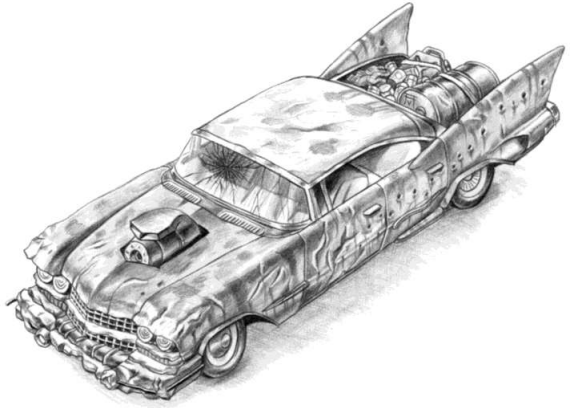
Vehicles
A combination of a massive oil crisis and popularity of Cold War era cars, most pre-War vehicles of Exodus look like 50s muscle cars but run on fusion cell batteries rather than traditional fuel. There are only four vehicles, so not a lot to go through here. The Cobra Impaler is a totally-not-Chevy-Impala two seat car that tears across the Wasteland at a speed of 350 feet per round but eats up fusion cells at 25 miles per cell, the Colt Switchblade is a generic 50s motorcycle that travels 250 feet per round at 50 miles per fusion cell and has an optional sidecar attachment, and the dune buggy moves 150 feet per round but makes up for it by seating three and great mileage at 40 miles per fusion cell. Oh, and then there's the Roadmaster MK IV. While stated to be just an average family car, this six seat, 250 feet per round, 15 mile per fusion cell beast is quite literally built like a tank. It has the same object hardness as military vehicles in d20 Modern, and it has 350 HP to soak up damage with. This is far more than even an M1 Abrams in d20 Modern (64 HP), but since even the humble dune buggy here has 150 HP I'm imagining that the writers of Exodus weren't fans of the low hit point pools d20 Modern used for vehicles.
Next Time
Now that equipment is out of the way and we're halfway through the book, it's all smooth sailing on the way downhill. Next post finishes the Exodus: Post-Apocalyptic Roleplaying Survivor's Guide with rules on radiation, rehab, and rubble, as well as advanced classes that don't always play by the rules.
Combat and Tactics, Advanced Classes
Original SA post
Chapter 5: Combat and Tactics
While this chapter takes up a fair chunk of the remaining third of the book, most of it is reprinted standard d20 combat rules since this is Exodus and we have to follow the "reprint all the core rules" methodology to the end. There are a few things that prevent me from completely skipping over this chapter, though, so let's get those out of the way.
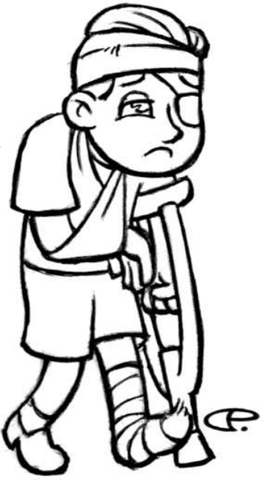
Targeted Attacks
Targeted attacks, or “called shots” as they are more often called in RPGs, are anything meant to be more specific than just a generic meat shot to wherever (often the torso, which has no special rules for targeting or damaging it). This chart is important because it gives you very important information, such as that you take a -6 penalty to your attack role to shoot someone in the dick, but the result is 50% more damage on a regular hit or three times more damage on a critical hit. And no, I'm not being hyperbolic. Groin (or “servos” on a robot) is indeed one of the listed options for making targeted attacks. Of course, if you want to do something more practical than making everyone in the Wasteland impotent, there are also six other listed types of targeted attack as well. A targeted leg (or attack to whatever the creature or robot uses to move if it has no legs and feet) is the easiest at a -2 penalty to attack rolls, but on a critical hit the target gets a -4 penalty to Dexterity-based skill checks that involve legs, moves at half its normal speed, and cannot run. A targeted arm is a bit more at -4, and on a critical hit you end up removing the target's ability to use any items that have to be used two-handed and induce a -4 penalty to Dexterity-based skill checks that require the use of both hands.
These two do provide a bit of a problem, though, when at a -8 penalty you have foot and hand targeted attacks that only induce the skill check penalties on a successful critical hit. This means that it's both better and easier to just go for a shot at the arm or leg rather than specifically the hand or foot. Unrelated to manipulation, a targeted head (or CPU for a robot) attack deals double damage on any hit and also conveys 4 points of Intelligence and Wisdom damage, while a targeted eye /sensor/feeler/whatever the creature uses to sense the world around it shot also deals double damage on any hit and is capable of blinding the target on a critical hit.

Environmental Hazards
While d20 Modern has its own radiation system wherein time spent in an area of a certain strength of radiation resulted in saves against a specifc strength of radiation sickness, Exodus throws that out in favor of its own take on radiation. And by “its own take”, of course, I mean something akin to Fallout's take. Radiation is measured by the RAD (Radiation Absorbed Dose) level of an area, and characters that fail a Fortitude save at each time interval listed take the listed amount of radiation damage rather than having the dosage ramp up based on time spent in the area overall as in standard d20 Modern. Weak radiation is 1 to 99 RAD and deals 1d2-1 Constitution damage every three days of exposure, light is 100 to 199 RAD and deals 1d3-1 Con damage every day of exposure, mild is 200 to 299 RAD and deals 1d4-1 Con damage every six hours, low is 300 to 599 RAD and deals 1d6-1 Con damage every two hours, moderate is 600 to 999 RAD and deals 2d4 Con damage every half an hour, high is 1000 to 4,999 RAD and deals 2d6 Con damage every five minutes, severe is 5,000 to 8,000 RAD and deals 3d6 Con damage every minute, and deadly is anything higher than 8,000 RAD, deals 4d6 Con damage every round, and has a 1% of turning a human into a ghul rather than killing them.
Another form of environmental hazard added by Exodus is toxic waste . It's basically acid, dealing 1d6 acid damage per round of exposure or 10d6 per round if you're straight up dunked in it, but has the added effect of counting as a source of low radiation. There's also structural failures , because why wouldn't you have those in a ruined post-apocalyptic world (even though a lot of post-apocalyptic roleplaying games I've read don't, surprisingly)? There's a cumulative 10% chance per floor that there is at least some structural damage that should be rolled up by the GM: this 10% starts at the first floor for structures that head upward such as skyscrapers, and at the last floor for structures that go downward such as vaults. It's entirely up to the GM what exactly collapses where as is appropriate to the party, ranging from 1d6 damage if you fail the DC 15 Reflex save to avoid minor falling debris to taking a whopping 12d6 damage if you fail the DC 30 Reflex save to avoid the total structural collapse of an entire floor.
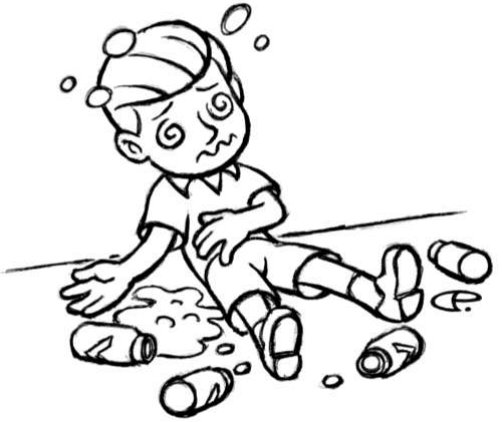
Chemical Addiction
Don't do drugs, kids. Not only do they have after-effect penalties as listed in my last Exodus post, but if the d100 says you are in the percentile range to get addicted, you also have additional addiction penalties! Unlike the ability damage that heals over time from drug after-effects, addiction penalties are effectively like the penalties of a template, static minuses that are removed once you “lose” the addiction by making a successful Fortitude save with a DC between 30 and 45 depending on the drug. You can make this check once per day, and every consecutive day adds a +1 to your save unless you end up taking the drug again. Taking the drug again does temporarily remove the penalties for addiction for the drug's duration, but it doesn't remove the addiction outright, and of the after-effects stack with previous usage of the drug.
Specific addiction “templates” are -2 Constitution and Wisdom for afterburner, blindness for black sunshine, blindness or deafness for burnout, -8 Dexterity and a -4 to Initiative checks for inferno, a -4 to Intelligence and Wisdom for mindmeld, -8 Strength and -4 Constitution for mutagen, -6 Strength and Dexterity for vigoroids, and -6 Dexterity and -2 to Initiative checks for voodoo.
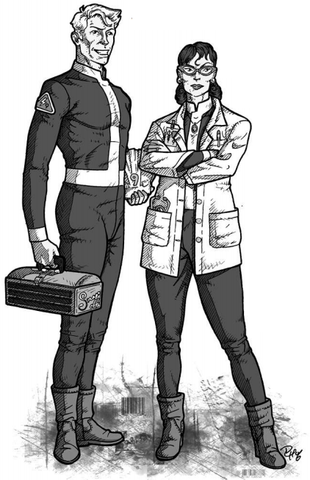
Advanced Classes
On top of reprinting almost all classes the d20 Modern Core Rulebook (the Bodyguard, Investigator, Negotiator, Personality, and Techie are the exceptions that are left out), the Archaic Weaponsmaster (renamed to just Weaponsmaster even though it still only focuses in archaic weapons), Glamourist (renamed Socialite), Shadow Hunter (renamed Bounty Hunter), Street Warrior, and Thrasher from Urban Arcana, and the Dreadnought, Explorer, and Swindler from d20 Future, there are fifteen new advanced classes introduced in the Exodus Survivor's Guide.
Some of these new advanced classes don't follow the basic rules of what an advanced class is. Wizards of the Coast codified advanced classes as being ten levels long, usually having a bonus feat at level 3, 6, and 9, and able to be accessed by a character who has focused on the right prerequisites by the time they take their fourth character level. Here there are five level advanced classes and advanced classes that cannot be accessed until further on than level 4, which I assume is a holdout from being more familiar with Dungeons and Dragons prestige classes, but it could be worse. I say “it could be worse” in confidence because I know there are advanced classes with weird layouts like three or seven levels in the next Exodus book.
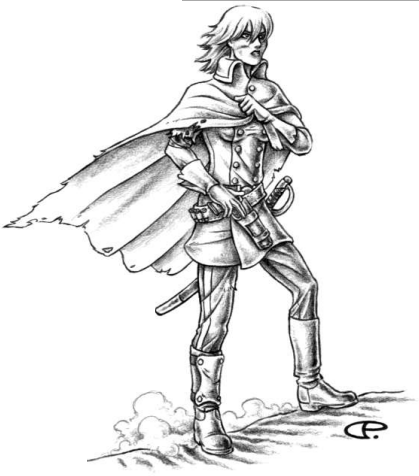
Desert Ranger: Want to be a mental hero with a combat advanced class, but just can't settle for the +1 to +3 bonus to attack rolls and certain skills against a single target at a time that you'd get with the
No, that's not right at all, you silly person. While the level 1 class feature for the Desert Ranger is just getting Endurance as a bonus feat, its main class feature that first appears at level 2 is that D&D Ranger standard of Favored Enemy . The Ranger selects a specific group type – animals, desert reapers (though just what a desert reaper actually is isn't ever explained in this or any of the other Exodus books), ghuls, geckos (which are on their own rather than under animals for some reason), Trans-Genetic Mutants, vermin, or a specific human organization – to have a +1 bonus to attack rolls and Bluff, Listen, Sense Motive, Spot, and Survival checks against. While the Desert Ranger gets to select another Favored Enemy at level 4, 6, and 8 of the class, the bonus is always just +1. It never progresses any further like the Bounty Hunter's bounty target class feature, and you can't select the same Favored Enemy twice to boost the bonus.
In spite of this, though, the Desert Ranger isn't a totally useless class. For stealth-related abilities, level 3 of the class lets you move normal speed while tracking with the feature Swift Tracker , and level 7 has Camouflage which is basically the D&D Ranger's Hide in Plain Sight ability. If combat's more your focus, there's a bit of htat too. The level 5 class feature Combat Shooting lets you basically perform the function of the feat Power Attack with ranged attacks rather than melee attacks and doesn't require you to have said feat, and the level 9 feature Adapted Warfare gives you a +1 bonus to attack and damage rolls in either indoor, outdoor urban, or outdoor wasteland environments...which is actually pretty shitty too for a class level 9 ability, but still.
The capstone ability for the Desert Ranger is Squad Leader , which makes party members and friendly NPCs within a 20 foot radius of the ranger gain a +1 morale bonus to attack rolls. This isn't exactly amazing on its own, especially compared to the things the Field Officer from d20 Future can do that could have been cribbed for this class, but what saves it from being useless is that it can stack with the Squad Leader ability of other level 10 Desert Rangers. Assuming your whole party is Desert Rangers, you can just have a big ol' attack buff circlejerk as long as you stay in formation.
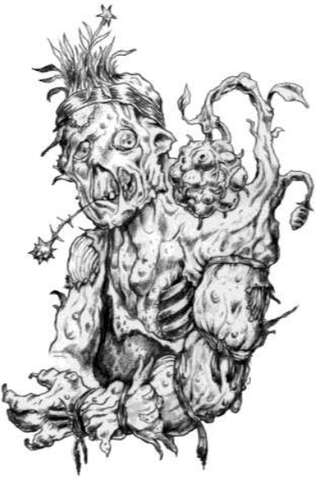
Harvester: I remember Harold too, Exodus, thanks for reminding me. Harvester characters are technically the results of someone being gooped in the weird superscience chemicals that make up the
Unsurprisingly, the Harvester's class features are all plant-themed. Fungus at level 1 grants 1 PDR because of layers of moss and bark-like skin, Green Thumb at level 2 lets the Harvester grow plants twice as fast as normal and “speak” with plants to learn local environmental conditions by tending to them for two hours, and Bonsai at level 3 causes the growth of a tiny tree on the ghul's head or torso that provides a +4 bonus to saves against disease and poison thanks to its healing nutrients. The tree has its own pool of HP (20, to be precise) and can be struck with a called shot at a -6 penalty to the attack roll, but if it's destroyed it will regrow three months later rather than disappear forever.
The biggest class feature of the Harvester, though, comes in Way of the Fruit at level 4 of the class. Every ten days, the tree on the Harvester dumps a piece of lumpy green fruit that provides a random effect when eaten by anyone. This can be either a +2 bonus to one ability score for half a day, a +2 bonus to one saving throw for half a day, induce the nauseated condition for an hour, induce nausea for two hours, induce nausea for three hours, instant curing of all diseases, instant curing of all poisons, instant curing of all addictions, instant removal of any drug after-effects, instant removal of 200 RAD, instant removal of all radiation effects, restore 1d4 HP, restore 1d8+1 HP, restore 2d8+3 HP, restore 3d8+5 HP, or do nothing at all. This is furthered by the final ability of the class, Shape Fruit. This allows the Harvester to make a Will save (DC 15 to 18 for most effects, though some of the more powerful healing ones get up to DC 35) to coerce the tree into making a specific desired fruit.
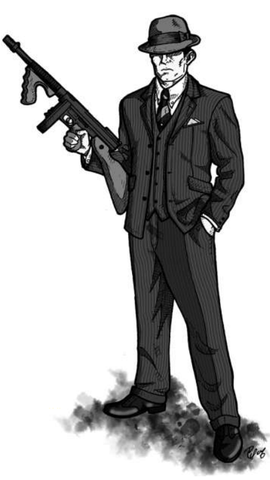
Made Man: A stereotypical old school mobster, the Made Man is all about serving the Family, maintaining a code of honor amongst thieves, and shooting people up with Tommy guns. It's a somewhat difficult advanced class to get into, because on top of needing a +5 Base Attack Bonus (so that's at least five levels in Strong Hero alone to get), either the Gangster background or Wiseguy occupation, and a rather stunning 50% Reputation with a crime syndicate, you also have to have saved the life of either the head of the Family or some other important Family member in the group. While you might think that last prerequisite might lead to the class having some enforcer themes and defensive capabilities to offset the absence of the Bodyguard advanced class, you'd be totally wrong. This is a straight up combat class through and through: Good Base Attack Bonus progression, average Fortitude and Reflex save progressions, poor Will save progression, poor Defense bonus progression, and d8 hit dice.
Two of its class features are of the sort that rank up. Street Cred provides a bonus to Diplomacy, Intimidate, Investigate, and Gather Information checks with anyone who is part of the Family or familiar with the Made Man's status as part of the Family, the bonus starting at +2 at class level 1 and then boosting to 4 at level 5 and +6 at level 9. There's also that ever popular D&D Rogue staple of Sneak Attack , going +1d6 at level 3, +2d6 at level 6, and +3d6 at level 9. For other class features, there are bonus feats at level 2, 6, and 10 that are mostly either melee combat- or firearms-oriented, Soldier at level 3 grants a free Infrequent or lower rarity firearm and concealed mesh suit courtesy of the Family, level 4 has Magnetic Personality as specified bonus feat, Connected at level 7 grants a contact as per the Investigator from d20 Modern Core, Respected at level 8 lets the Made Man get lodging, food, and prostitutes for free in any town or city where the Family holds sway, and Right Hand of the Devil at level 10 makes it so that there's a chance equal to the Made Man's Reputation percent with his Family that members of other gangs (including raiders and slavers) will either run away or grovel rather than fight.
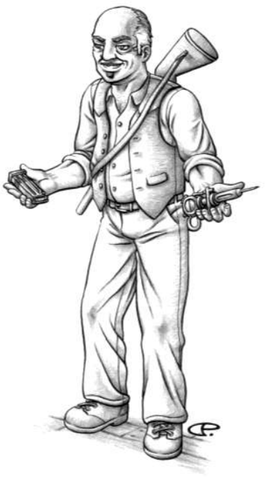
Trade Master: A class designed for someone who really, really loves the Barter skill added to Exodus. The Master Trader isn't entirely shit in a fight, though, believe it or not. While the class has a poor Fortitude and Reflex save progression, it has an average Defense and Base Attack Bonus progression and d8 hit dice to toughen it up, as well as a good Will save progression for combat and non-combat issues. Alas, it's also a class that gets one-time bonuses. The first feature you'll encounter by entering the class is Trade Assets , which is straight up 500 coins for free. This class feature is also used twice more, granting 1,000 coins at level 5 and 2,500 coins at level 9. The other most prevalent class feature is Deal Maker . This grants the Trade Master an extra bonus to prices when buying or selling on top of the results from a successful Barter check, which starts out at 5% at class level 2 and increases by a further 5% every even numbered level of the class.
There are also two abilities the Trade Master has that put pressure on others. Proper Motivation , gained at level 5 of the class, allows the Master Trader to take a full round action to convince some dumb NPCs (rather than a specific number and level limit, the total people that can be convinced by this ability are measured in HD up to the Trade Master's Charisma modifier plus ten) that they'll be richly rewarded for going and shooting up some other person. They get a +1 to attack rolls for a number of rounds equal to the Trade Master's levels in this advanced class, so it's really a minor boon that ends up being a pain later when you end up having to pay up. More powerful, and somewhat sinister, is the capstone class feature Everyone Has a Price . The Trade Master can make a Barter check modified by their class level opposed to an NPC's Sense Motive check modified by said NPC's class level, and if successful the target must buy something from the Master Trader. It doesn't even matter if they don't have enough money, so using this ability could allow a Trade Master character to fleece their way across the Wasteland and buy whatever their party desires.
In between all of those abilities, you've finally got a handful of less bombastic class features. You've got Snake Oil Salesmen at level 2 giving a +2 to Bluff checks made to pass off defective items as properly working ones, Caravan Navigation at level 3 reduces overland travel times by 25%, Superior Barterer grants a +2 to Barter and Bluff checks at level 4 that increases to +4 at level 8, Assistant at level 7 grants a cohort that must have a class level layout of Defensive/Master Trader and have the Merchant occupation, and Deal Shark at level 9 stacks the Trade Master's ranks in Intimidate and Barter for the purpose of making Barter checks.
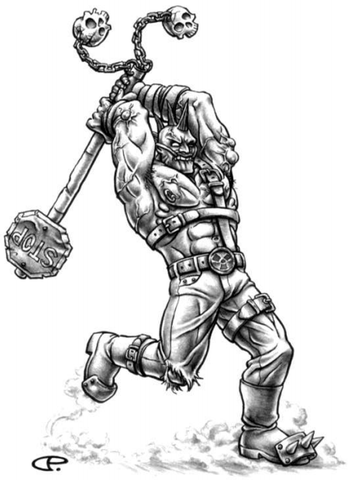
Mutant Berserker: A simple class for a simple character. This five level Trans-Genetic Mutant only advanced class is designed purely around tanking damage and then dishing damage out, nothing more and nothing less. Full Base Attack Bonus progression, good Fortitude save progression, and d12 hit dice offset by poor Will, Fortitude, and Defense progression reflects the class's nature as a big slab of meat who's too stuffed full of HP to care about how often enemy hits connect.
At levels 1, 3, and 5, the Mutant Berserker progresses in two different class features. One improves the Trans-Genetic Mutant's innate damage reduction by +1 each time, while the other is a self-buffing ability known as Adrenaline Rush . Adrenaline Rush is sort of like a D&D Barbarian's rage, except that instead of starting as a +4 buff to Strength and Constitution and a +2 to Will saves, it's a +2 buff across all three physical ability scores. This is boosted to +4 at level 3, and again to +6 at level 5. The other two class features the Mutant Berserker gets both boost Adrenaline Rush. Destructive Rage at level 2 lets the Berserker ignore 5 points of damage reduction or 10 points of an object's hardness with melee rolls during the adrenaline rush, while Berserk Frenzy at level 4 doubles all melee damage made during the adrenaline rush. It's kind of refreshing to take a breather with a class that isn't complicated or long-winded to discuss at all.
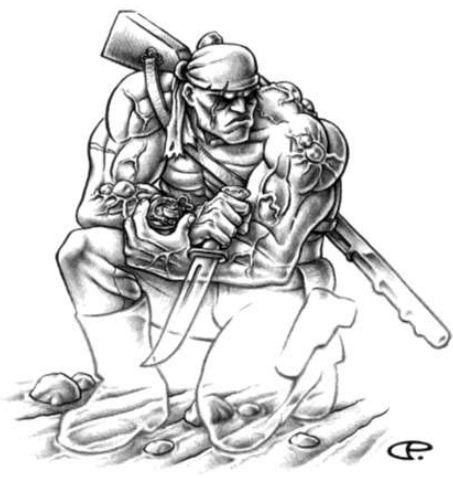
Mutant Commando: For those in the audience that aren't all that familiar with Fallout, there is a variation of Super Mutant called the Nightkin that were effectively the elite troops of the Super Mutant Army: just as big and strong as their brethren, but also smart, stealthy, and trained in advanced combat techniques rather than “hit stuff until it looks dead enough”. The Mutant Commando is effectively the Exodus way of handling Nightkin. It's a Trans-Genetic Mutant only class that requires an individual who intentionally statted themselves up to bypass their natural penalties, as Intelligence 12 or higher is needed to enter on top of a +5 Base Attack Bonus. It's an above par advanced class from a progression standpoint, with full Base Attack Bonus progression, good Fortitude save progression, average Reflex save progression, poor Will save and Defense bonus progression, and d10 hit dice.
Are its class features quality stuff as well? Definitely. While the level 1 ability Improved Stealth just provides a +4 to Hide and Move Silently checks (doubled to +8 in dimly lit areas) and bonus feats selected from a list focused around melee combat and stealth at levels 3, 5, 7, and 9, at level 2 you get Sneak Attack +1d6 that increases a further 1d6 at levels 6 and 10. Sneak attack on a character that's got full BAB progression and stealth bonuses? Scary stuff, there. Oh, but it gets better. Leave no Enemy Alive at level 4 lets the Mutant Commando get a coup de grace on a foe they knock unconscious as a free action rather than a full round action, and at level 8 this ability is boosted even further by letting the Mutant Commando ignore the attack of opportunity condition that performing a coup de grace normally invokes. Could it get even better than that? Well, hold onto your seats, because Death Strike at level 10...acts as Improved Critical for all attacks. Kind of a lackluster finish after the murderkill abilities.
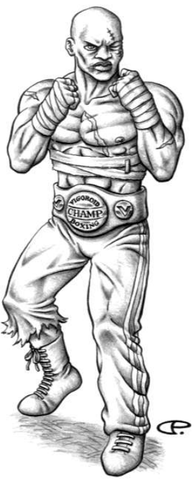
Prizefighter: A five level class focused on mixing unarmed combat with charismatic actions, the Prizefighter has d10 hit dice, a full Base Attack Bonus progression, average Fortitude, Reflex, and Defense progression, and poor Will save progression that actually does have prerequisites that allow you to take it at character level 4. By contrast, with the Urban Arcana advanced class Street Warrior (which is reprinted in this book, I'll remind you), you have the same full BAB progression and average Defense progression over a whole ten levels rather than five, good Fortitude save progression at the cost of Reflex being knocked down to poor, and you get 5 plus your Intelligence modifier worth of skill points each level as opposed to the jaw-droppingly low 2 + Int the Prizefighter gets. Maybe I’m being too harsh, though. Maybe this class has some amazing abilities packed into this five levels that make up for it being otherwise unimpressively squashed down.
We've got free Knockout Punch as a bonus feat at level 1, Improved Knockout Punch bonus feat at level 2, and Whirlwind Attack bonus feat at level 3, as well as an extra talent from the Hand to Hand talent tree at level 2 and 5. Good, good, things that you could have more variety with If you just stayed with a base class are clearly a good sign for an advanced class. Oh, and at level 4 there's a class feature called Work the Crowd that literally does nothing. You make an Intimidate check to get the crowd to jeer your opponent, and...something. It doesn't say, just that it gives the Prizefighter an advantage.
Not all is lost, at least, as there are a few serviceable pieces in this otherwise shambling wreck of a class. At level 1 Taunt , which lets you gain a +2 bonus to attack rolls for the duration of a fight against an opponent that fails a Will save, and that bonus improves to +4 at level 3. You've also got Contender at level 4 that lets you gain money for engaging in an overseen fighting circuit bout (100 coins per class level of the opponent for winning, 25 per level for losing), and Finishing Blow at level 5 lets the Prizefighter make a Spot check to automatically score a critical hit on a foe that is down to their last quarter of HP.
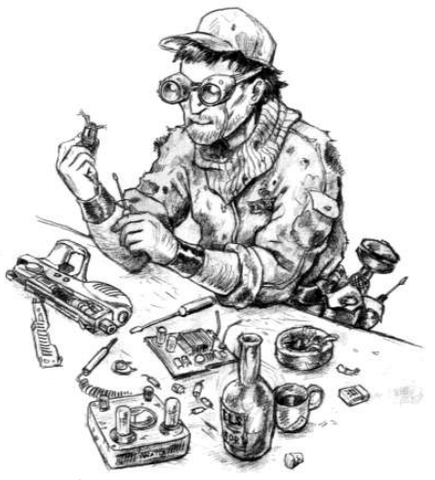
Rigger: This class is fairly clearly intended to be a replacement for the Techie, which makes sense. The Techie was always a really weird class choice in d20 Modern Core Rulebook, as it has class features that focus on creating robots while the more modernistic Engineer advanced class was put in d20 Future. This isn't “let's discuss Wizards of the Coast's odd decisions”, though, so on to the Rigger. Good Reflex progression, average Base Attack Bonus and Defense progression, poor Fortitude and Will save progressions, and d8 hit dice are the framework we've got here. Surprisingly, while this is clearly meant to be a skill monkey class, it only gets 5 + Int skill points a level, when d20 Modern tends to grant such classes 7 + Int. I can only assume between this and the myriad of 2 + Int classes such as the Mutant Berserker, Mutant Commando, and Prizefighter that someone working on Exodus just hated high ranks in skills.
Starting off, a level 1 Rigger gets two class features: Improvised Tools lets the Rigger ignore the penalty to Repair checks made without a tool kit, while Jury-Rig lets the Rigger use the jury-rigging use of the Repair skill without penalty. The latter actually gets boosted to a +2 bonus rather than a penalty at level 3, and again to +4 at level 6 and +6 at level 9. Also on the more minor side, there's Builder as a free bonus feat at level 2, Advanced Rigging at level 6 allows for taking 10 on a Repair check even when threatened or distracted, and Super Rigger at level 10 does the same thing for taking 20.
The meatiest parts of the Rigger, though, are the class features meant to to allow for manipulation of technology. The first of these that shows up is Rig Firearm at level 2. With this class feature, the Rigger can jimmy up a temporary fix for a broken personal firearm with a DC 15 Repair check, allowing it to work as it normally would for a number of rounds equal to one plus every point over the DC the Rigger succeeded the check. This feature gets expanded to allow the rigging of heavy weapons for DC 20 at level 5 and then energy weapons for DC 30 at level 9. Rig Vehicle at level 4 takes the same principle and applies it to vehicles, the DC being 25 and the running time being upped from minutes to hours. There's also Persuade Malfunctioning Device at level 7 that is DC 30 for the same thing on generic mechanical or electronic equipment (and is again measured in hours), and at level 8 Rig Technological Device lets the Rigger make a DC 35 Repair check to hack a computer or bypass security devices.
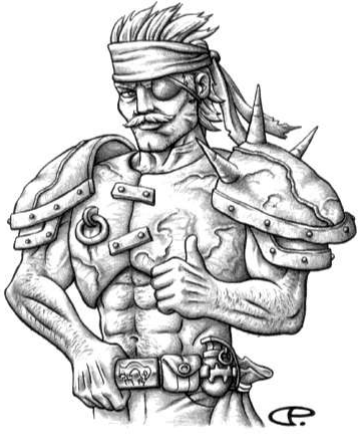
Slayer: It's hard to imagine that a class entirely dedicated to killing things better is one of the worst ones in this book, but here we are. You'd need to take at least eight levels of a full Base Attack Bonus class to get to this five level entry here. You've got d12 hit dice, full Base Attack bonus progression, good Reflex save progression, and poor Will save and Defense bonus progression, but nobody really goes into low level count classes for those numbers, they're here for the class features. And here they're pretty lackluster for something you'd be building a character over eight levels for. Better Critical as a bonus feat for one melee weapon at level 1 and level 3, More Critical as a bonus feat for one melee weapon at level 3 and level 5, and Living Anatomy as a bonus feat at level 2 are the main features of the class. The only class features that aren't "here, we'll pick a bonus feat for you" are Bypass Armor at level 3, which ignores five points of PDR, and Death Stalks the Land at level 5, which makes you spend three full round actions watching a flat-footed, flanked, or helpless character in order to make a save-or-die melee attack.
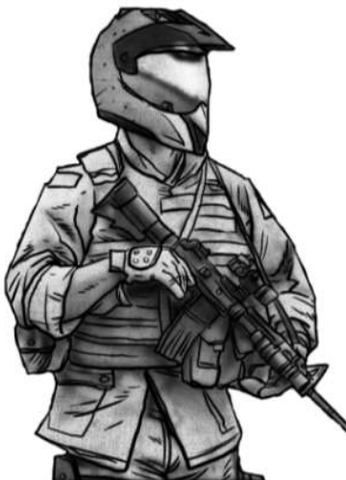
Sniper: Basically the Slayer, but for firearms. I wish I wasn't joking. Rather than having Bypass Armor, you've got Bypass Cover , which ignores characters in one-half or less cover, and One Shot, One Kill is a replacement for Death Stalks the Land that can hit any unaware target not immune to critical hits but only causes an automatic critical hit rather than a save or die attack.
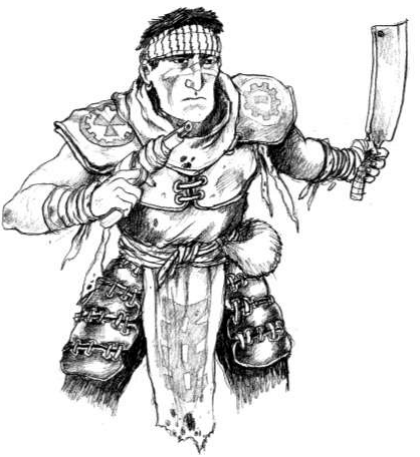
Steel Disciple Initiate: The Steel Disciples are the only organization that get any advanced class in the Survivor's Guide rather than the Southwest Wasteland Guide, presumably because they are the not-Brotherhood of Steel and everybody loves the Brotherhood of Steel. They're all five levels long, mainly because the Steel Disciple Initiate is meant to be the “first half” of the other classes to the point that both require all five levels in Steel Disciple Initiate to enter. This means that all Steel Disciples members start their careers with this five level class that has a full Base Attack Bonus progression, poor Reflex save progression, average Will and Fortitude save progression, average Defense bonus progression, and d10 hit dice.
Hopefully you like items and bonus feats, because that's what comes with the class features. Basic Training at level 1 grants Weapon Focus with one weapon the Initiate is proficient with, Initiate at level 2 grants a free personal firearm or archaic melee weapon that is Infrequent or lower scarcity, Senior Initiate at level 3 grants the choice of Brawl, Defensive Martial Arts, Dodge, Power Attack, Weapon Finesse, or Weapon Focus as a bonus feat, Advanced Training at level 4 grants one Exotic Firearm Proficiency as a bonus feat, and Initiation to BoS (hmm, looks like something got missed in the editing of the book here) at level 5 means the Initiate can enter the Steel Disciples Knight or Steel Disciples Scribe advanced class and gets a free suit of combat armor.

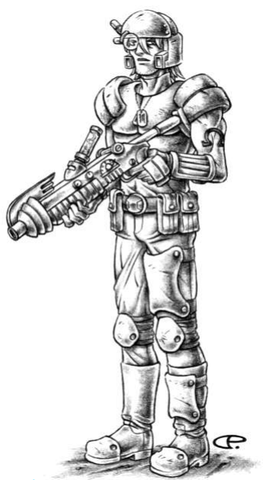
Steel Disciple Knight: Second only to the Cavaliers and Paladins (which aren't covered until the Southwest Wasteland Guide), the Knights of the Steel Disciples are some of the most respected warriors of the Steel Disciples. The framework is a five level class that has full Base Attack Bonus progression, average Fortitude and Reflex save progression, poor Will save and Defense bonus progression, and d10 hit dice. Surprising that the Knight has worse overall progression than the Initiate when it's meant to be a direct improved version of that class that can, indeed, only be entered through said class.
Features-wise, the first one on the table is Favored Enemy at level 1, 3, and 5. This mostly works the same as it does in the Desert Ranger – or, indeed, the D&D Ranger – with the exception that there is a limitation on the favored enemies. Steel Disciple Knights can still take ghuls, Trans-Genetic Mutants, or a particularly organization as a favored enemy, but don't get access to any of the wildlife options for whatever reason. Awareness and Exotic Firearms Proficiency (Energy Weapons) as bonus feats follow at level 2, and a free suit of power armor is granted at level 3. Beyond that, Tactical Master at level 4 grants a +1 cover bonus to existing cover bonuses when taking cover, and Bolster Troops at level 5 grants a +1 bonus to saves against fear for all Steel Disciples within a 60 foot radius. Again,

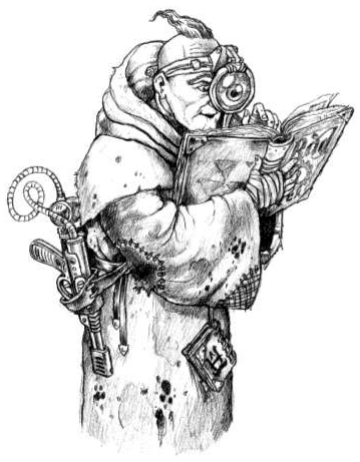
Steel Disciple Scribe: Meet the class that has the distinction of being the only one in Exodus that has d6 hit dice for its level-based HD. Its other framework is poor Base Attack Bonus and Fortitude save progression, and average progression for everything else. And what of class features? At level 1, Research halves the time made to make Research checks when the Scribe is at the archives of a Steel Disciples bunker, and Skill Mastery allows the Scribe to select a number of skills equal to three plus his Intelligence modifier, and be able to take 10 on those skills even if distracted or threatened. Bonus feats at level 2 and 4 (selected from a handful of feats associated with either information or crafting) are accompanied by Exotic Firearms Proficiency (Energy Weapons) as a non-selectable bonus feat at level 2 and a free suit of power armor at level 4. Finally, you've got Technology Master at level 3 granting a +2 to Craft (Mechanical and Electronic) and Knowledge (Technology) checks, and The Collective at level 5 granting a +10 bonus to all Knowledge and Research checks as long as the Scribe is in the archives of a Steel Disciples bunker.
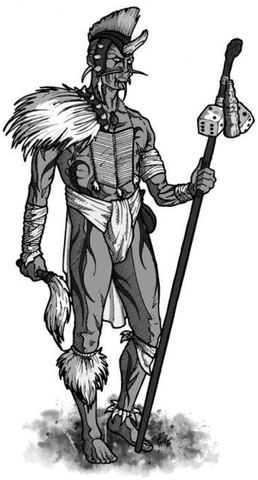
Tribal Shaman: Oh hey, yet another five level advanced class meant to be taken at earlier levels for questionable gains. Those have been so good to us so far, so clearly this one must be good! The Shaman has good Will save progression, poor everything else, and d8 hit dice, so nothing to really dwell on before heading right into the class features. Like the Steel Disciples Scribe, there are two at level 1 of the class. Meditation allows the Tribal Shaman to take a chem and spend an hour in solitude in order to gain a vision. This doesn't actually do anything at level 1 besides blow some chems that don't convey the normal benefit of after-effects associated with the chem, but gets actual benefits later: Brew Tribal Remedies at level 3 reduces the Craft DC of antidotes, healing powder, and any chem the Tribal Shaman meditates with by 5, Blood of the Ancestors at level 4 grants 2d6 temporary hit points to allies whose total levels are equal to the Tribal Shaman's character level for one hour after meditation, and Visions of the Ancestors at level 5 grants a +1 insight bonus to Defense and Reflex saves for a number of hours equal to five plus the Tribal Shaman's Wisdom modifier.
The other level 1 class feature, Voice of the Ancestors , allows the Tribal Shaman to perform a chant that grants a +1 inspiration bonus to skill checks and saves against fear effects to all allies within hearing range for as long as the chant is kept up, and then three rounds thereafter. Level 2 brings Strength of the Ancestors , an ability that allows the Tribal Shaman to call upon their ancestors a number of times per day equal to their number of levels in this class. By spending a full round action praying to the ancestors in such a manner, the Shaman gets a +2 bonus to Strength, Constitution, and Wisdom for a number of rounds equal to their total class level, which is actually surprisingly good for a five level class in Exodus.
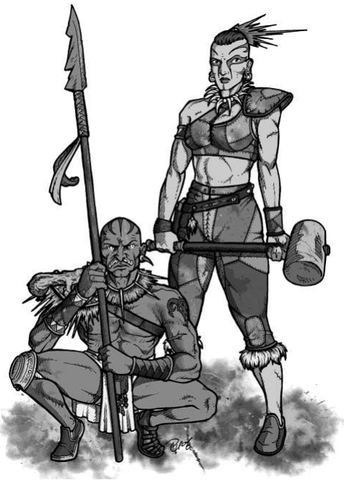
Tribal Warrior: Finishing off, we've got the Tribal Warrior, a ten level advanced class that can be taken after only a single level in a base class and focuses on combat. It's got a framework of good Base Attack Bonus progression, average Fortitude and Reflex save progression, poor Will save and Defense bonus progression, and d10 hit dice. It also manages to start right out of the gate with a pretty useful starting class feature, Desert Survival . This ability means the Tribal Warrior only has to make saves for searing heat every thirty minutes (rather than every ten minutes) and even then only do so after an hour's grace period, go without water for three days rather than one, and go without food for five days rather than three. While it wouldn't be that big of a deal in an average game, in one where you are expected to keep track of survival conditions – which, of course, Exodus does – it's a nice boon.
On top of being able to select a variety of survival, combat, and movement-related bonus feats at the normal-for-advanced-class bonus feat levels of 3, 6, and 9, the Tribal Warrior also gets three other bonus feats as class features. While Better Critical and More Critical are bonus feats at level 4 and 8, Tribal Weapon Master at level 3 is a bit of a unique one. It effectively grants the Tribal Warrior the Weapon Focus feat eight times at once, but for specific weapons: namely, the club, knife, javelin, pipe, rock, shortbow, spear, and unarmed strikes. The two remaining class features are also not shit, so we're actually ending on a good note. Ancestral Fury is straight up D&D Barbarian-style rage that can be used once per day at level 5 and twice per day at level 10, as well as any number of extra times per day by spending a Karma Point, and Wasteland Resistance at level 7 grants a +4 bonus to saves against poison and radiation and immunity to radiation 300 RAD or less.
Next Time
The Exodus trifecta continues with the Southwest Wasteland Guide, the Game Master's Guide to the Survivor's Guide's Player's Handbook. While there will be a few things that fall away from Fallout, such as the Super Mutant equivalent of half-orcs and furry soldiers, it's also the book that covers organizations and locations such as the Families of Las Vegas, the drug-running Khans, the brutal Mutant Army, and of course the Steel Disciples.
Southwest Wasteland Guide: Character Options
Original SA postHey there, FATAL and Friends thread. It's been a while, hasn't it? Long story short, a lot of shit has gone down over the past few months that shook up my writing confidence a fair bit, but I'm back now. I heard that there's interest in a GURPS Technomancer writeup, and as fascinating as that sounds, right now there's the more pressing matter of actually managing to finish what I started. Yes, it's time to once again look into the copyright edge-skimmer that is...
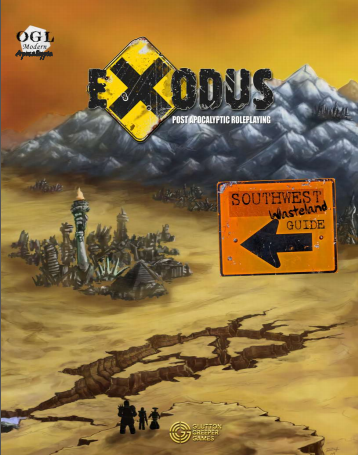
The Southwest Wasteland guide is, as I've stated before, the Game Master's Guide equivalent of the core trilogy for Exodus: Post-Apocalyptic Roleplaying. Within we start to see some attempts to break free from the Fallout framework, but there will still be a lot more stuff that is "not-Fallout" than is actually
not
Fallout. It wasn't until Glutton Creeper Games ran out of prewritten material entirely and had to forge their own path with Exodus: The Texas Regional Sourcebook that you start getting actual new things unrelated to Fallout like cultists of Chuck Norris and an empire of oil well technopriests.
Of course, that's not where we are now, so let's look to the present with character rules. At the advice of others I'm going to be making a lot less focus on the specific mechanic bits and bobs of each new occupation or feat now, instead speaking in generalizations to get the flow moving forward at a more reasonable pace. There are still times where they'll be the focus, like for classes and the like, but I'm doing my best to try to cut out overly explaining mechanics. Alas, the front of the book is where most of the mechanics are.
Chapter 1: Character Options
Player Races
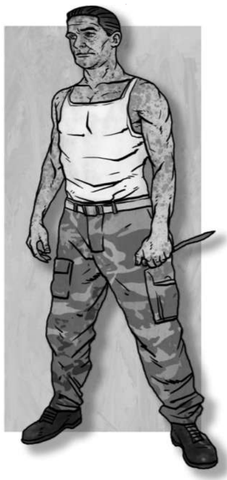
Bio-Genetic Mutant:
One trait of Fallout's Super Mutants are sterile, only capable of "reproducing" by dunking others in pits of the Forced Evolutionary Virus formula. Exodus decided that apparently that was one of the places where it would be good to diverge from its source material, and as such as have the horrifying factoid that Trans-Genetic Mutants started creating rape slave camps in 2024 to help offset the lowering numbers of the Mutant Army. The pregnancies had a 90% fatality rate for the human mothers, but a 100% success rate in creating half-human hybrids dubbed Bio-Genetic Mutants. BGMs look like regular (albeit muscular) humans with either grayish or jaundiced skin, and were capable of breeding true, leading to a faction of the Mutant Army suddenly having the epiphany of "oh wait, slavery and rape are
bad
things, aren't they? We should have these guys breed with each other willingly rather than have rape slave camps" and deciding to fuck off to Utah and create their own secret base made up of a few Trans-Genetic Mutant scientists and all of the Bio-Genetic Mutants. Mechanically, Bio-Genetic Mutants get a +2 to Strength but -2 to either Wisdom or Charisma, a +2 bonus to Fortitude saves against disease and radiation, and 1 PDR.
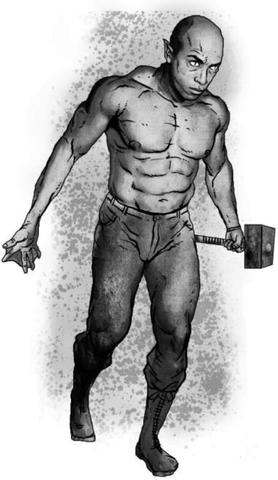
Symbiotic Mutant:
Another being with no real connection to Fallout that I know of, symbiotic mutants are even older than the Trans-Genetic Mutants. These fellows have been around since World War II, when the Manhattan Project managed to create a serum called "the Symbiote Strain" that could make a human into an animal-human hybrid. These early experiments were failures, however, with the experiments going insane and escaping into the wild where they would become the source of Bigfoot legends. A version of the formula that wouldn't create crazy people didn't arrive until the War on Terror, when it was briefly utilized by US advanced agents. This is the last the Symbiotic Strain is heard of until 2032 when some merchants gain access to the military stores of the serum and decide it's somehow a good idea to sell it as a recreational drug without even finding out what the hell it does.
The only thing mechanically certain about symbiotic mutants is that they are immune to all standard drugs/chems. Beyond that, they're a grab bag of random potential abilities: each symbiotic mutant gets to choose two special qualities and one “side-effect” quality. For the two special traits, the symbiotic mutant gets to choose from a grab bag of animal-themed powers: leaping, gills, scaly defenses, a bite attack, all that jazz. You also have to choose one side-effect. The side-effects (read: penalties) are mostly Charisma-based. Slitted eyes, patagia, and a muzzle are but a few of the wondrous ways you can get people to hate you and cripple your social interaction skills. You can also get things like ape-like arms that impede your ability to draw weapons quickly, or deer-like legs that reduce your move speed (??).
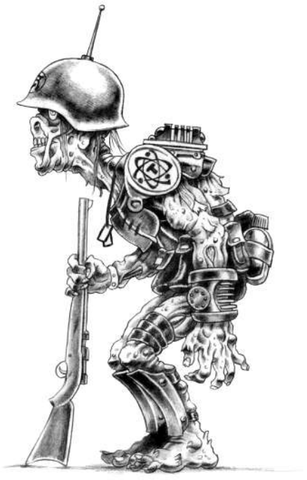
Dreg:
Ghuls that were created from specially trained soldiers. Dregs have a penalty to Charisma rather than Strength and have to take a military-related feat as their second starting feat, but are otherwise exactly the same stats-wise as standard Exodus ghuls. All in all they are kind of a pointless addition, as you could really just have a ghoul with the Military occupation for the same concept.
Backgrounds
Cultist, Children of the Apocalypse:
As I stated way back when we were starting the Exodus Survivor's Guide, the Cultist background in that book was basically pointless given that it was split into multiple backgrounds in this GM's guide. I wasn't lying, of course, as you can see here. Each of the cults is given a quote from a real world source, which isn't a thing for any other background, occupation, class, or what have you. The Children of the Apocalypse have the opening quote of Mein Kampf as their quote. If you couldn't guess, they're really fond of genocide, which makes it more awkward that they are an explicitly Arab-themed group. They're proficient with just about any kind of weapon and armor you could wish for, and also get a big grab bag of skills related to influencing others, knowing what's up concerning just about anything, and a smattering of hunter-gatherer skills like Search and Survival. This would be a pretty obvious occupation to take if it wasn't for, you know, the fact that they're a death cult that literally have a Hitler quote to sum them up. I'll go into more detail about these guys and the other cults when we actually get to the organizations chapter.
Cultist, Savior's Army:
Using James 1:27 as its opening quote, the Savior's Army is effectively the Followers of the Apocalypse from Fallout painted with a more religious brush. Specifically, they are the Salvation Army as filtered through the lens of a cultural that didn't actually grow up with the Salvation Army. Savior's Army Cultist is also one of the few backgrounds that doesn't grant any form of weapon or armor proficiency. Instead, they get a lot of skills focused on finding and treating illness and injury, scientific knowledge, and tree free medkits at their first level.
Cultist, Techno-Reaper:
Because one Brotherhood of Steel copycat apparently isn't enough, the Steel Disciples are rivaled in their goals by a technophiliac cult known as the Techno-Reapers. Like the Steel Disciples, they've got lots of armor and weapon proficiencies, as well as skills pertaining to technical know-how and being able to build or repair most useful bits and bobs you'd find in the wasteland. Like the Steel Disciples, they hate mutants. Like the Steel Disciples, they are rather focused on order, rank, and protocol.
Un
like the Steel Disciples, they...don't wear power armor? That's really the only difference I can see.

Their real world quote is one from Elbert Hubbard, the socialist and anarchist philosopher and writer of the late 19th and early 20th Centuries: "One machine can do the work of fifty ordinary men. No machine can do the work of one extraordinary man." This quote doesn't really have much to do with the Techno-Reapers, but I guess it was the first thoughtful-sounding quote about machinery the authors could find.
Cultist, Unity:
Ooh, a quote by Buddha himself concerning the inherent binary nature of unity. Surely that opener means these are the most enlightened people of the Wasteland, right?
...No, they aren't, sorry to spoil things. They're actually a cult of isolationists lead by a con man named Smiling Bob, who decided to repackage Scientology as a way of getting cheap coin and servants. The background's mechanics are all about a mixture of the Knowledge skill and various confidence scheme skills such as Bluff and Sleight of Hand.
Gypsy posted:
Gypsies are flamboyant men and women that dress in flowing clothing of bright colors, adorning flashy jewelry to compliment the outfit. The way of the Gypsy is a mystery to most, but attracts the freaks and free-spirited people into the camp to view shows of oratory wonder and exotic dance, unique merchandise and jewelry, and the prophecy of the Roma (the spiritual leader of the band).
Mutant Spy: You are a Trans-Genetic Mutant who pretends to have defected from the Mutant Army, but secretly you are a spy all along! How devious. Skills and bonus feats provided are all related to staying alive or staying undiscovered, as you'd expect.
Orphan: A doubled-edged sword of a background. Sure, you get a fairly wide range of skills to help you get by and a +1 to Strength and Wisdom, but you also suffer a -2 to your Intelligence score and have to pay triple the normal amount of skill points to learn any new written or spoken language. Or your own written language, for that matter, as you start out illiterate.
Traits
If you don't remember Traits, they're an optional mechanic you can pick up at character level 1, and you are allowed two of them. Totally not familiar at all.
Anyway, there are eight of them new to the Southwest Wasteland Guide, and none of them are all that interesting. Angry gives you a +1 bonus to Strength but a -2 to the usual gamut of social skills baed on Charisma, Butt Ugly gives a +1 to Strength and Intelligence but -2 to Charisma and prevents you from ever raising your Charisma score above 8, Diverse Background gives you two backgrounds but doesn't let you gain the class skills of either (so what's the point? Feats alone do not a worthwhile background make), Dwarf Mutation makes you size Small rather than size Medium, Energetic makes you take half the usual time for physical feats but makes it impossible for others to make Aid checks to help you with any skill, Obese gives you a movement and Defense speed but +2 bonus to Strength, Prophet gives you a once-per-day reroll on a single d20 roll, and Super Model is literally just the Beautiful trait from the Exodus core book but with a +3 bonus to Charisma instead of a +1 and a higher chance for ugly people and slavers to be hostile towards you.
I know I probably said this before way back when I covered the initial Exodus book, but I'll say it again: I don't see the point in ability-swapping traits. Unless you are giving very strict limits to how high or low a player can lift a specific ability score at level 1, they're probably going to be putting their biggest number into a skill they care about and their smallest number into one they don't, be it by roll or by point buy.
Occupations
Just four new occupations, and they're (coincidentally?) all rural and at least partially involve labor. Farm Hand , for instance, is pretty obvious: you're a grunt for some farmer or rancher. This nets you a mere 100 coins in starting wealth and a grand two class skills (which, to be fair, do include a few nicer options such as Intimidate and Treat Injury on top of a lot of stuff about knowing nature and farm life). This example sets the trend in general, as well. The other new occupations are Fisherman , Laborer , and Postal Rider , all of which only grant two bonus class skills and have low starting wealth.
Talents
Like with occupations, there aren't exactly many new talents to speak of here, even though it's one of the things that was actually native to d20 Modern rather than stapled in from Fallout. Deception is a talent tree that focuses on hindering opponents through trickery, having the talents Goad (taunt a guy, force them to lose their Dexterity bonus to Defense for a while if they succumb to the taunt), Sneak Attack in traditional D&D Rogue fashion (1d6 damage, but can be taken three times for a total of 3d6 damage), and Snipe (sneak attack works with ranged weaponry).
If being support is more your thing, there's always the Military talent tree instead. Its talents all focus on some manner of combat readiness: Combat Focus grants a +1 to Attack rolls and Will saves at the cost of a Karma Point, Battlefield Inspiration lets all allies within 30 feet of you gain the same bonus as your Combat Focus, Battlefield Awareness lets you determine the class level and total HP of a number of enemies equal to your own class level, and Tag Team lets you gain a +1 bonus to attack rolls for each ally that also has the Tag Team talent and is attacking the same foe.
And if neither of those is working for you, there's at least one more talent tree provided, so don't fret. This is Weapon Mastery , a simple tree dedicated to one thing: making your ability to hurt people better, every murderhobo's favorite kind of talent. Signature Weapon grants a +1 to attack and damage rolls with a specific weapon that is treated as your favored implement that you'd had for a long period of time, Specialization grants a +2 bonus to damage with one proficiency feat worth of weapons (Archaic Weapons, Heavy Weapons, Shotguns, etc.), and Mastery boosts Specialization up to +4.
Up Next...
Three chapters left before organizations, and we'll be covering them all. Skills, feats, and equipment: the terrible trio.
Southwest Wasteland Guide: Skills, Feats, and Equipment
Original SA postI'm thinking of maybe simultaneously running that GURPS Technomancer review someone wanted if I don't end up clogging up the thread in the process. For now, though, we're back with...
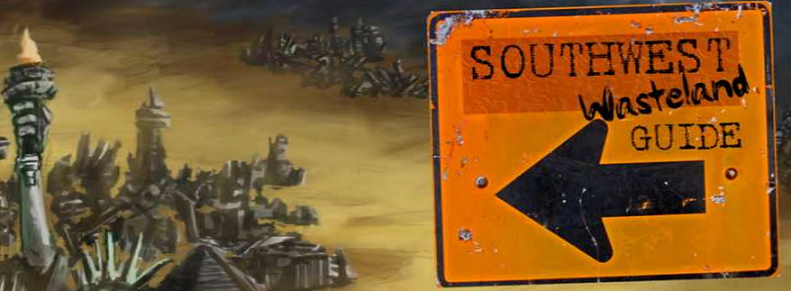
Fair warning, this is going to be a short one: we're in the sagging mid-section between the first and fifth chapters.
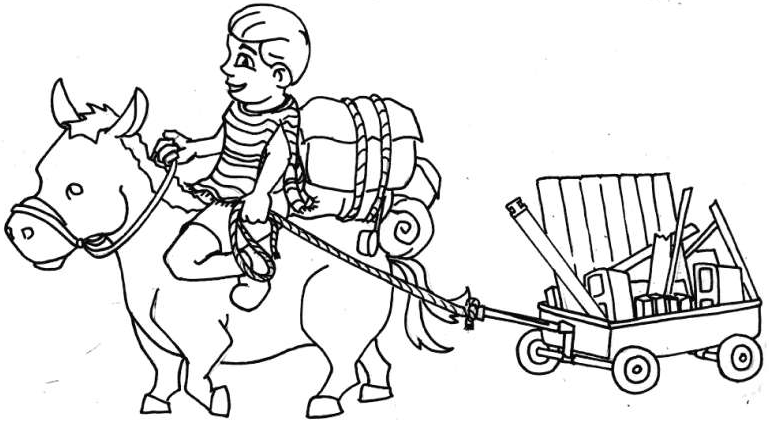
Chapter 2: Skills
Or, more accurately, "three skill uses". Yes, just three. You can now use Computer Use to reprogram computers or robots, Craft to fabricate raw materials for further Craft skills, and Handle Animal to train an animal to salvage garbage for you. And this was its own chapter in the Southwest Wasteland Guide rather than something in the player's manual why, exactly?
Chapter 3: Feats
Nineteen feats, which is certainly more than the new skill uses but probably well within the range of "probably should have been in the player's manual". They're also mostly in the category of things that might potentially be useful but aren't interesting to talk about. Gaze in wonder at feats such as:
-
Fast Shot
, which lets you get one extra attack when using guns during a full attack action.
-
Literary
, which makes all Knowledge skills class skills.
- Tag! , which lets you have four Tag skills instead of three.

Chapter 4: Equipment
Welcome to probably the most interesting part of chapters 2 through 4. That's not any manner of sarcasm, either, this is unironically the most interesting thing in between chapter 1 and chapter 5.
Weapons: Since all the reprints of d20 Modern Core Rulebook weapons were taken care of in the player's handbook for Exodus, we're down to the good shit: militarization of recreational tools! A lacrosse stick acts as a 1d6 damage archaic weapon that can be used as either a club or to catch a small enough projectile, while a hockey stick is a 1d8 damage slammer that doubles as a quick bonus to trip attempts.
Oh, and there's smoke bombs, flashbang grenades, and tear gas, too, I guess. Eh.
Armor: Continuing the theme of “weird things post-apocalyptic people do with recreational materials”, all of the new pieces of armor presented in the Southwest Wasteland Guide are repurposed sports gear. Athletic sports pads (hockey or football) provide 1 PDR and a +2 to Defense, while the rest are all helmets that provide PDR (3 for a bicycle helmet, 5 for a motorcycle helmet or hockey mask) solely against targeted attacks to the head or eyes.
Field Gear: For your communication and power needs, stats are provided for fusion batteries, fusion generators, ham radios, and portable radios. The only thing really interesting to note here is that fusion generators have a failsafe if their mini-reactor is breached or damaged. While certainly reasonable from a logical standpoint, it's a shame that you can't take pot shots at one and bathe your enemies in nuclear fire, a la the cars in Fallout 3.
Clothes: Want to wear a sports uniform, professional motorcyclist's jumpsuit, or janitor outfit? Well, here they are. They don't really provide any mechanical effects and are pretty much entirely for show.
Chemicals: While the player's handbook covered drugs such as not-RadX and not-Slasher, it's all real world stimulants and addictive substances here in the Southwest Wasteland Guide. It's also got a lot more smartass comments. The following vices are provided an outlet.
-
Cocaine:
For an hour, you get a +4 to Constitution and the benefits of both the Remain Conscious talent and the Alertness feat. The after-effects are a -2 to Constitution and the Exhausted status condition.
-
Humpback Cigarettes:
Cigarettes have no benefit from their use, and their drawback is that you have to read the players the following Surgeon General's Warning provided by the book: "
The Surgeon General warns that smoking Humpack Cigarettes may be hazardous to your health and may cause black lung, cancers, delay pregnancy, respiratory disease, and
a strong attraction to the same sex
.
" Emphasis mine.

-
Liquid Energy:
Or, in more typical terms, an energy drink. You lose the Fatigued and Exhausted status conditions for an hour, after which they return on top of a -2 Dexterity penalty.
-
Marijuana:
While the benefits are clearly listed as a +2 bonus to Wisdom and saves against fear, the drawbacks are a bit more confusing. The text itself states that after the drug wears off you suffer the Fatigued status condition, while the quick-look table of information says that you suffer from...“the munchies”. Of course.
-
Meth Cubes:
+2 to Wisdom, +5 to bonus speed, and +2 to Reflex saves for two hours. Of course, once it wears off, you have two hours of hallucinations. +2 to Wisdom, +5 to bonus speed, and +2 to Reflex saves for two hours. Of course, once it wears off, you have two hours of the Hallucinations status effect.
- Morphine: Morphine is unique in that its benefits and drawbacks happen at the same time, rather than only being produced as an effect of the drug wearing off. Your Massive Damage Threshold is doubled and any doctor performing surgery on you gets a +4 circumstance bonus to their Treat Injury check, but you have a -2 to Dexterity, Intelligence, and Wisdom. If you are familiar with d20 Modern, you'll know that unlike some systems such as Cortex or GURPS, there is no system for pain endurance in d20 Modern. Or any other d20 derivative that I know of, for that matter, but that's not the point here. The point is that what they've done is try to attach pain threshold to Massive Damage Threshold, which isn't about pain: it's about avoid being knocked out by massive damage , hence the name. So, for instance, Grognard the Barbarian with his 18 Constitution plus High Damage Threshold feat for a further +3 makes his MDT soar to 42 by stabbing himself with a morphine syringe. This means that as long as he has enough HP to endure it, he can take maximum damage from a Vulcan minigun without even flinching.
Manuals of the Wastelands: There are two new wasteland manuals to provide skill check bonuses for your enterprising survivor, and as with the player's handbook, the ones here are pop culture references. Emerald's Book of Survival Recipes (presumably a reference to Emeril Lagasse) gives a +4 bonus to Survival checks to find food and water and to Profession (Cook) checks, while Lesman Stroud's Guide to Dumpster Diving grants a +4 to Search checks made to scavenge materials. Points for the blatancy level of that second one.
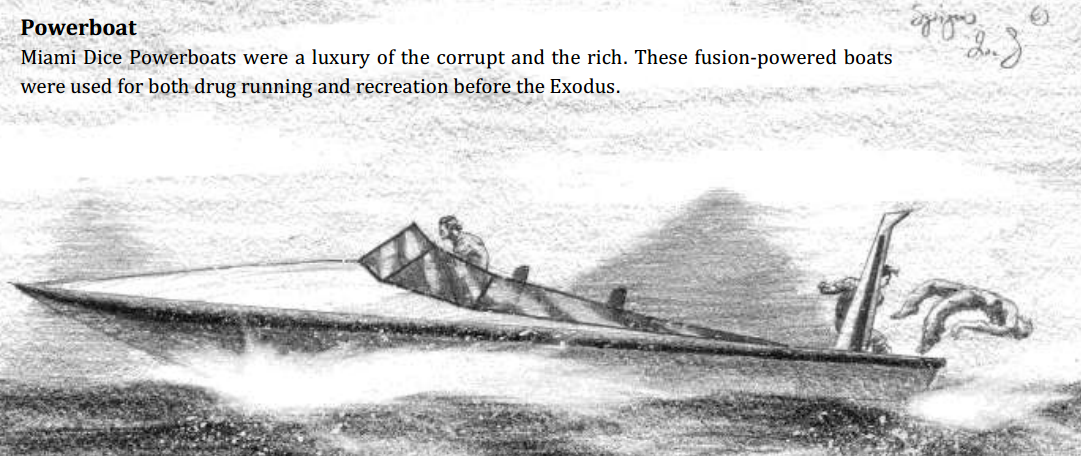
Vehicles: Last, but not least, is a collection of further vehicles for those who like their Fallout to have a dash of Mad Max. There are fourteen in total, some more interesting than others, but we'll go over all of them at least briefly.
-
Army Transport:
If you've seen a World War II documentary or episode of M.A.S.H., you've probably seen one of these canvas-backed cargo vehicles. Wastelanders use them to move people or goods, same as they've always been used.
-
Bicycle:
Bicycling was considered the thing of children, until one man named Lance Armstrom (
 ) managed to almost single-handedly make the sport respectable. Of course, this respectability factor doesn't really matter after the apocalypse has happened, but it's noted as part of the lore nonetheless.
) managed to almost single-handedly make the sport respectable. Of course, this respectability factor doesn't really matter after the apocalypse has happened, but it's noted as part of the lore nonetheless.
-
Dirt Bike and Ninja Catapult:
Two types of motorcycle. While the dirt bike is somewhat weaker, half as fast (220 feet per round to 400 FPR) and generally not as good as the other motorcycle present, it does have two things going for it. One, it is 17,500 caps coins compared to 90,000. Two, the second motorcycle's full name is "the Yamahonda Ninja Catapult", which is the dumbest name I can think of for a stylish racing motorcycle.
-
Haul Cart and Hauler:
Another pair that might as well be noted together due to their similarities. Both are animal-driven carts, just with different designs and thus different loads. The haul cart is a classic wood rickshaw, while the hauler is literally the bed and back wheels of a truck with the cab and front wheels sawed off and replaced with reins for two large beasts of burden such as cattle.
-
Jet Ski:
Another creation of Yamahonda, jet skis are one man watercraft known for their high speed.
-
Jeep:
I'm actually kind of surprised that this one is here and not in the player's manual. I mean, really, a Jeep is like the quintessential off-road vehicle for most people.
-
Powerboat:
See the above image. Yeah, the information sections on these vehicles aren't very long.
-
Rowboat:
This would be a rather uneventful entry if it weren't for yet another ridiculous company name, this time being the Catch and Release Redneck Company.
-
Semi Truck:
The front of an 18 wheeler, with the back stated to be almost impossible to find thanks to how enticing a target they are for scavengers. The larger manufacturer of semi trucks before the apocalypse was the Big Friggin' Rig Company, who would win dumbest corporate name if it wasn't for the blatant real world company mashup of
Yamahonda
.
-
Wasteland Wagon:
Literally a Wild West-style covered wagon.
- Sailing Yacht and Power Yacht: Fancy pants water transport, both in motored and sailboat form.
Overall, the largest problem with these entries are that they are almost all two or three sentences long, and all but the semi truck only discuss the pre-apocalyptic applications of the vehicles in question. What does a raider do with a jet ski? Do traders use army transports, or are they forced to cobble together covered wagons? Who pedal bikes in the wasteland? I don't know, and apparently neither did the writers.
Next Time
We're finally there, the factions section. Prepare to behold the wondrous Mongochipanese culture of the Chi dynasty, the savage ethnically homogenous raider armies of The New Era of Mexican Order, and the Original Character Do Not Steals of the Steel Disciples.
Southwest Wasteland Guide: Factions
Original SA post
Welcome back to Exodus,
Chapter 5: Factions

The Chi Dynasty
The sovereign rulers of San Francisco are the Chi Dynasty, an orderly but iron-fisted empire whose origins stretch back to before the apocalypse. A Chinese-American businessman by the name of Wu Lung saw that the Great War wasn't going to end in any way that could be considered good, and decided that the future could best be secured by financing his own personal vault beneath Chinatown. Wu Lung was also a huge xenophobe who ordered his sons to have all people who weren't Chinese exiled from San Francisco after his Asian army came out of said vault, presumably causing some Yellow Peril believers to wet themselves in joy at their craziness being found true. Wu Lung is referred to as Great Forefather, which is a rather impressive title given that he was still alive at some point during the two decades between the Great War and the vaults opening and there was probably only one or two generations born in the mean time, and his descendants are pampered aristocrats believed to have prophetic abilities due to their bloodline.
The current ruler of the Chi is Emperor Wang Shu. Most of his ruling tips were given to him by Wu Lang before he died, and are based on the good old feudalist system. You've got the emperor, the greater and lesser nobles (known as Shi) with their landships, the military from the lesser noble families, and then there's the peasants down at the bottom. Slavery is considered intolerable, but keeping non-Chinese people out of Chi lands is commended. In fact, there is an entire town set up specifically for dealing with "foreigners": Barter Town. Yes, it actually is called Barter Town, that's not me trying to make a Beyond Thunderdome joke or anything. Barter Town is technically run by some local Shi, with the merchant foreigners being legally designated as peasants, but it's sort of an open secret that there are tons of backdoor deals, extortion plots, and other various manipulations happening behind the scenes that keep the merchants with far better influence and luxury than actual Chi Dynasty peasants. Those folks, in spite of being native Chi, tirelessly work the shit farms to the south of San Fransciso and the large fishing village of Alcatraz Island, and have no say in the feudal government. They can also be conscripted in times of war when the Barter Towners can't.
Of course, even discounting the treatment of the peasant class, not everything is sunshine and roses within the Chi Dynasty. While fending off invaders and killing slavers (as chattel slavery is seen as dishonorable and savage by the Chi) is a fine thing, Wang Shu has begun to have actual military aspirations, which makes a lot of the more isolationist Shi nervous. Raids on the heap of slag that was once Los Angeles has angered the already volatile Children of the Apocalypse, and skirmishes have broken out several times with a clan of ghuls in nearby Berkeley. The ghuls, referred to by the Chi as jiang-shi, are constantly spied on by the paranoid Chi border guard, and each case of small scale violence so far has been due to said spies being caught in Berkeley before they can sneak out.
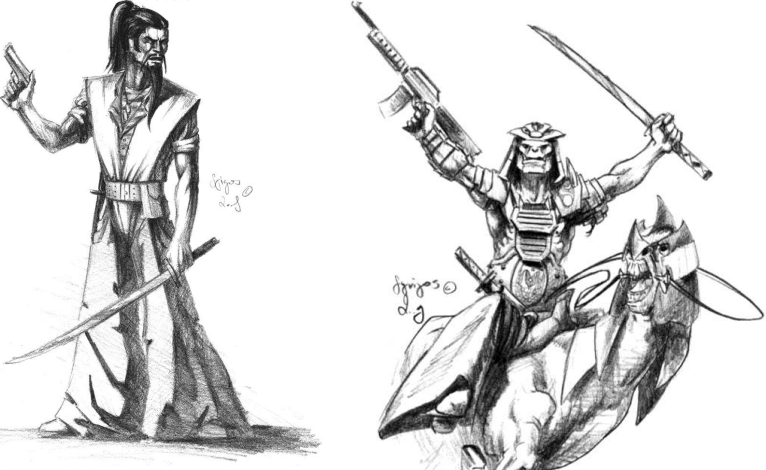
Chi Dynasty Advanced Classes
On top of the advanced classes from earlier in the book, each faction gets their own special advanced classes as well. The Chi Dynasty gets the biggest brunt with a total of four new advanced classes.
Chi Horse Lord: While horses are extinct in the Fallout universe, Exodus has decided that this is a point where it should diverge from its source material, and as a result we have the Horse Lord. Horse lords are the mounted warriors of the Chi Dynasty, entrusted with some of the few horses remaining in the Wasteland. Horses are seen as a sacred gift and it is a great dishonor for one to fall in battle while its rider survives. Outside of flavor text, though, there's not much to write home about concerning this five level advanced class. It has average progression of everything except Will (which is below average), and all of its class features are literally just the various mounted combat feats from Dungeons and Dragons.
Dynasty Bowman: The elite stealth warriors of the Chi are noble soldiers trained in the way of the bow and arrow. It's another five level prestige class, this one with Fortitude as its poor progression. Its special qualities are Archery Master (add your levels of Dynasty Bowman to your attack rolls when using a bow) and Rapid Archery (get an extra attack per round with a bow) at level 1, Close Combat (you can use a bow as a 1d4 bludgeoning damage weapon in melee) at level 2, Weapon Specialization (Bow) and Far Shot bonus feats at level 3, Deadly Accuracy (+4 to called shots with a bow) at level 4, and finally Master Bowman (you can release five arrows in a full attack, but at a whopping -10 penalty to the attack roll) and Weapon Mastery (Bow) as a bonus feat for level 5.
Dynasty Warrior: Ah, yes, the famed samurai of China. Or not, since in spite of the art of a ponytailed man with his hanzo steel at the ready, the class can focus on any one archaic melee weapon or your bare fists. It's yet another five level advanced class, with Will as its poor save progression. On top of getting a bonus feat at levels 2 through 4, the Dynasty Warrior has a small collection of offensive and defensive class features. Level 1 provides Signature Weapon as a bonus talent and Superior Defense (you get a morale bonus to Defense equal to your Dynasty Warrior level when you are wielding a melee weapon or are unarmed), level 2 provides Deflect Projectile (you can spend a karma point to reflect a ranged or thrown projectile as long as you have either a melee weapon or some manner of hand covering), level 3 grants Weapon Specialization with one archaic weapon or your unarmed strikes, level 4 gives you Melee Deflection (like Deflect Projectile, but against a melee attack), and level 5 caps off with Skirmisher (you gain a straight up +1d6 to melee damage, which increases to +2d6 if you are wielding your signature weapon).
Kung Fu Master: The only ten level advanced class for the Chi, which also happens to be unambiguously superior to the Martial Artist advanced class from the Exodus Survivor's Guide. The reason for this? Well, it's definitely not the progressions, which are poor for Fortitude and Will, good for Reflex and Defense, and good but not full for Base Attack Bonus. What it is is the fact that the class features here are "Disciple Powers", which you gain based on a specific martial arts style you choose. Since there is a full class's worth of powers for each style, I'll just give the basics and the most noteworthy parts of each:
-
Brass Monkey Style:
A style based around both avoiding damage and beating the shit out of your opponents with abilities that let you do things like deal 1d12 damage with dropkicks or (rather confusingly) channel your inner static energy into a bonus 1d8 electricity damage with your unarmed strikes. A noteworthy ability would be
Brass Monkey Funky Junky
, which allows you to use "the ancient technique of mad rhyming skill" to gain your Charisma modifier as a bonus to Defense if you can successfully confuse a foe.
-
Chicken Style:
Stated to be specifically based around cockfighting and its popularity with the Chi people, Chicken Style is almost entirely based around doing more damage with kicks. Of course, since this is Exodus, the final class feature for the style is called
The Colonel's Secret Recipe
, which grants a +3 to Balance, Bluff, Hide, Move Silently, and Tumble checks.
- Iron Butterfly Style: Based around Dexterity and even more pop culture references than the other styles. Just some of the talents you can manifest include Sting Like a Bee (stun a foe for one round with your unarmed attack), The Graceful Art of Stomping Someone's Guts Out (you get a +8 rather than +4 on attack rolls when making an attack of opportunity against a prone foe), and Inagodadavida Baby (chanting and meditating on "That Which Cannot be Said" causes your mind to become focused, granting a +4 insight bonus to attack and defense rolls for 5 rounds).
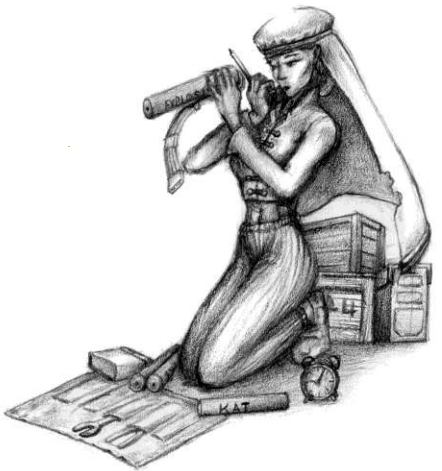
Children of the Apocalypse
Exodus seems to be trying to say something to someone with this organization, though I'm genuinely not sure what to who. They treat the shelled ruins of Los Angeles (known as the Junkyard) as "their Mecca", they have a rather notable custom class feature you can read about in a minute, and the clothing in the example image above seems more than a little Arabian Nights dressup, but at the same time their leaders are referred to from the highest to the lowest as His Holiness, Archbishops, and High Priests, and members pay tithes. Indeed, their origin is merely stated to be followers of religions that were based around some manner of final judgment, and no names are given beyond that at least some of them were obscure doomsday cults and followers of "mad prophets", while others were adherents of "great prophets". The organization in and of itself isn't much more coherent either. The organization's goal is to induce a second Great War to clean the planet of all who don't follow "the Holy Flame", thus ensuring peace and sinless living. What exactly qualifies as a sin for the Children isn't actually explained. It's definitely not anything traditionally seen as sinful, since His Holiness is stated to be a drug-addled and uneducated tyrant who will torture or kill people for no real reason other than he feels like it at the time, while other members engage in various forms of debauchery and vice. While waiting for the day when they can actually engage in widespread destruction, the Children trade the voluminous amounts of scrap materials in the Junkyard with NEMO and the Vegas Mafia, two other explicitly villainous organizations, in exchange for the things they need to actually survive such as food and water.
Children of the Apocalypse Advanced Classes
Two five level advanced classes are provided for the Children. The first, the Seeker of the Holy Fire , is a stealth-oriented class with poor Fortitude and Will save progression and class features that mostly focus on Demolitions, Reflex saves, and deception-based Charisma skills. The big exception is the capstone feature, Atom Akbar , which I still can't believe is an actual class feature name. This class feature grants the Seeker a 30d10 damage mini-nuke, which they use in a crowded area to kill themselves and others. Classy.
The other Children of the Apocalypse-specific class is the Warrior Saint , the soldiers of the Children. Full Base Attack Bonus progression contrasted with Reflex saves being their poor progression is combined with a set of skills unsurprisingly geared toward combat. Fanatic's Zeal at level 1 provides immunity to Intimidation and fear effects, Rally the Faithful at level 2 provides a +1 morale bonus to attack and damage rolls to all other cultists within a 120 foot radius, Death to the Unbeliever at level 3 is just Sneak Attack with a far dumber name, Improved Reaction at level 3 is just a +2 to Initiative checks, and Religious Fever (did they mean Fervor?) at level 5 is Dungeons and Dragons-style Barbarian rage by another name.
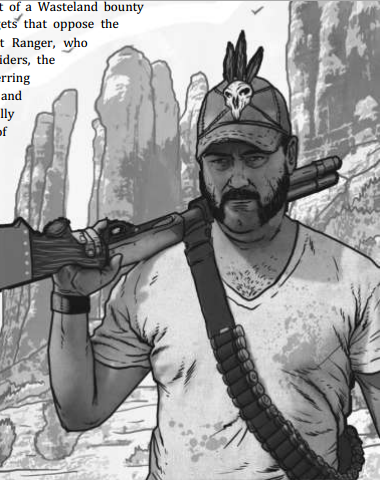
The Desert Rangers
The Desert Rangers are explicitly stated to be pretty much the only justice in the Wasteland that isn't crooked or outright evil. This is rather impressive, as the Rangers have no actual leadership or regimented structure, and no actual requirements to join beyond a set of tests of strength and determination that are administered individually by each Ranger to whoever they feel deserves to be a Ranger as well. Rangers tend to work individually, either openly in lawless lands or in secret where corrupt leadership holds sway. Their main targets are typically slavers, though thieves, murderers, gangsters, and other criminal enterprises also get the brunt of at least some of the members of the loose organization. A charismatic and upstanding Ranger (read: players with enough levels the Desert Ranger advanced class) can expect other Rangers to come running to their aid in times when one lawman just isn't enough. Two named rangers are briefly described here as well. Ranger Smith is a legendary Ranger whose true name is lost to history, known for being the sovereign protector of the strangely untouched Yellowstone National Park and the tribals that make the region home. Ranger Justice, by contrast, is a Texas Ranger who has killed so many slavers, raiders, and other various ne'er-do-wells that he has taken on a Pecos Bill-like status as a larger than life folk hero amongst Rangers in the deserts of the Southwest.
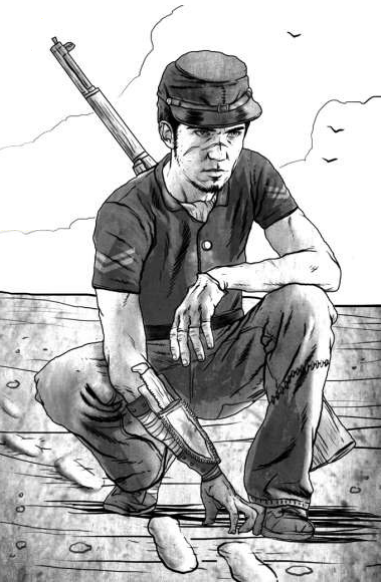
Desert Ranger Advanced Classes
If you recall, back in the Exodus Survivor's Guide there was already an advanced class called the Desert Ranger, specifically designed for people who were part of the Desert Rangers. Logically, you'd assume the two new advanced classes presented here would be five levels long and prestige off of someone who had ten levels of Desert Ranger, right? Well, no, actually, that's wrong. These are seven level advanced classes that require you to be Desert Ranger 3 before taking them. Both have the same save, BAB, and Defense progression as the Desert Ranger, but with the big catch of it being the same progression as the Desert Ranger from level 1 rather than level 3. They also have the same d8 hit die. Where they differ, of course, is in their class features and what those focus on.
The first of the pair, the Desert Ranger Manhunter , is the guy who goes all in on murdering one tough named NPC each quest. The class's very first feature is Acquire Target , which grants a bonus equal to your Manhunter level to all Bluff, Computer Use, Gather Information, Investigate, Listen, Research, Search, Sense Motive Spot, and Survival checks against a single individual for 24 hours. This is augmented with good old D&D-style Sneak Attack for a +1d6 added on at levels 2, 4, and 6, Swift Execution (coup de grace as a free action if you are in an adjacent square) at level 3, Death Strike (just Improved Critical, in spite of the name) at level 5, and Assassinate (Sneak Attack forces a save-or-die equal to DC 10 + the Manhunter's class level and Intelligence modifier) at level 7. There's also a couple of utility features, with Camouflage at level 1 doing the same thing that it does for the Desert Ranger proper, Sweep at level 2 giving a +4 to Spot checks in a 30 foot radius at the start of each encounter, and Improved Sweep at level 6 boosting this to also determine whether enemies in an encounter have more, equal, or less HD or class level than you do.
The Desert Ranger Tracker hems somewhat closer to the standard Desert Ranger, as they get the Desert Ranger's Favored Enemy against an organization or creature type at levels 2 and 6 and Camouflage at level 2. What it doesn't get is any of the teamwork. Instead, if you're a Tracker you're getting some added combat abilities as well as some stealth-oriented ones. Tracker at level 1 grants a +4 to Survival checks to track prey and a +2 to Gather Information, Investigate, and Research checks at any time, Wasteland Adaptation at level 3 lets you take 20 on Hide and Move Silently checks even during stress or distraction, No Trace at level 4 is a forced penalty against others using Track against the Tracker, Wasteland Survivalist allows taking 10 on any Fortitude save against environmental hazards such as dehydration and extreme temperatures, and Vanish at level 7 lets you force a Will save against foes and instantly make a Hide check against those who fail the check as if they had never seen you.
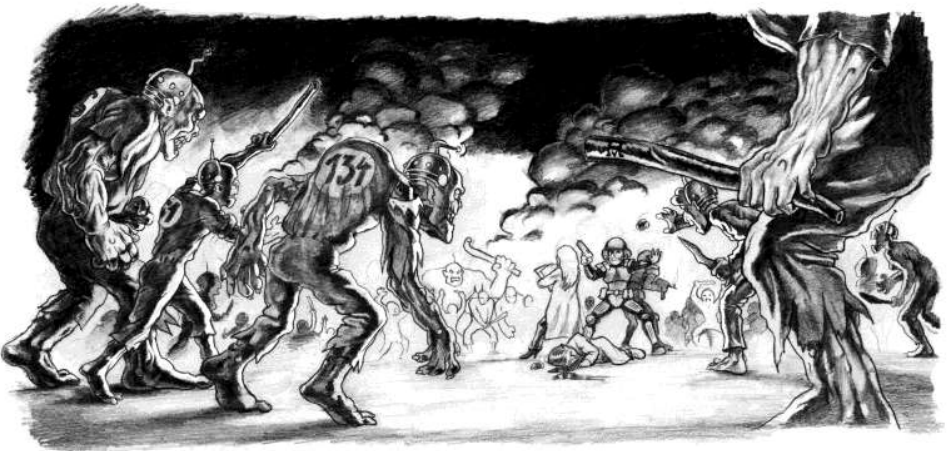
Project Trinity and the Ghul Collective
The Exodus Survivor's Handbook already noted that, being often shot on sight by people who think they are literally zombies rather than horrific rotting mutants and distrusting “the smoothskins”, ghuls have tended to gather in relative safety around the cities of Berkeley and Oakland. Here, we learn the reason why that area is so safe for them: it's run by dregs, the soldier ghuls introduced as a new player race in the Southwest Wasteland Guide even though they are just ghuls with military training, and their fortifications are bristling with fancy toys gathered from Oakland Army Base. Even the warriors of the Chi Dynasty, called on to wage war against what Wang Shu Di saw as a place of filth and abomination, failed to break the ghul stronghold, and has instead turned to attacking small bands of traveling ghuls who have yet to complete their pilgrimage to Berkeley/Oakland.
The dregs run the show through a council of members who hand off position of chairperson to each other every three years. They keep the peace and make sure supplies are evenly handled, but otherwise don't really do much active governing and let the majority of dregs and ghuls do what they feel like doing. For a lot of the dregs who were part of the military group Project Trinity, that involves defending the home front. Ray gun turrets, Gatling lasers, heavy artillery, and other big time gear is augmented by fusion-powered military vehicles that are meticulously maintained, and plans have been made to try to salvage warships and aircrafts from other military bases that are too radioactive for humans.
One particular subfaction inside the greater Berkeley faction is the Ghul Collective. These guys are a spy ring with members across the entirety of the American Southwest. The goal of the Collective is to connect ghuls far and wide into a greater networked society while also collecting any pieces of recorded information left from the pre-apocalyptic world. They are also the reason for the sole new advanced class for ghuls, the Historic. It's a five level class that has meh progression across the board, d8 hit die, and a collection of class features based around (unsurprisingly) history. Historic Lore is more or less Bardic Lore from D&D, and shares the level 1 ability slot with Historic Tactics . Historic Tactics allows you to make a full round action to grant all allies within 30 feet a +1 bonus to something for a number of rounds equal to double your Historic level. What that something is is accidentally omitted, but presumably it would be attack or Defense rolls. This bonus increases to +2 and +3 at levels 3 and 5, respectively. Brains Over Brawn at level 2 lets you use Intelligence instead of Strength or Dexterity for attack rolls and ability checks related to those two ability scores, while Historical Navigation is also at level 2 and grants your level of Historic to Navigate and Knowledge (Geography) checks. There's also some free talents if you didn't pick them up at your base class: Skill Emphasis at levels 2 and 4, and Savant at level 4. Finally, as its capstone ability, Total Recall provides a +2 to Intelligence and Knowledge checks, as well as allow you to permanently retain any skill bonuses from reading a skill book.
Next Exodus Southwest Wasteland Guide Post: More factions! The Khans of Vegas and their drug running operations, the power armored Steel Disciples, and other things that totally aren't familiar at all.
Southwest Wasteland Guide: More Factions
Original SA post
It's been a long, lonesome road, but it's finally time to have the last roundup of the second book of Exodus: Post-Apocalyptic Roleplaying.
Chapter 5 Continued
Trans-Genetic Mutants and the Mutant Army
In case you've forgotten in the surprisingly long time since I started reviewing the original player's guide for Exodus, Trans-Genetic Mutants are Fallout's Super Mutants with the added bonus of being "those savage thugs who are taking our women!", since unlike Super Mutants the Trans-Genetic Mutants are only half sterile rather than entirely sterile (and it's of course the males who are the fertile ones, so they steal and rape human women). About 99% of the Trans-Genetic Mutant population is in the Mutant Army, which is made up of the original TGMs from US super soldier projects, their rape babies, and child slaves that are mutated into TGMs using the still working mutagenic vats at Los Alamos. Said child slaves are why the Slaver's Union is the only human organization the Mutant Army doesn't immediately consider yet another part of an inferior species that needs to be exterminated. The rest? All on the extinction list. And since they don't have any special classes, that's about it for anything discussion-worthy.
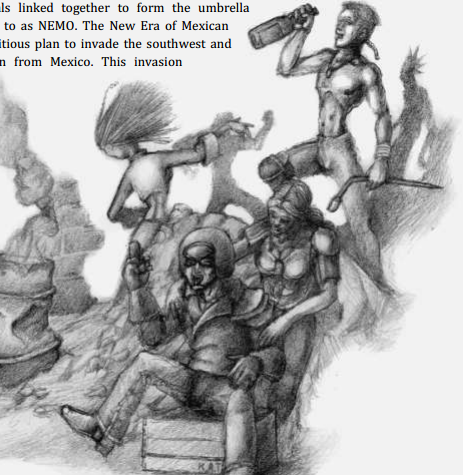
New Era of Mexican Order (NEMO)
The remnants of Mexico have turned into a marauding conglomerate of clans made up of former corrupt soldiers, cartel members, and bandits that call themselves NEMO and claim that they will be reconquering the lands the USA took from Mexico. They're secretly actually just using this claim as a justification to be horrible people, though, and engage in torture, rape, slavery, and murder. What fun! Like the Chi Dynasty, NEMO is a xenophobic organization, only accepting members of "La Raza" (the book's use of terminology, not mine; I feel like I need to reassure that I'm not making shit up from time to time).
The organization is made up of tenuously connected clans that are lead by a military-style commander, or "Capitan", and his group of advisors referred to as "hombres", with a group of various rabblerousers making up the much larger bottom ranks. Attempts to create a unified NEMO through a king/emperor/what have you have always failed due to said overlord inevitably being assassinated by one Capitan or another. The only reason other Wasteland organizations fear NEMO at all is because of their sheer numbers, rather than any actual military skill or technological prowess. The only major city has taken is Phoenix, Arizona, but they have effectively cowed the rest of Arizona into such a fearful state that they can roam across it fairly freely.
Slaver's Union
Exactly what it implies. The Slaver's Union was born when multiple gangs of slavers across the Southwest realized that it would be more profitable to work together than to keep killing each other over who enslaved who. The original gangs created a continuously updating union code that decides what gangs can take which type of slave, standardize slave prices, and practices for adding new gangs to the Union. New gangs have to pay a fee and follow the direct orders of a member gang for a period of time being fully inducted into the Union, taking on the symbol that marks all of its members: the tattoo of an inverted dagger with the phrase "Only God can judge me" around it, inked right into the face with different colors and sizes depending on the specific gang the individual is a part of. Gangs that refuse to join the Slaver's Union or buy slaves from non-union gangs are mercilessly slaughtered to serve an example to others. The only exception to this rule is NEMO, who got unofficial Union membership as a loophole in order to avoid sparking a war between the two organizations. NEMO is the only organization that could truly be said to have friendly relations with the Slaver's Union, as others that buy from them such as the Mutant Army and Vegas Mafia don't trust the Union more than they do any random slave gang.
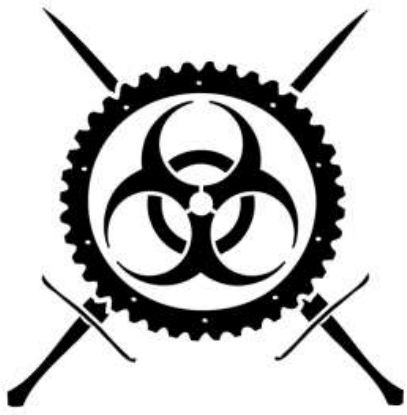
Steel Disciples
The Steel Disciples are a fraternal, closely knit group of United States Army soldiers and scientists from a Nevada fallout shelter and their children. They are a brotherhood, one might say. And a brotherhood that plans on becoming much larger, in fact. Their main goal in the Wasteland is threefold: acquire as much technology as possible, annex new territories into the safety of the Steel Disciples, and finally engage in all-out war on threats to peace such as the Mutant Army and NEMO. Their desire to be greeted as liberators rather than oppressors means that they engage in a lot of subterfuge and agitprop rather than the active conquest of their Great War predecessors. While it has worked so far, it also means that their annexation plans go slowly, which isn't helped by how slow the organization itself grows. Steel Disciples almost never expand their central command structure, and even the growth of their lower ranks is slow due to their overly strict and rigid induction policies. This means that most actual civil defense outside of the Disciples' home base of Wendover, Utah, gets handed off to local militias while the Steel Disciples themselves go off to war with enemies foreign rather than domestic.
Most Steel Disciples combat engagements usually go in their favor despite disparity in numbers, simply because they have the best toys: most of the vehicles, power armor, and energy weapons in the Wasteland are directly in the hands of the Steel Disciples cells. Of course, their technological superiority is just as in jeopardy as the rest of their operation. Knights and Paladins burn through more energy cells than they recover, and the largest nearby sources of military hardware are under control of either the Chi Dynasty, the dregs, the Mutant Army, or in a state of war between two or even all three of the aforementioned factions. The only exception is the enigmatic Groom Lake facility near Roswell, and no Steel Disciples that have gone out that way have ever returned (spoilers: we never actually learn what's up with Roswell).
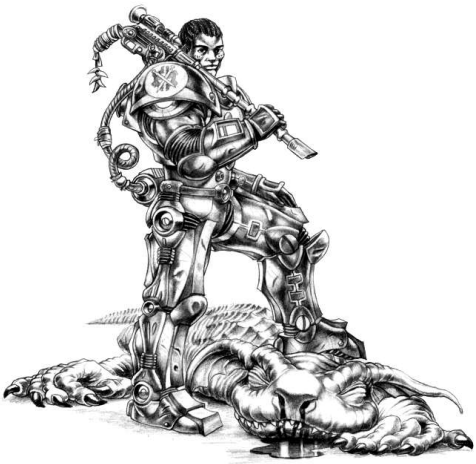
The Steel Disciples also happen to mark the return of organization-based advanced classes after their absence during the three villain groups. Both of them are five level classes that bounce off of Steel Disciple classes from the player's guide, and are effectively present t obe an alternative to all high level Disciples characters heading toward Steel Disciple Paladin. The Steel Disciple Cavalier requires five levels of Steel Disciple Knight to enter, and is meant to be both a monster in combat and an expert at subterfuge. A Cavalier has full Base Attack Bonus progression, d10 hit die, and decent Reflex and Fortitude saves, but poor Will saves, and gets various bonuses to deception-related skills and combat in urban areas. They also get Tactical Strike at level 5, which is one free 30d10 attack on everything in a 1,000 foot radius courtesy of a Steel Disciples VTOL that has to be replenished by going back to Wendover after it is used. By contrast, the Steel Disciple Scholar jumps off of five levels of Steel Disciple Scribe rather than Knight, and is focused on just what its name would imply. Poor BAB and Fortitude save progression but good Reflex and Will save progression, d6 hit die, Knowledge bonuses of various stripes, blah blah blah.
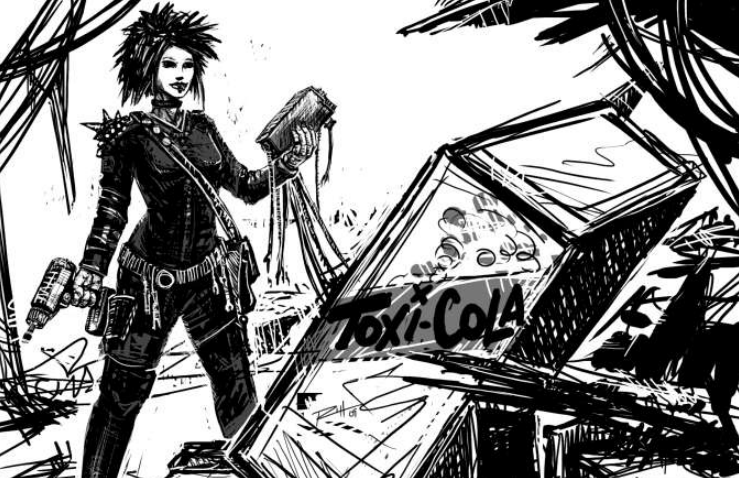
The Techno-Reapers
A cult of technology-obsessed individuals that hang out at the Alamogordo air base. Their entire philosophy is based around learning and mastering as much pre-War technology as possible, thus ensuring that knowledge of its creation and utilization is regained and hopefully used to kickstart further rejuvenation of humanity. This may not sound very cult-like so far. Honestly, it probably sounds quite reasonable. Well, you'd be right, because what makes the Techno-Reapers so crazy are their edicts rather than their main life goal. Most Techno-Reapers care far more about their technology than governing, so their method of rule is to have a dictatorship where the dictator rotates out every 6 months to be evaluated and rewarded/punished by their peers for how benevolent or malevolent a dictator they were. There's also the two Three Laws documents: the Three Laws for civilians and Three Laws for Techno-Reapers. The former dictates that any citizen or visitor who comes to Alamogordo must respect all technological devices and suffer one year of hard labor if any technological device is destroyed, refrain from all violence and theft or suffer the First Law of Gulag (more on that in a moment), and if they are a mutant they cannot be in the town at all during the night and must buy a daily license to be in the town from sunup to sundown. Mutants without a license or caught at night suffer the death penalty.
The Three Laws for actual members of the Techno-Reapers are that they must find at least one piece of advanced technology in the Wasteland and learn all of its workings, must protect and preserve all technology, and must leave the order and be subject to the First Law of Gulag if they fail either of the other two laws. What is the First Law of Gulag, though? Well, it's not actually anything to do with gulags, in spite of the name. Someone who breaks a law that invokes the First Law of Gulag has all of their possessions stripped from them, are taken on a three day trek, and then are left in the Wasteland to either survive or die. Given all of these factors, it's a wonder someone hasn't stomped these nerds into the dirt. And yet they still stand, and are even good friends with the Steel Disciples and Desert Rangers, who they trade technology with in exchange for new toys that haven't seen before. The Techno-Reapers get one five level advanced class, the Technician , which has d8 hit die, average progressions in everything except for their poor Fortitude saves, and class features that buff Computer Use, Craft, and Repair skills.
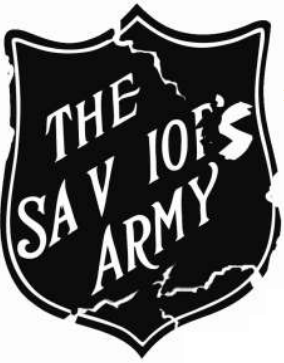
The Savior's Army
Take the Followers of the Apocalypse from Fallout, add a garnish of religiousness, and you have the Savior's Army. This organization is literally the Salvation Army, or more specifically its remnants. Members of the group that survived the apocalypse felt that it was a message from God that they lived when others had died, and that they were a needed force in the new world. Savior's Army camps can be found all across the Southwest Wasteland and welcome all comers with medicine in one hand and a Bible in the other. And I do mean all comers: slavers and mafiosos are treated with the same attentive healing care as members of the Steel Disciples or Desert Rangers. The only groups that don't get along with the Savior's Army are those that are religiously opposed to them, such as the Children of the Apocalypse and Unity, who typically murder or enslave their doctors. The Savior's Army also has some internal strife between those who feel that only Christian medical personnel should be allowed membership and those who argue that the Army needs all the help they can get regardless of faith.
The Savior's Army has two advanced classes, both ten levels long and obviously not combat-focused. The Missionary has d8 hit die, good Defense Will save progression and average Will and Reflex save progression contrasted by poor BAB progression, and various class features (one of which is named Missionary Position
 ) that provide a bonus to social skills and survival, while the
Surgeon
is basically the Field Medic from the d20 Modern Core Rulebook.
) that provide a bonus to social skills and survival, while the
Surgeon
is basically the Field Medic from the d20 Modern Core Rulebook.
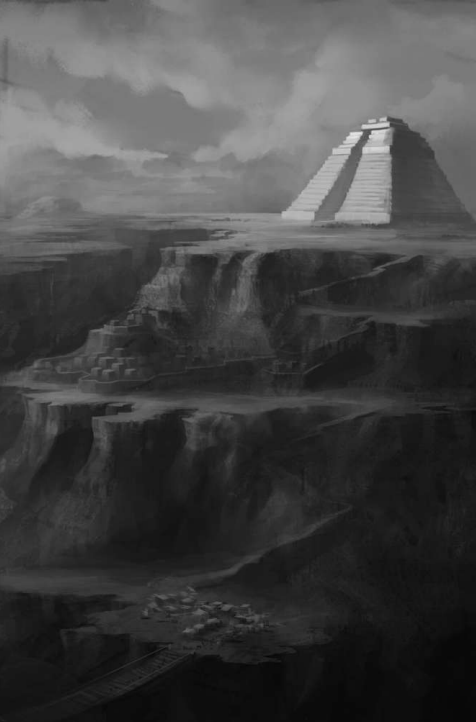
The Tribal Nation
While they were never invited into any of the fallout shelters, the members various Native American reservations in the Southwest survived by gathering together in various caverns in the walls of the Grand Canyon. There, they learned how to harmonize with nature, tame wild beasts of the Wasteland, and create one of the largest functional nations in the region. The nation is centered around Bullhead City, Arizona, where they have converted three Aztec temple-shaped casinos (which don't exist in the real world if Google isn't lying to me) into actual temples where religious ceremonies are lead by four great shamans known as the Ghost Dancers. Over the Ghost Dancers and other tribal leaders is Great Chief Walking Frog, a stoic elderly man who often leaves the safety of the tribal lands around the Grand Canyon to commune with the beasts of the Wasteland. While they are a peaceful people, the Tribal Nation is more than well-equipped to deal with foreign enemies, and is often forced to do so due to slavers and NEMO.
On top of the two tribal advanced classes from the player's guide, the Southwest Wasteland Guide provides the Beastmaster advanced class for Tribal Nation members. Beastmasters have d8 hit die and good progressions for BAB and all saves contrasted with poor Defense bonus progression. If you couldn't guess, this class's class features focus on animal companions and avoiding altercations with wild animals through a combination of empathy and ritual hand gestures developed by movie character "Walkabout Dundee".
Unity
Literally Scientology. Some guy who now calls himself Smiling Bob found Scientologist texts on an old computer and decided to resurrect it and also create a casino and resort town near Lake Tahoe as a grand get rich quick scheme. The organization entry mostly just repeats "isn't Scientology dumb, guys? Surely you don't know that already" and is generally really boring.
The Vegas Mafia
A collection of surviving mafiosos from before the Great War, petty thugs, and bloodthirsty tribals who have joined together in a feudal society that rules over both Old Vegas (the ruins of Las Vegas) and
And just when you might think this chapter is over, the Vegas Mafia hits you with not one, not two, not even three, but six advanced classes. The Bodyguard is a d10 and good BAB bruiser with a focus on Defense-boosting skills for both themselves and their allies, the Drug Dealer combines d8 hit die and no really outstanding progressions with the ability to both make chemicals and resist their negative effects, the Enforcer is basically the Bodyguard but with class features that focus on increasing combat effectiveness rather than avoiding damage, the Escort has d6 HD and good Will saves and is basically a prostitute Bard, the Gang Banger combines d8 hit die and good Base Attack Bonus and Fortitude progressions with class features that focus on teamwork-based combat, and the Hitman is another d8 hit die and BAB/Fortitude booster with class features that are centered around being the best possible at getting critical hits and called shots. The Escort and Gang Banger are ten level classes, while the rest are five level classes.
Chapter 6: Settlements
The last chapter in the Southwest Wasteland Guide, and also unfortunately the least. The big problem is that the only settlements described here are the ones that are directly tied to an organization as its main base of operations. This means that other than population numbers and goods and services, you are mostly just getting the same information you already got in the last chapter under slightly different wording. Exactly why this decision was made is beyond my understanding.
Next Time on Exodus: The next book in line is the Southwest Wasteland Bestiary, but to be honest I'm probably going to take a break from Exodus: Post-Apcoalyptic Roleplaying entirely for a little while. There will be two reviews from me still in rotation, simply because of the fact that I often end up getting stressed and bored working on on project at a time, but neither of them are going to be Exodus. I'm not sure why, but my initial enthusiasm concerning bringing this strange creature of copyright limbo into the spotlight ended up waning over the past few chapters of the Southwest Wasteland Guide.
I'm also going to be breaking my own self-imposed rule that the rotation has to be directly one and then the other and then back again: I'll post two parts of the same review in a row if I feel like it, or I won't if I don't feel like it. We'll see where the wind takes me on the whole subject.
Vastly Belated Addendum: The Wasteland Bestiary
Original SA post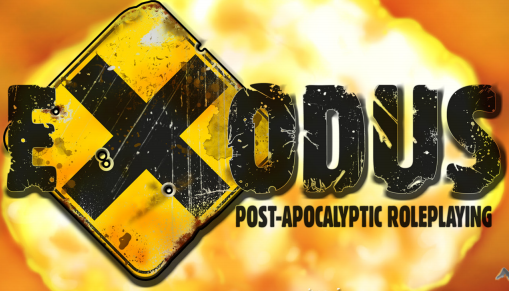
Vastly Belated Addendum: The Wasteland Bestiary
Welcome back to the land of Exodus! For those of you who don't recall what the hell this is and aren't in the mood to go read through all the original FATAL and Friends, let's have a quick rundown.
Exodus: Post-Apocalyptic Roleplaying was a d20 Modern-based roleplaying game setting from Glutton Creeper Games based around a world where a nuclear war sent the world to the brink of destruction. Two decades after the Great War, the apocalypse has ushered in a strange new era of savage raiders, strange mutants, and struggling survivors. The Wasteland is filled with merciless foes such as the giant green-skinned Trans-Genetic Mutants and drug-running Khans of Las Vegas and potential allies such as the legendary longcoat-clad Desert Rangers or the mighty Steel Disciples and their arsenal of energy weapons and power armor.
Sound familiar? It should, because Exodus: Post-Apocalyptic Roleplaying Game started out as an officially licensed Fallout roleplaying game. When the license changed hands between Interplay and Bethesda Studios, Glutton Creeper Games was out of the picture. Rather than let all they wrote go to waste, however, they went about scraping off as many specific Fallout labels as they could while leaving much of the underlying infrastructure intact. The result was a strange mixture of attempted original content for the sake of staying on the right side of the law stapled onto a mostly intact Fallout framework.
Exodus follows the sacred trinity of many d20 system games – Player's Handbook, DM's/GM's Guide, and Monster Manual – of which I originally covered two in a row. This post finally covers the third of these, a monster manual named the Wasteland Bestiary. The index lists sixty-three creatures (though this is somewhat misleading, given that it splits some separate creature subtypes into their own index entries but doesn't for others), many of which are unaltered real world animals, which is exactly why this is going to be just a single-post review before I head into what will most likely be the final Exodus book I'll go over for this thread.
Creature Overview
Just as the other two parts of the Exodus triumvirate act as if you have never seen a d20 system book in your life before, the Wasteland Bestiary starts out discussing how creature stat blocks work, creature types, and the like. The only thing that's really different is that the creature types have been changed somewhat. Elemental, Fey, Giant, Monstrous Humanoid, Outsider, and Undead aren't present and Magical Beast has been renamed Mutant Animal. There is also Radioactive Vermin, a slightly altered version of Magical Beast/Mutant Animal that adds the stereotypical Vermin traits on top of it.
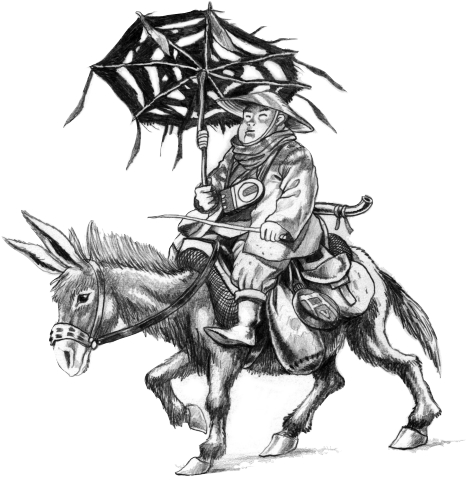
Non-Mutant Animals
Unlike Fallout, which seems to take the approach of "every piece of wildlife is mutated, even if it's just some gross tumors and scabs", the Wasteland Bestiary has a ton of just regular old animals]. The art sometimes suggests otherwise, but I'm going strictly by what the flavor text and stats are telling us. These all more or less come in one of two varieties: native North American wildlife or zoo animals, pets, and beasts of burden. In the former category we've got bats and vampire bats, grizzly bears and black bears, eagles, seagull flocks, owls, ravens, crocodiles ("the American crocodile is native to Mexico, so why not have them expand into California?"), cougars, desert lizards, octopi and giant octopi, porpoises, sharks, vipers, killer bees, mosquitos, spiders, and wolves, while in the latter there's boars, generic bovines, dromedary camels, dogs, donkeys, elephants, domestic cats, lions, tigers, hippopotami, horses, monitor lizards, ferrets, rats, gorillas and chimpanzees, monkeys, anacondas and pythons, and cobras.
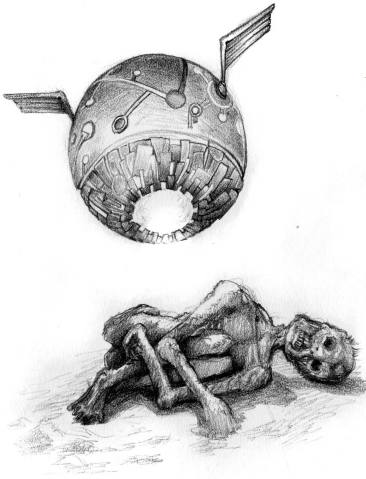
Monsters from the SRDs
If a creature in this bestiary isn't an animal or directly from Fallout, it's probably taken from either the Dungeons and Dragons SRD or the d20 Modern SRD. Not that the animals weren't mostly taken from there, but you get what I mean.
Alien Probe (CR 6 Small Construct)
Super fast and capable of creating nauseating doses of actinic light to scan interesting creatures, the alien probe was originally a reference to the "Foo Fighter" phenomenon of World War II when it appeared in the Alternity setting Dark*Matter and again in the d20 Modern Menace Manual. In the Exodus universe, though, they're weird data-collecting metal spheres that are probably some weird pre-War tech or something rather than alien devices, but nobody's sure.
Infester, Grub (CR 1/6 Fine Vermin) and Adult (CR 1/4 Diminutive Vermin)
Slightly shrunken from their d20 Modern incarnation and changed aesthetically from verminous lampreys to big angry ticks, infesters burrow into hosts that get a not too bad +2 to Strength and Constitution, but also -2 Wisdom and get a taste for raw flesh. Oh, and if the grubs gestate inside you, you get to make a save-or-die, and if you save you still take 6d6 damage and probably die anyway if you are still low level.
Giant Man-o'-War (CR 5 Large Animal)
A Portuguese man-o'-war, but bigger. The bell itself is cow-sized and represents the actual "this is the space you hit" part, but its tendrils expand outward in a 100 foot radius. The strands act as a ranged touch attack that forces a Fortitude save to avoid 3d6 rounds of paralysis, as well as a lasso for towing in the entangled target at 10 feet per round. 10 points of slashing damage severs a strand and releases the victim.
Sea Serpent (CR 7 Huge Animal)
Turns out sea serpents were real all along, they just never surfaced that often until the Great War disrupted the ocean's ecosystems. Now they go all-out and often appear on coastlines to attack ships or snatch beach-goers (because those apparently still exist). The d20 Modern sea serpent was originally of the Magical Beast creature type, which is why it has an ability that allows it to take a full round action to blur its outline for a number of rounds equal to its HD, gaining 20% miss chance of concealment and rendering all film and photographs of it blurry and useless. It makes less sense when they didn't even make it a Mutant Animal here.
Monstrous Flytrap (CR 8 Huge Plant)
Straight from the d20 Modern Core Rulebook's bestiary section is this strangely ambulatory giant Venus fly trap. Exodus has them crawling around the edges of nuclear waste dumps and fallout-heavy craters, eating up small animals and unfortunate humans. Any creature that is inside a monstrous flytrap's mouth suffers 1d6+13 damage a round, and for every 3 points it drains the flytrap heals a point of damage to itself.

Sasquatch (CR 2 Large Humanoid)
The sasquatch is probably the most altered of the d20 Modern pulls as far as mechanics go. Its type has been changed from Giant to Humanoid, a few of its ability scores have been slightly raised or lowered (most notably Intelligence from 6 up to 8), the ability to advance by class levels has been removed, and it's been given a new special attack called Dismemberment that lets it perform special grapple check at a -12 penalty to rip off the limb of a foe after doing damage equal to that character's Massive Damage Threshold. Fluff-wise, it's stated that sasquatch are the results of failed experiments in the creation of
Monstrous Spider (CR 1/2 Tiny Radioactive Vermin)
You know, it's always struck me as odd that there's never been a radspider in the Fallout series. You'd think that with all the giant scorpions, cockroaches, and ants running around, a big tarantula creeping about would fit right in. Oh well, no matter, we have one here. One that's only cat-sized, but it's here.
Yeti (CR 3 Large Humanoid)
Another creation of the secret government project that created the Trans-Genetic Mutants, yeti were meant to be arctic warfare specialists. Instead, they ended up colonizing the post-apocalyptic Rocky Mountains after escaping from the secret labs that created them. They live in mated pairs and aren't particularly picky about their food, eating pretty much anything from plants and insects up to deer and humans. As they're based on the Yeti from the d20 Menace Manual, they've got the Cold subtype and a Constrict attack that deals claw damage and 2d6 points of cold damage. Oddly enough, while Exodus buffed the sasquatch's Intelligence score from 6 to 8, they've dropped the yeti's from 8 to 6.
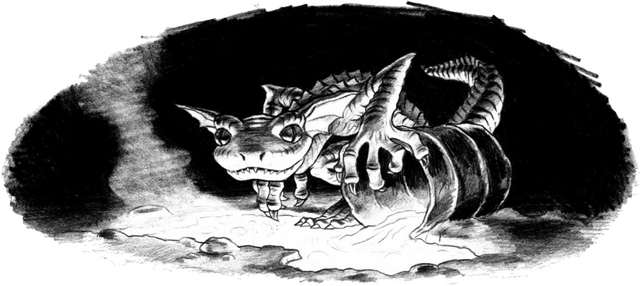
Fallout Foes
Fellows that seem likely to be based on a creature from Fallout or Project Van Buren, the original version of Fallout 3 that was planned out by Black Isle Studios before the transfer of the property to Bethesda.
Giant Ant, Worker (CR 1 Small Radioactive Vermin) and Soldier (CR 3 Medium-size Radioactive Vermin)
Your classic big mutant ants. Their jaws impart a number of RADs equal to how much bite damage they delivered.
Giant Cockroach (CR 0 Tiny Radioactive Vermin)
The giant cockroach was part of Fallout Tactics and intended to be in Van Buren, and has since persisted in the series under the alternate name of "radroach". As in the games, they're more or less early level fodder here, crawling around ruins and underground in large numbers. Exodus also gives us a larger and somewhat more dangerous version in the spitting cockroach (CR 2 Medium-size Vermin). Spitting cockroaches are aggressive enough to actively predate on other small animals and can spit globs of 2d6 damage acid.
Redwood Puma (CR 5 Large Animal)
Presumably based around the tiger-like cougars of Van Buren, redwood pumas are giant, thick-furred mutant mountain lions that are named after the redwood forests they inhabit.
Los Cruces Lizard (CR 3 Medium-size Mutant Animal)
A Fallout fire gecko by any other name would still be as recognizable, because seriously that art isn't even trying to disguise it. Named after the ruins of the Los Cruces, Arizona, where they breed in particularly large numbers, these large bipedal lizards feed on radioactive vermin, smaller reptiles, and even humans and livestock if they get a chance. They are capable of producing a "flaming belch", which is more or less a nonmagical 1/day casting of the Fireball spell, but they're worth killing as their tasty flesh can make about 50 steel coins worth of jerky.
Meatclaw (CR 13 Small Mutant Animal)
A mutant Jackson's three-horned chameleon that is called a meatclaw and referred to as "the deadliest terror of the radioactive wastes". Yeah, somehow I doubt shrinking its size will make it hard to guess what this thing comes from. It also has advancement up to size Large, so Glutton Creeper Games got to have its cake and eat it too. The meatclaw can open up with a free Intimidation check to force all foes that have never seen one before to be shaken for the rest of the encounter, go into a Barbarian rage, has an 18-20 critical threat range on their claws and deal triple rather than double damage on a critical hit from a claw attack, and keeps fighting unimpeded until you finally kill it rather than the normal effects of dropping into negative HP. It also has Strength 24 even at size Small, so good luck when you find a proper deathclaw-sized one.
Giant Rat (CR 1 Small Mutant Animal)
Wasteland Bestiary posted:
It was once thought that rodents of unusual size (ROUS) were just a legend used to frighten small children in stories. After the Exodus, evolution took place, with the help of radioactivity and toxic waste, the ROUS or commonly called "giant rats" appeared in the wasteland.
Giant Scorpion (CR 3 Medium Radioactive Vermin)
Your good old radscorpion. Amusingly enough, if you go to the entry on radscorpions on the Fallout Wiki, you can still see this book's art for them at the bottom of the page, still credited to "Fallout d20". Giant scorpions mostly eat other mutant vermin, but will defensively charge and sting at anything wandering too close. Like real scorpions, giant scorpion mothers carry their hatchlings on their backs.
Hydra (CR 2 Small Mutant Animal
A pit viper with two or more heads, possibly based on the two-headed rattlesnakes kept by the Vipers in Project Van Buren (no reason to give this game the benefit of the doubt on that matter). Not much to say about them, though, really. They are a viper with more than one bite attack. That's about it.
Monstrous Toad (CR 3 Medium Mutant Animal)
Big, grumpy toads that sometimes attack things that are probably too big for them to properly eat, which is honestly pretty accurate for more than a few species of frogs and toads. The big danger of fighting a monstrous toad is that it coats itself in poison when stressed, forcing a save against it on any melee attack. Failure means you suffer 1d3 Wisdom damage and wildly hallucinate.
Original Creations
Yes, there are in fact a few creatures in here that don't seem to be from any SRD or related to a Fallout monster.
Bloodfly Swarm (CR 2 Fine Radioactive Vermin Swarm)
Mutant houseflies, bloodflies swarm together in massive groups that gather around stagnant water. They can be seen around anything from lakes to abandoned swimming pools as long as the weather is warm; cold temperatures send them into hibernation. As the name implies, bloodflies suck blood, which in this case just means an extra point of damage on their swarm attack rather than the more typical "suck blood, heal HP" mechanic.
Giant Lizard (CR 1 Small Animal)
A dog-sized Gila monster that doesn't get the Mutant Animal creature type even though it's explicitly created by radiation exposure. It can get up to size Gargantuan, presumably so that you can homage the classic 50s B movie The Giant Gila Monster.
Fungal Mass (CR 4 Huge Plant)
A gross blob of white fungal polyps and tendrils found hanging on walls in damp, moist air conditions. While the fungal mass is unable to go anywhere, it can deal 2d6 damage by slapping its tendrils around and any damage done to the fungal mass causes it to shit out spores in a 15 foot radius. If you're in that radius, you've got to make a DC 12 Will save or take 1d4 Wisdom damage. The combination of no move speed, the likelihood of it hiding from sight being fairly slim, and a spray of spores in a small radius any time you damage it at all, it seems like the obvious thing to do about a fungal mass is pick it off at range.
Snapper Plant (CR ¼ Small Plant)
Sort of like an angry rose bush, the snapper plant is another carnivorous plant. Its thorny tentacle-vines are used to deal a point of Constitution damage each full round it stays attached to a foe. It also has poisonous spores that can be expeled in a 20 foot radius, focing a Fortitude save to avoid 1d3 rounds of paralysis, 1d4 damage, and a point of Constitution damage. While snapper plants have no move speed, they're presumably more capable of actually hiding and surprising a foe than the fungal mass.
Spore Plant (CR ½ Medium Plant)
A larger version of the snapper plant that has stubbier vines that act as clubs and can't drain blood, as well as a weird thorn-mouth it can use to bite foes. Its version of poisonous spores doesn't deal direct HP damage or paralysis, instead dealing 1d4 Strength and Constitution damage, and can only use its spores a number of times per day equal to three times its HD.
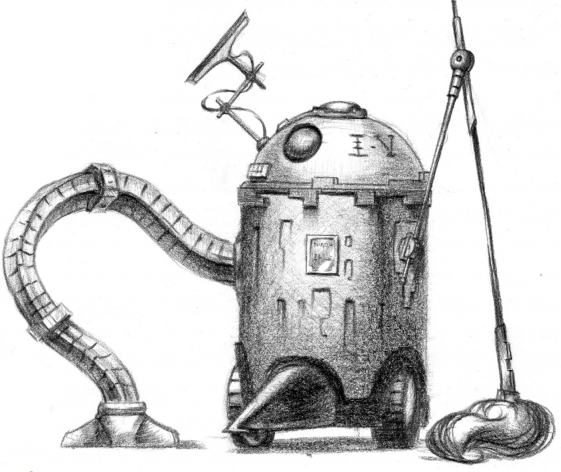
Generic Robots, Medium (CR 2) and Small (CR 0)
Similar to how animated objects were treated in Pathfinder, robots of Exodus are given two basic stat blocks with optional features you can add on. All of them have null stats in everything except Strength and Dexterity, a hardness of 5 like an object, a specific move speed based on whether they have treads, two legs, four legs, or wheels, and the ability to be programmed with a few skill points and a feat by someone with the Techie advanced class. Two robots with this framework are presented, both of Medium size and focused on the home: domestobots (the R2 unit-looking fellow above) are household and industrial cleaning robots, while handibots are humanoid robots that act as repair and maintenance units.
Combat Drones
Buffer robots with more HP, better stats, and weaponry, though they also have hardness (5 for the two assault drones and 10 for the military battle drone) and programmable skills and feats of the generic robots. Three varieties exist.
- Police Assault Drone (CR 4 Medium Construct): Basically a torso and arms attached to tank treads, police assault drones built en masse by pre-War roboticists to act as enforcers and breach A police assault drone is outfitted with a shotgun, searchlight, and remote control system that allows an operator to command it, as well as feats and skills that help it destroy both obstacles and enemies.
- Military Assault Drone (CR 7 Large Construct): Big, vaguely spider-like robots with four arms and four legs. They are pretty terrifying, with two of their arms ending in laser cannons that can be combined into a special "charge cannon" attack that deals 4d10 damage to anyone in a 20 foot line as a full round action, the other two arms being equipped with reinforced shields that can be used to smash foes in melee or give it an extra +4 defense at the expense of only being able to make a single laser cannon attack or move action per round, and "Van Der Wall pads" that allow it to climb on walls and ceilings. Fortunately, they are rigidly forced into programming that keeps them on patrol of military bases and stockpiles, so unless you are trying to raid one it's unlikely you'd ever get in a fight with one.
- Military Battle Drone (CR 14 Huge Construct): An even larger arachnid robot built to resemble a shimmering white scorpion, the military battle drone has a pulsar beam on the end of its tail, two pneumatic pincers, and a back-mounted plasma grenade launcher. Unfortunately, while more rare than military assault drones, battle drones are also sadistic and enjoy hunting down, torturing, and killing sapient beings because the central AI that controls them busted and went haywire during the Great War.
Nanomachine Swarm (CR 4 Fine Construct Swarm)
Swarms of recycler nanites that were let loose by the apocalypse, nanomachine swarms consume buildings and machinery to repair the factories that created them in order to create more nanomachine swarms. This wouldn't be a bad thing if they didn't also mulch organic matter that isn't smart enough to get out of the way, dealing 2d6 untyped damage a round to anything in their cloud. Most nanomachine swarms end up "dying" thanks to their power cells running dry, so there's no worry of a Gray Goo scenario or anything, but enough manage to collect material and return to their factories to keep making more.
Wastemoth Swarm (CR 0 Fine Vermin Swarm)
Tiny little moths. Not too scary, right? Well, these tiny little moths scatter radioactive dust with their wingbeats, dealing 3d6 RADs to anyone sharing their square.
Exodus: Texas
Original SA post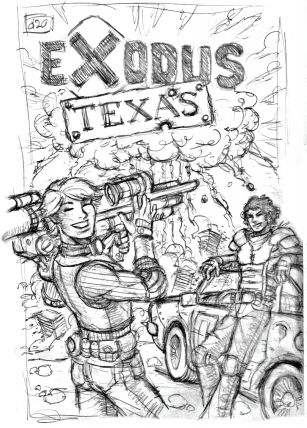
After the publication of Fallout d20 under the somewhat revised copyright-skirting incarnation that was Exodus: Post-Apocalyptic Roleplaying, Glutton Creeper Games seemed to just sort of stop producing anything whatsoever. The most likely answer to why is that they were bleeding themselves dry thanks to a lawsuit against Interplay that lasted from 2007 to 2009 being almost immediately followed by another claim that lasted until 2013. While GCG won that second legal battle, it was apparently a case of too little too late, as the company ended up being bought by 4 Hour Games.
In between the dawn of Exodus and its rebirth under a new company, however, there was Exodus: Texas. This humble forty-nine page (counting the sketch cover) title came out in 2012, the waning years of Glutton Creeper Games, and had to contend with both that and no longer having a pre-written Fallout manuscript framework to build on. The next couple of posts will be looking at how that turned out.

Introduction
Texas is a special place in the world of Exodus. While the Great War of 2012 brought China to the West Coast and Iran to the East Coast, it took a while for any of the bombs or fallout to hit Texas. Furthermore, a bunch of survivalists and secession-obsessed nationalists had bunkers or hideout caves that allowed larger groups of non-Vault folks to survive. All these folksy salt of the earth blue collar survivors were, the book states, "the wrong people to try and rebuild a nation, but the right people to survive in the Wasteland". This has allowed Texas to survive and thrive as a link between the two halves of the American continent in the three decades that have passed since the Great War.
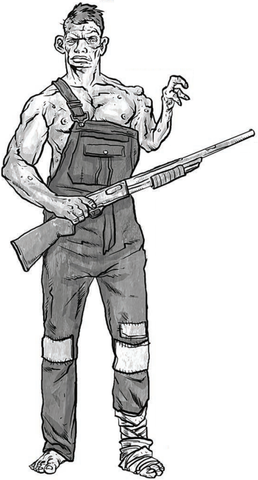
Chapter 1: Character Options
Races
All of the mutant races presented in the Exodus core triad are either almost or entirely nonexistent in Texas. There are tiny communities of ghuls, and the Mutant Army will on rare occasions clash with Texans, but symbiotic mutants and dregs are too tied to the totally-not-FEV projects that only really caught on in California and Nevada to be present and all of the Bio-Genetic Mutants are holed up in Utah. Instead of those guys, we have a new type of mutant, the craven, represented in art by that handsome fellow you see up above the chapter header. The craven are deformed mutant rednecks that live up in the hill country of west Texas. Unsurprisingly, they're known for being dumb, violent, and cannibalistic. The text simultaneously implies that they are the result of not hiding in proper fallout shelters but also relatively rare, so I can only assume that the majority of the crazy survivalists who hid out in caves and their improvised radiation bunkers somehow got lucky and only a handful of them were unfortunate enough to turn into cravens. The whole "actively hunt and kill people" thing means that very few cravens are found in normal society.
Mechanically, cravens get +1 Strength and +2 Constitution but -3 Intelligence, the bonus feat all humans get, immunity to radiation, a +2 to Fortitude saves, -4 to Charisma-based skill checks and Disguise checks unless they can pass of their mutation as normal, and a free bonus skill chosen from a set of skills typically associated with woodsy outdoor types. All cravens start out illiterate and must spend triple the normal skill points to learn a written language, as well as double the normal skill points to learn any spoken language other than the one they start with. Cravens also have to spend one of their starting Traits on one of the following mutations:
- Blob: The craven has a mutation that makes them a level beyond morbidly obese, a titanic flesh pillar that gains starts with four times the average weight of a human starting character and gets a further 50 pounds heavier every year. They are strong but slow, getting a +4 to Strength but -2 to Dexterity, 20 move speed, and an inability to gain any benefit that increases their move speed. A blob also gets a slam attack with their body fat that deals 1d6 damage per 200 pounds they weigh. Blobs are the only cravens that innately get to pass as human, and thus avoid the -4 to Disguise and Charisma-based skill checks mentioned above.
- Bugged-Out Eyeballs: A craven with eyes three times as big as a normal human. This grants a +4 to Spot and Search checks.
- Cyclops: In the opposite direction, this is a craven with a lone eye. These mutants get +8 to Search and Spot checks in a direct line of sight, but anyone in their missing peripheral vision gets a +2 to attacking them.
- Elephant Ears: Huge ears instead of huge eyes. +8 to Listen checks.
- Hairy Gent: A craven with hypertrichosis. This somehow makes Animals and Mutant Animals not attack them unless provoked and grant the Animal Affinity feat, but on the downside they have to shave around their hands and sensory organs at least once daily or suffer a cumulative -1 penalty to rolls related to the unshaven body parts. Going further and shaving every corner of their body daily allows them to pass as human.
- Hunchback: Pretty self-explanatory. The spinal deformity gives a -10 to movement speed but a +1 to Strength and Constitution and Strong Back as a bonus feat.
- Kuato Syndrome: The deformed baby-like head and arms of a parasitic twin juts from the craven's chest, laying dormant 98% of the time. At the GM's discretion, it engages in one of its rare awakenings, dealing 1d3 Intelligence damage to the craven host and stunning them for 1d4 rounds. In those rounds, the twin speaks prophecy that reaches anyone who can hear it in a 60 foot radius, granting them a +2 to all d20 rolls for 1d4 hours. A DC 20 Fortitude save is allowed to keep the twin dormant, and it can only attempt to awaken once in a 72 hour period.
- Lumpy: This poor craven is coated in hard baseball-sized tumors that ooze pus if struck. This tumor armor grants a +6 to Intimidate checks and 2 physical damage resistance, and any time they're struck with a melee attack the slick pus creates a ten minute period where the craven has a +6 to Escape Artist checks and all foes suffer a -6 to grapple checks against the craven.
- T. Rex Syndrome: Tiny arms, meaty legs. The craven gets an extra 20 feet to their move speed and +2 to kicking attacks but is treated as a size category smaller for what they can carry in their hands and suffers a -4 to Dexterity and Strength-based abilities and skill checks that require arms or hands.
Not to put too fine a point on it, but this seems like a really bad idea for a race meant to be used by players. As an NPC race they're fine, but I can't imagine wanting to play a horrific predatory cannibal redneck with a severe Intelligence penalty. This isn't a case like the Trans-Genetic Mutants where you have your Marcuses and Fawkeses and the like to look to; hell, the book even states that cravens only integrate into society if their whole clan is wiped out, and even then if they do so they tend to skulk around being deceptive and sneaky and all that jazz.
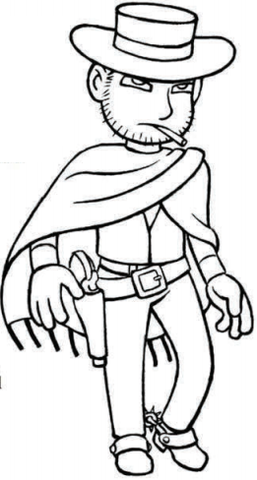
Backgrounds and Occupations
Exodus: Texas has five new backgrounds and four new occupations for characters to have. On the backgrounds end, you can be a cultist of the Holy Friars of the Refinery or the Monks of Chuck Norris Walker, a first-class ("National") or second-class ("Provincial") citizen of the reborn post-apocalyptic Texan nation, or the child of a Desert Ranger, while the occupations list is made up of Cowboy, Gambler, Prospector, and Politician. All of the occupations are pretty self-explanatory and the cults and citizenry of the Lone Star Nation are given more detail in the fifth chapter, so let's move right along.
Chapter 2: Skills
A lone page makes up this chapter, and it is made up of two new uses of old skills: using Survival to prospect for precious minerals and the difficulties of using Repair on "black box tech”. BBT is technology that has had all knowledge of how it works lost, which I was thinking about complaining about given that there's only been thirty years from the Great War to the present before I thought about the excuse that there's always military technology and stuff like that.
Chapter 3: Feats
A whopping two pages for this chapter compared to the one of the last. Not that I'm complaining about having to look at less skills and feats, mind you, I'm just curious why these weren't rolled into being parts of the first chapter or something. There are nine in total, most of which are either an advancement of an existing feat or some sort of new maneuver for the Handle Animal skill. They also have the patented Exodus humor attempts and references...
"Hogtie" Feat posted:
Down on the ranch, those good ole boys sure know how to tie something up and make it squeal like a pig. After getting some firsthand lessons, now so do you.
"Jockey" Feat posted:
A Wasteland Dwarf has taught you the forgotten pastime of the small human, Horseracing. Now you know how to kick that mule in the right spot to haul ass.
"Mule" Feat posted:
Working for the scavenger Sanford and his son as a mule pulling his broke down red pickup truck has paid off. Now you can carry even more Wasteland junk.
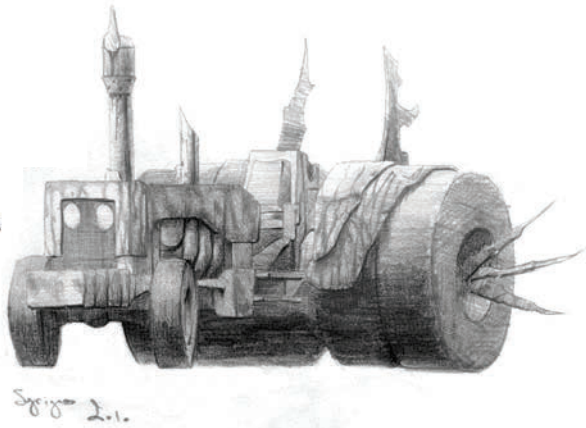
Chapter 4: Equipment
Three pages of equipment, consisting of one new weapon (a grenade made in a jar of salsa, which seems confusingly arbitrarily), a cowboy hat and matching outfit, gasoline (Texas never accepted the whole fusion technology thing the rest of the nation did), and several vehicles. While two of the vehicles are a generic pick-up truck and a generic tractor, the last is a brand name: the 69 Dodge Charger, specifically. This is so the text can state that post-apocalyptic Texans paint their Chargers orange with numbers on the side and a flag on the top. Because Dukes of Hazzard, you see.

Next Time: Now that we've hit out the crunchy part of the book, we've got organizations, classes, and settlements in the other half.
Exodus: Texas
Original SA post
Chapter 5: Organizations and Advanced Classes
At this point, it seems that the writer of Exodus: Texas had realized that most advanced classes in Exodus were linked to organizations anyway, and dropped the pretense of having some that were general purpose entirely. The only new advanced classes are the organization-based ones we see in this chapter.
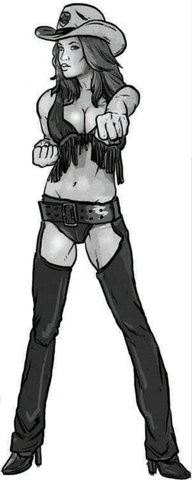
Monks of the Church of Chuck Norris Walker
Yep, we're going there. The Monks have their origins in a minister named Edward Johnson whose faith was shaken by the apocalypse, only to be renewed when he found a book by "a pre-Exodus martial arts instructor and action movie star which spoke of simple, fundamental faith in conservative and religious principles"; I don't know which of Norris's books this is most likely to be, and honestly I don't want to. Johnson uplifted Chuch Norris as "Norris the Divine", a sort of conservative Christian Buddha who acts as an enlightened figure who all adherents aspire to yet is not a true deity. One of Johnson's followers, a pop culture collector named Robert Ricky, then used Chuck Norris memes and episodes of Walker: Texas Ranger to inspire a second incarnation of Norris the divine known as Walker the Ranger. Ricky and his adherents claimed that following Norris the Divine's tenets was not enough on its own, and that one must follow the example of Walker the Ranger and be proactive in the wasteland. This dual-natured enlightened one soon became a triune figure after a martial artist of Chuck Do (the book's renaming of the real Norris-created martial art of Chun Kuk Do) came into the fold and presented the martial art' founder as yet a third aspect, Chuck the Man. Thus the Church of Norris the Divine became the Monks of Chuck Norris Walker and set out to engage in martial arts justice across Texas.
The monks of the order live a humble existence in a settlement known as Corpus Norris (what was Corpus Christi in the pre-apocalyptic times two decades ago), led by five black belt members of the order that act both as high priests and the settlement's judicial system. While they do have plentiful food thanks to Lake Corpus Christi being pristine and lively compared to the blighted ocean, other supplies are mainly gained through trade or services: namely, hiring out monks as bodyguards to places such as the refineries in Houston in exchange for their goods. While visitors can be of any faith and simply need to behave themselves, permanent residents of Corpus Norris must convert to the ways of Chuck Norris Walker. The largest problem the monks have is within rather than without, as a schism is brewing thanks to a black belt named Kai Cobra who believe that the monks should abandon their traditional ways as hired bodyguards for the forces of good only and instead become mercenaries for anyone with the coin to pay for them.
The unique advanced class for the monks is Chuck Do Student, a ten level martially focused class. It's basically just a better version of the Martial Artist from the d20 Modern Core Rulebook and Exodus Player's Guide, having pretty much all the features of that class plus some extra bonuses such as allowing their Intimidate checks to potentially stun a foe for a round at level 3 of the class and a special attack called the Roundhouse Kick. Make a Roundhouse Kick unarmed attack, get maximum critical hit damage you can deal without needing to make a damage roll in the first place. This is a 1/day ability at level 7 of the class and 2/day at level 10.
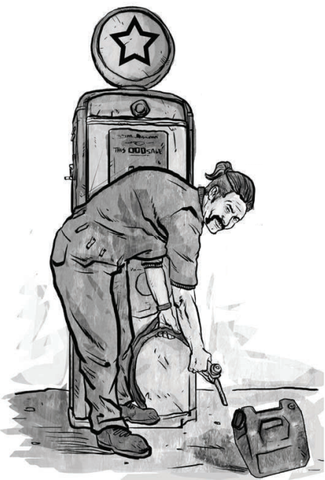
Holy Friars of the Refinery
In the world of Exodus, the Deepwater Horizon spill was the final nail in the coffin for the oil industry, as unlike in real life there was fusion cell technology waiting in the wings and the government was able to slide that out en masse. Luckily for the post-apocalyptic world to come, some facilities in Houston, Texas, were kept active to create gasoline-based products that weren't oil, and the city managed to survive. This allowed Houston to provide a critical service in a world where fusion cells were no longer being produced and older pre-fusion vehicles were coming back into service. Workers continued to work on the great refinery in the city, rote memorization without understanding of the greater concepts behind how the chemical processes being performed worked eventually transforming into a religious reverence of the process of making oil from gasoline:
Exodus Texas posted:
The Friars are aware that sometime in the distant past the Refinery was operated by technical know-how rather than religious ritual, but that time is long past and they no longer seek it.
The Friars' main refinery is the Refinery in Houston, though they also have facilities in Dallas, San Antonio, El Paso, and around various derricks in the middle of nowhere. They have no allegiance to any one organization in Texas, offering their precious gas to the Lone Star Nation, Knights of the Alamo, Desert Rangers, Monks of Chuck Norris Walker, and NEMO in exchange for soldiers to protect their refineries and trade routes. Their current leader, Abbot Costello, is a jovial man who some feel is way too frivolous but has nonetheless kept everything running smoothly.
Holy Friar of the Refinery is the new advanced class unique to members of this organization. For spending ten levels in it, you get average BAB, high Reflex and Will save progression, good Defense progression, and poor Fortitude progression combined with class features focused mostly on buffing rolls for Computer Use, Craft (a fair amount of different ones), Disable Device, Knowledge (Technology), and Repair. There's a few outliers in certain levels, like getting a bonus to Survival checks for prospecting at level 5 and 10 or an aura of pacifism that forces any creature attempting to attack a Holy Friar when there is another target available to make a Will save of DC 10 + the Holy Friar's level in the advanced class to actually carry out the attack.
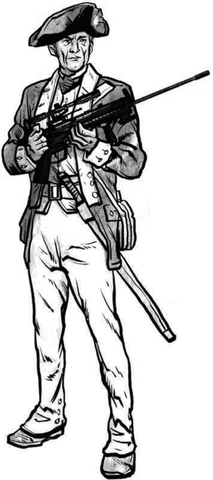
The Lone Star Nation
Imagine if Texas somehow went even more red state than it is in reality, and you have the Lone Star Nation. This new Texan empire began in Dallas and expanded through annexation to an area defined by what settlements lie on its borders, the ones listed being the Texan cities of Abilene, Amarillo, Austin, Huntsville, and Lubbock, Oklahoma City in Oklahoma, and Shreveport in Louisiana. Its presidents (technically just feudal kings, but it never hurts to use patriotic buzzwords if you are trying to keep power) have spoken of the old America as a nation that was once great but fell to decadence, secularism, and immorality. They say the Great War's two major participants were no coincidence, Iran being the symbol of the Muslim savage and China of the atheist heathen, both sent by God to punish a nation that had turned away from him. Hank Tree Sr., the first president of the Lone Star Nation, made sure his vision would be adhered to by slaughtering the "apostates" in the vault his family was stored in, using his charisma to further rile up the remaining fanatics, and burn the settlers that had already been in Dallas before their arrival at the stake in what he claimed was a ritual of consecration.
The family dynasty has since passed from Hank Tree Sr. to his son Hank Tree Jr., and then on to his son Michael Shepherd. President Shepherd acts as the king over various fiefdoms ruled by lords referred to as Senators. Below them, there are three types of civilian populace. First you have the citizen class, which are free men and women who pay exorbitant taxes but otherwise still hold basic human rights. Below them are the provincial class, who are basically serfs. Then, at the bottom, there are slaves made up of "heathens, infidels, foreigners, criminals, and debtors". Ghuls and mutants are considered to be abominations cursed by God, and are not allowed to be citizens. The violent first encounters between the Lone Star Nation and the Mutant Army means all non-ghul mutated humans are immediately seen as spies that can't be trusted. Visitors from outside of the Lone Star Nation are subject to Papers, Please levels of border scrutiny and documentation, as well as privacy invasions that are frequent and without warning.
The Lone Star Nation's advanced class is the Minuteman. They're a class with full Base Attack Bonus progression, great Fortitude and Defense progression, and poor Reflex and Will progression. In spite of the whole American Revolution getup they have in the art seen above, a level 1 Minuteman gets free combat armor and cowboy hat that acts as their Minuteman uniform, as well as a scoped FN-FAL. This uniform grants them recognizability and, at level 2, a +5 bonus to all social skils in the Lone Star Nation that drops to a +5 to Intimidate checks in any of the rest of Texas or against foes that have heard of the Lone Star Nation's prowess. They can also combo melee and ranged attacks in a full attack as long as they are using a rifle or shotgun, have 10% less overland travel time due to forced marches, get a free attack of opportunity against any charging foe, get a special attack (1/day at level 7 and 2/day at level 10) that treats a shotgun or rifle attack as a ranged touch attack, and can both get in or out of armor in half the usual time and sheathe or reload a weapon as a free action once per round.
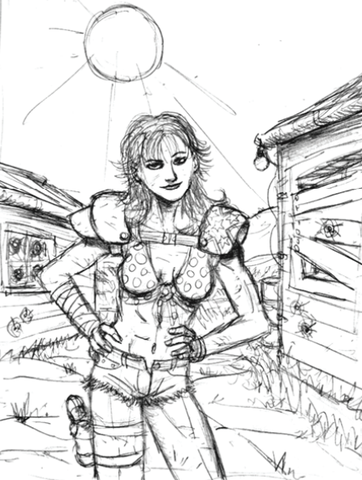
The Order of the Alamo
San Antonio was the only city in Texas that got hit by strikes during the Great War as hard as those on the coasts. The Alamo, in spite of being a very old building, miraculously survived all the destruction and became a rallying point yet again as the city rebuilt itself. The massive fallout somehow didn't stay around or pollute the rivers and aquifers around the city either, which allowed San Antonio to become a huge trade hub between the cities to the west and the east. The Order of the Alamo is the defensive military that protects San Antonio's wealth from threats such as wandering raiders, the Mutant Army, and the Lone Star Nation. The ranks within the Order are page, squire, and knight, and grand master of the Order. And...that's about it. They aren't particularly hard to sum up.
The unique advanced class for the Order of the Alamo is the Knight Errant, a wandering warrior who goes out into the wilderness to right wrongs and protect the innocent rather than stay in San Antonio to defend it like most members of the Order do. It's pretty much a variant of the Disciple Knight advanced class, just with an allegiance to the Order of the Alamo rather than the Steel Disciples. It even gets free power armor too, making it the only easy way for a non-Disciple to do so.
Existing Organizations
Some of the organizations from the Exodus core triad are in Texas too. Here they are.
- Desert Rangers: Texas is the bulwark for the Desert Rangers' campaign against NEMO.
- The Savior's Army: They have two outposts in Texas, one in El Paso and one in Dallas.
- NEMO: Juarez is the furthest north the slavers of NEMO have gotten a foothold. From there, they wage bloody war with the Desert Rangers stationed in El Paso. They also sell slaves to the Lone Star Nation and hire out mercenaries to the Friars of the Holy Refinery in exchange for gasoline.
- Tribals: There are six tribes in Texas that call themselves the Comanche. None of them are, in fact, actual Comanche, and are literally stated to use a Hollywood stereotype version of the Comanche as their basis for living, dressing, and acting.

Chapter 6: Settlements
Corpus Norris
A settlement with a population of fifty Monks of Chuck Norris Walker. Unsurprisingly, there's not much to say about what is basically a dojo with a fish pond out back. There's also a temple with a VCR player in it that has a few copies of Walker: Texas Ranger available for worshipers to view.
Dallas
Dallas is the city that Hank Tree Sr. claimed the angel Gabriel showed him in a vision, declaring it the new promised land. The rest, as they say, is history, and it is now the seat of the president of the Lone Star Nation. The city's three hundred citizens and six hundred provincials live constantly surrounded by the Minutemen, who harass and threaten provincials constantly to keep them in a state of perpetual fear that President Shepherd claims is why Dallas has such a low crime rate. There are two hundred Minutemen foot soldiers and two motorized regiments stationed on a base near Mountain Creek Lake, allowing for swift deployment of overwhelming force in the case of any attack in the Lone Star Nation's territory. The vicious treatment of outsiders by Lone Star Nation officials means that almost all trade involves LSN-sanctioned caravans that export goods from the nation in exchange for imports of things that are hard to find within its borders. The quietest and most revered place in the city is Dealey Plaza, where it is said that one can receive divine guidance if you brave the ruins of the six-story Schoolbook Depository.
El Paso and Juarez
Cut through by the radiation-drenched Rio Grande, the twin cities of El Paso and Juarez are referred to as "the gateway to the Southwest Wasteland". El Paso would probably be the most prosperous city in the Texas Wasteland, too, were it not for that whole issue of it and Juarez being entrenched in constant violence between the Desert Rangers and NEMO. The only place where there is no violence at all is the stretch of I-10 due to neither side wanting to anger the Friars of the Holy Refinery, and even then most people would rather go a bit farther to avoid danger than spend even a day in El Paso. The five hundred people who live there anyway are well-armed, well-armored, and paranoid out of necessity.
Houston
This city built on big oil is the final stop on the east-bound length of I-10, which culminates in a grand bazaar set up along the highway in George Bush Park. The big attraction is the black gold of the Refinery, of course, and the city's five hundred strong population benefits greatly from its presence.
San Antonio
The home base for the Order of the Alamo's hundred-strong army and four hundred other citizens, San Antonio is well-defended and has pure ground water and rock wells that allow it to survive and even thrive in the sweltering west Texas heat. It also has a big presence in the trade circuits in spite of boycotts in NEMO and Lone Star Nation territories. The San Antonio Salsa Company – which is a weapons plant now, don't let the name fool you – in particular makes a hefty profit from selling weapons to people all across west Texas and resistance fighters in the LSN.
Next Time in Exodus: So that's Exodus: Texas capped and done with. But what does it all mean? I'll be bloviating meaninglessly about just that in the seal on the Exodus coffin.
Final Thoughts
Original SA post
Part the Last: Final Thoughts
Here ends the tale of Exodus: Post-Apocalyptic Roleplaying. At this final step, I want to step back and give my brief earnest (if not necessarily deep) opinions on what Exodus changed and what stayed the same, for good and for ill. It was a bit hard to write this, because when I first started this set of overviews several years back, I had went into it with a full "gawk at the spectacle" carnie mentality, and never planned to actually think about it. How times change, eh?
An Altered Apocalypse: The Two Big Attempted Transformations of Exodus
Perhaps the most profound of all the changes Exodus made from its original draft as Fallout d20 was its timeline of the end of the world. In Fallout, the Great War beset a future America of the year 2077, and the first game takes place a hefty eight decades later; Exodus crunches this into the Great War of 2012 and the vaults opening a mere twenty years later. The opposition in the Great War is changed from Red China alone in Fallout to a conjoined force of China and Iran, perhaps not so subtly reflecting on the fact that Exodus was a product of the Bush years. In concept, this could have been a way for Exodus to truly differentiate itself as its own post-apocalyptic setting, free and unfettered from the license it no longer held. In practice, we ended up getting the Fallout world of fusion cars, laser weapons, power armor, secret experiments to create giant green mutants, and a society simultaneously nostalgic for the past yet distant enough from it to only create an effigy of it, all squeezed into what is effectively our world.
I'm not a huge purist when it comes to alternate weird history shit. Hell, urban fantasy's one of my favorite genres and GURPS Technomancer is my favorite book I've covered for this thread so far. Where it becomes a problem is that the original core triad of Exodus titles can't escape the fact that they are a few streaks of paint haphazardly thrown over the still very recognizable Fallout framework. Two decades are still treated as if they were nearly a century, and the events of the end of the Cold War, 9/11, and the invasion of Iraq don't really change the Fallout-based "better dead than Red" nature of propaganda and society. I almost wish I could have found a way to read this series of books before I even knew about the Fallout series, just to see it from a totally objective point of view, but as things are everything about it just stick out like a sore thumb.
The other big change was that a lot of the pop culture nostalgia and retrofuturism in the world of Exodus has been moved forward to the 80s. You have the idolization of Walker: Texas Ranger and Dukes of Hazzard by the natives of Texas, most drawn characters looking like they shopped at either the Mad Max emporium or the nearby 80s action movie retail outlet. The only places where the early Cold War aesthetic is at the fore are in the propaganda, sales ads, the cars (I guess because big bubbles and tailfins are more fun to draw than sports cars), and art pieces that were probably commissioned back when Exodus was still officially licensed as Fallout d20.
And, of course, in between these two are various minor changes such as adding a few more mutants and the valiant effort of Exodus: Texas to be a free bird. It is what it is.
My Suggestions for a Freer Exodus
So, what exactly do we do with these observations, combined with the observations we've had about all Exodus kept the same? Through my prestigious credentials of being some nobody on the internet, here's a few of the ways I feel Exodus could have managed to reach escape velocity of its product license planet of origin.
- Remove or Revise the Steel Disciples: While it's not necessary to remove every whiff of Fallout from Exodus, it probably wouldn't hurt to knock out a few of the most overt organizations. And if there was any organization I'd put first in line for the chopping block, it would be these fuckers. Both of their roles that aren't "be Literally the Brotherhood of Steel" are better served by other organizations: you've got the Desert Rangers for the designated allies, and you've got the Techno-Reapers for the weird technophiles gathering shit they feel the proles aren't smart enough to handle. Alternatively, keep the Steel Disciples, but at least make it so that their organization ranks aren't the same names and types as those of the BoS, and give them some sort of differing motivation. Maybe double down on their origin in the American military, have their terminology and social stratigraphy be based on that of the Army or something like that. Maybe have their "we keep tech away from you for your own good" attitude inherited from the Brotherhood be augmented with or replaced by some good old-fashioned jingoism.
- Same for the Tribal Nation: Why must they hold their sacred rituals in giant pyramid-shaped casinos? Why? Why?
- Embrace the New Millennium: We know that Exodus is a world where 9/11 and the War on Terror happened. That kind of shit changes things. It might have been interesting if they had updated the Cold War thematics for one based on this. ...On the other hand, we have the weird and kinda racist coding of the advanced class for the Children of Atom-alikes, so maybe putting that kind of weight in the hands of the writers of Exodus wouldn't have worked.
- Leave the Wild West: This one would obviously be the one that would have taken the most sheer effort, but it might have done Exodus some good to dust off its boots and go to somewhere else in the United States besides the American Southwest.
- Go Hog Wild With Mutants: Outside of the ghuls and Trans-Genetic Mutants, Exodus gave us the Super Mutant version of half-orcs, government-created furries, the "ghouls but they have to be soldiers by nature" dregs, and inbred deformed hillbilly cannibals. My suggestion? More mutants. Create a bevy of weird subspecies that pop culture radiation spat out across the nation. Maybe even use d20 Future's random mutation system, or the one from Darwin's World, or the one from any other number of d20 Modern titles that have mutation systems that could be cribbed from. Hell, they could have made their own if they really felt like it. Just go for it!
What Story Does Exodus Tell?
Exodus: Post-Apocalyptic Roleplaying is a story of adapt-or-die on a small corporate scale. Fallout d20 was Glutton Creeper Games, so I can empathize with the fact that they decided salvaging the nearly complete script for it was the best way to survive. Still, the end result was merely a slow death rather than a more immediate one. Can this just be written off as just another case of the d20 bubble that hobbled to its death later than the others? I'm not really sure; groups like Chris Fields's Skorched Urf Studios kept trucking along well into the 2010s with d20 Modern shovelware, after all. My suspicion would have to fall on a combination of no backup plans for settings besides Fallout d20/Exodus and a death from the thousand cuts of two prolonged legal battles with Interplay.
Perhaps more importantly than why Exodus died, however, is the question of "did it deserve to die?". My perhaps shocking answer would have to be no. On top of all the ways it could have innovated at the starting gate, the person writing Exodus: Texas seemed to have some genuine passion for his project and a desire to move away from the Fallout shell he had originally been tethered to, looking like he truly wished to create something more than just a serial number filing job. Were it not for the financial troubles that beset Glutton Creeper Games, Exodus truly could have been something. Would that something have been perfect? No, certainly not. But I would have loved to have seen the author/s who took it as a passionate project go for the gold and continue to find their footing in something that wasn't just the decaying husk of Fallout d20.
Ultimately, we'll never know how that would have gone, ignoring the possibility of 4 Hour Games continuing to expand on the license they bought out. Thus our saga ends here: a domain of broken dreams.